August 21 - 27, 2016: Issue 277
Sir Edward John Lees Hallstrom
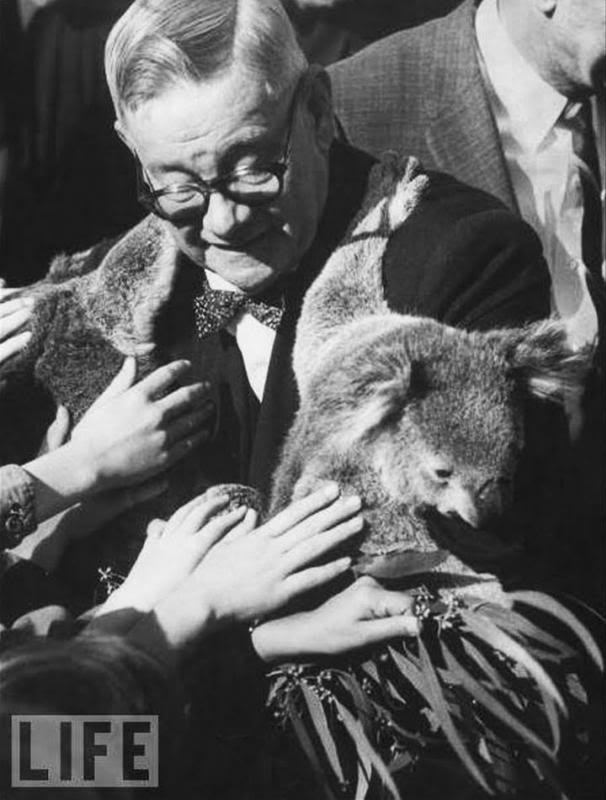
Sir Edward John Lees Hallstrom
25 September 1886- 27 February 1970
Known for having a sense of humour which grew as he matured, for having a love of food and inventions, Edward Hallstrom was most well known for his love of his birds, all other animals and spending huge sums on promoting health, particularly on TB, heart and Cancer research. He spoke during a few interviews of suffering from Bronchitis form an early age, while family members while he grew up and his wife's family members 'suffered from long illnesses' prior to passing away.
From an early age and throughout his career and long afterwards he would personally attend to the sick and injured native animals, had his own personal aviary at his main home at Willoughby and did his utmost to save koalas in Pittwater, setting up a privately funded koala sanctuary at Bayview, a Flora and Fauna sanctuary that lasted until shortly before he passed away and the land was sold to become what we now know as Bayview Gardens, a retirement village
His presence in our area can be first seen as being one of those brave souls taking a turn at being airborne at Narrabeen when he, along with George Augustine Taylor and Florence Mary Taylor, took turns to fly in a biplane glider.
See: First To Fly In Australia, Sunday December 5th, 1909 and The House at The End of the Road (Billabong and Ocean House: Charles and Emma Schulz and D H Lawrence).
He then reappears associated with Pittwater through these items in the early 1940's:
Factory Staff Nursing Injured Koala
SYDNEY. — A koala, which has both legs and its left paw fractured, is being nursed 24 hours a day at Hallstrom's refrigerator factory, Willoughby. The governing director of the firm (Mr. Edward J. L. Hallstrom), the factory nurse (Sister E. Harris), and members of the staff take turns at caring for it. The bear is kept in an annexe to Mr. Hallstrom's office, strapped to a specially built stand. Both legs, are encased in plaster. Mr. Hallstrom and Sister Harris bring it a saucerful of milk and brandy six times a day. The curator of Taronga Park Zoo (Mr. Patten) brings special koala gum leaves from the Zoo. Mr. Hallstrom is a member of the Taronga Park Trust. In another corner of his office is an incubator in which he is hatching three ostrich and two cassowary eggs laid by birds at the Zoo. The koala, nicknamed Taronga, was injured by youths near the home of Mrs. E. M. McKay, Ocean Beach Road, Palm Beach, a month ago. They knocked it from a tree by throwing an empty beer bottle at it. It fell in the grounds of Mrs. McKay's home. Mrs. McKay and Barry Laird (11) and Colleen Laird (12), children of Constable Laird of Narrabeen police, cared for it until it was handed to Mr. Hallstrom. The bear has gained four pounds in the past three weeks. It is expected to be fully recovered in a fortnight. Factory Staff Nursing Injured Koala (1943, December 6). The Evening Advocate (Innisfail, Qld. : 1941 - 1954), p. 3. Retrieved from http://nla.gov.au/nla.news-article212576034
INJURED KOALA AS PATIENT
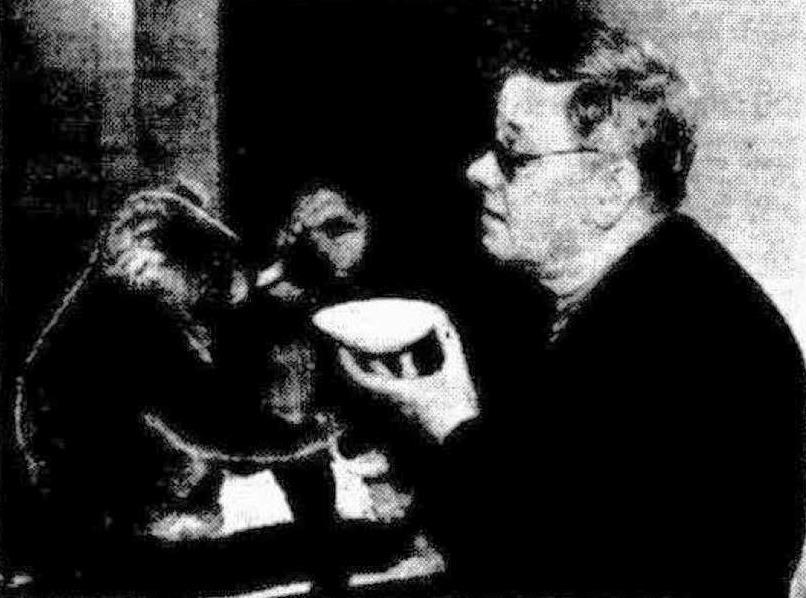
Koala being fed on milk by Mr J. Hallstrom, of Willoughby (NSW), who is nursing it back to health despite two broken hind legs and a broken forefoot. The bear is tied to a rubber cushion, has its injured limbs in plaster, and supports itself by the upright post. INJURED KOALA AS PATIENT. (1943, December 1). The Mercury (Hobart, Tas. : 1860 - 1954), p. 6. Retrieved from http://nla.gov.au/nla.news-article25981748
Sir Hallstrom was also a family man and was, in fact, the first gentleman to be named 'Father of the Year' in Australia.
Half a year prior to his death, in a Women's Weekly interview he said, when asked alike other what his perception of Heaven and Heel weer, he answreed:
"HELL is a way of thinking. I don't have any Hell, because I have no terrors about anyone or anything. My outlook toward my neighbor is friendly. Heaven to me now is a happy home life. It's people who make Heaven or Hell."
Edward was born on the 25th of September 1886 at High Park station, near Coonamble, New South Wales, eighth of nine children of William Hallstrom, a saddler from England who was of Swedish descent, and his native-born wife Mary Ann, née Colless, a descendant of John Lees of the New South Wales Corps on her maternal side and also the gentleman who was responsible for building the first Methodist Church in Australia at Castlereagh. His parents marriage was registered in Mudgee on the 24th of October, 1873. Their children were William Charles (born 1874), Elizabeth E (born 1876), Mary A (born 1878), Christina Ida (born 1879) Ruby J (born 1882) Clement G (born 1883) Jessie M (born 1885), Edward J L (born 1886), Percival W (born 1888).
His father seemed to have a rough trot as a farmer, had problems with a neighbour farmer whose farming practices were ascribed as the reason for flooding on the Hallstrom farm and his losing fruit trees and valuable crops. A Court Case where William Hallstrom asked for £2000 in compensation resulted in £500 being awarded, although whether he ever received this is unsure. He was accused as being responsible for a barn burning down, for which he was arrested and later found to be innocent as the accuser was lying. Soon afterwards, in 1890, the family moved to Sydney.
Some records state Mr. Hallstrom left the family soon after their arrival in Sydney and that his wife struggled to raise their children on her own. A poem written by him and published in 1910 may indicate religious differences of some sort of a certain pride in his son Edward's penchant for aeronautics during this time.
Inventor And Businessman - From Aeronautics To Bedsteads To Refrigerators
At the age of 10 Edward Hallstrom began working at the weekend to help his family make ends meet. At age 13 he had left school to become an apprentice:
There’s room at the top of the tree -By Robin Adair
…. Then, of course, there was a boy named Edward, who was born at Coonamble, N.S.W., in 1887, the son of an English migrant, and who moved to Sydney as a baby. Edward started work at 10, doing odd jobs after school and at week-ends. He also left school at 13, for a job in a furniture factory. When he was 16 he was in charge of the factory and only a few years later set up his own furniture-manufacturing business.
His eventual big career - making refrigerators - doesn't mean Edward has a "cold" heart.
Fun (through "his" Sydney Zoo) and financial aid (through his many philanthropic gifts) have been given to thousands of Australians by Sir Edward Hallstrom. There's room at......the top of the tree (1961, May 24). The Australian Women's Weekly (1933 - 1982), , p. 4 (Teenagers' Weekly). Retrieved from http://nla.gov.au/nla.news-article46939964
A quick mind and a love of every new advancement for humankind mark many chapters in Edward Hallstrom's life. He was quick to support by funding advances in medicine and embraced, as someone who saw all these possibilities, what could become, initially this showed in a penchant for air, for birds, and flight and wishing to be his own man - this was the first 'business' Edward Hallstrom went into, possibly one of many who sought to win this offer from the Federal Government - 1909 being the same year the Orville brothers secured eleven thousand pounds from the American government for a similar challenge - there is a little on these early flight developments in Pittwater Regatta Air Race Trophies: from 1934 and 1935 and The Pilot Who Saved William Hughes
For Mr. Hallstrom, this was obviously a great idea and a chance to win a fortune. This was also where and when, during one exhibition, he met the girl who would become his wife and the association which began his being among the First to Fly in Australia at Narrabeen:
COMMONWEALTH AEROPLANE. FEDERAL GOVERNMENT'S OFFER. MELBOURNE, Thursday. The federal Government has de rifled to otter a prize of £5000 for tie inventor of an aeroplane capable of being made nee of In war time, on condition that a similar amount be raised by public subscription. COMMONWEALTH AEROPLANE (1909, July 23). Daily Post (Hobart, Tas. : 1908 - 1918), , p. 6. Retrieved fromhttp://nla.gov.au/nla.news-article187879423
Wright Aeroplane Sold. AMERICAN GOVERNMENT PAYS £11,000.
As a result of Mr. Orville Wright's success in completing a straight flight with the Wright aeroplane over a distance of five miles, then turning and coming straight back, the U.S. Government has awarded him a prize of £5000, and has agreed to purchase the machine for £6000.
Mr. Wright, in accordance with the conditions of the trial, carried a passenger, Lieutenant Faulois, and the flight was made at the rate of 42 miles per hour. A despatch from- St. Paul states that a proposal is being forwarded to Mr. Wright and to M. Bleriot, for an aeroplane contest between the two aviators, to take place at the Minnesota State Fair. A prize of £5000 is offered for the competition. Wright Aeroplane Sold. (1909, September 11). The World's News (Sydney, NSW : 1901 - 1955), , p. 12. Retrieved from http://nla.gov.au/nla.news-article133973958
AEROPLANE FACTORY.
The first aeroplane factory established in the southern hentisphere has been started in Sydney. The works are situated in Surry Hills. and consist, of a two-storied building, sufficiently large to allow many full-sized aeroplanes and war kites to be constructed. Eight war kites are now being built, and a large aeroplane is ready to be assembled. Following on the foot-steps of the British authorities, the Sydney factory is paying a lot of attention to war kites.' These models, which are now nearly built, are an improvement of the British productions. The defect in the latter, as in most large kites, was that they required a very strong wind to lift them. With the local variety, however, this, it is claimed, has been got over, owing to simpler construction and modified ideas- all of which wili tend to perfect this type of flying machine.
Mr. George A. Taylor. Secretary of the Aerial League, said that the possibilities of the man-lifting kite have not yet been fully realised. He considered that the war kite-simple to build, cheap, and compact, can be more easily transported in the field of operations. For a place like Australia, he contended, with her wide unpopulated areas and lack of communication, and with lonely scattered defences- war kites, especially if fitted with wireless telegraphy, will be preferable to torpedoes, Dreadnoughts, or aeroplanes. This type of flying machine possesses advantages over military balloons, Mr. Taylor thinks, as any variety of the latter is difficult to transport, if not impossible, owing to the cost of gas. cylinders, and expense of up-keep. The model, which looked enormous, was shaped somewhat like the wings of a bird. The arms on each side measured 15ft., or 30ft. across from tip to tip. Below these wing-like planes is another smaller pair, the height from the lower to the lipper set being 10ft. This new war kite showed that wonderful thought has been expended, with a view of obviating wind resistance anil vacuums, which in all air vessels is one of the greatest diilliculties to overcome. Unlike other models produced in England and the Continent, the Sydney varieties have the planes curved upward, so as to give a lifting power of their own.
A frame of a full-sized aeroplane is only awaiting its engine from Melbourne before being tested with other war kites at the aviation display to be held late this month. An interesting feature of the latter demonstration will be the installation of wireless telegraphy. Some of the kites to be flown will be supplied with this method of communication, and will prove no doubt of interest, seeing that the coming military manoeuvres are near at hand. Mr. Taylor, in exposing some of the material ready to be adopted in his kites and aeroplanes, said that the possibilities of wireless telegraphy.should especially appeal to Australia, as it will be the means of bridging silent spaces in a way hitherto impossible.
''We will have 50 aeroplanos in use by the Government within the next few years. War kites-they will be in common use, and wireless telegraphy will be fitted to them.j Had the Waratah been fitted with wireless telegraphy her messages could have been received by war kites over many times the distance that would have been possible with an ordinary receiving station. That shows you the great possibilities of these handy reliable, and cheaply-made methods of flight." AEROPLANE FACTORY. (1909, October 7). Clarence and Richmond Examiner (Grafton, NSW : 1889 - 1915), p. 8. Retrieved from http://nla.gov.au/nla.news-article61502009
See:
BUILDING AUSTRALIA EXHIBITION.
The attractions at the Building Australia Exhibition have been so varied of late that huge crowds now visit the grounds morning and evening. Yesterday the balloon ascent, the flights of the war kite and the numerous other displays proved exceeding interesting. A further trial of model aeroplanes took place when the Postle Bros of Ashfield and Mr Hallstrom of Summer Hill tested new models. Those who attended were aroused to a great pitch of enthusiasm over the exhibitions. Mr. Hallstrom flew his model from one end of the Exhibition Hall to the other and Messrs Portle also succeeded in accomplishing equally sensational flights … BUILDING AUSTRALIA EXHIBITION. (1909, November 6). The Sydney Morning Herald (NSW : 1842 - 1954), , p. 16. Retrieved from http://nla.gov.au/nla.news-article15084052
LECTURES.
AERONAUTICS, with Exhibition of Original Working Models, by E. J. L. Hallstrom, Esq. (Inventor), of The Ricketts Hallstrom Aeroplane Coy., Eastwood, N.S.W., at School of Arts, 275 Pitt-street, Sydney, on MONDAY', Dec. 27, at 8 p.m. Musical Programme at conclusion of lecture. Aerial League Members cord. inv. Advertising (1909, December 25). The Sydney Morning Herald (NSW : 1842 - 1954), , p. 13. Retrieved fromhttp://nla.gov.au/nla.news-article15075749
AERONAUTICS.
Mr. E.J.L. Hallstrom of the firm of Ricketts, Hallstrom Aeroplane Company, delivered a lecture last night at the School of Arts under the auspices of the Australian Natives' Association. Mr Ricketts occupied the chair, and read a paper by Mr Hallstrom, which outlines the history of flying machines.Mr Hallstrom then produced and described several model flying machines of his own invention. One of these was the small monoplane which he had first exhibited in public in Queensland. It was driven by a propeller worked by elastic and on being released it flew smoothly down the hall and dropped on to a vacant seat. Another monoplane of his own invention was shown. This he stated had attained a flight of 200 yards, which, he said, was a world’s record for a model.
During the evening, Mr. George Taylor, secretary of the Aerial League, addressed the meeting and expressed regret at the lack of interest exhibited in aerial matters in Australia. AERONAUTICS. (1909, December 28).The Sydney Morning Herald (NSW : 1842 - 1954), , p. 4. Retrieved fromhttp://nla.gov.au/nla.news-article15074063
This Queensland visit is significant as it establishes Mr. Hallstrom in Queensland during this time and when and where he may have initially met his first wife. One of his brothers, Percival, spent a fair amount of time in Queensland too prior to this and appears among Rowing competitions back in Sydney afterwards. Another brother, Clement, also married a Queensland girl. Their mother had a relative in the area and the boys may well have been sent north for work opportunities.
GLIDING AND AEROPLANING.
TO THE EDITOR OF THE HERALD.
Sir -At the Sydney School of Arts last Monday evening in a paper read by Mr. Hallstrom of the Ricketts Hallstrom Aeroplane Company, re aerial navigation, a suggestion was thrown out by the speaker that gliding was a preliminary to aeroplaning was essential and seeing that gliding in other parts of the world has developed into a comparatively safe and certainly a most exhilarating pastime is it not wise that Australians should be moving.
Geographically we have a country in the suburbs of Sydney particularly suited for the sport having the necessary inclines for the pastime and suitable to making successful ascents.
Moreover the temperament of the people of this country would lend itself to this pastime as the sport is one that would appeal to them once introduced, and is one requiring judgment, a little nerve at the earlier stages, and for purposes of health it would be hard to strike on anything so beneficial. Moreover excellence in the sport would serve as a necessary introduction to aeroplaning. Seeing that Australia from its geographical position has more to gain than possible any other country by successful aerial navigation for defence and other purposes it would be wise for the Federal Government in addition to the £5000 prize for the most successful Australian aeroplane to subsidise by a small grant clubs formed for the purpose of fostering the gliding sport as successful aeroplanes are of comparatively little utility unless we have people with the necessary experience in driving them which can best be attained in gliding. I am, etc.. NATIONAL SPORT. GLIDING AND AEROPLANING. (1909, December 30). The Sydney Morning Herald(NSW : 1842 - 1954), , p. 10. Retrieved from http://nla.gov.au/nla.news-article15094851
AERIAL LEAGUE
“An Aeronautical Evening” was the title of the Aerial Leagues entertainment at the Royal Society’s House last evening. The proceedings were opened by a paper by Mr. G. Garland on “The Aerial Defence of Australia”, in which it was graphically pointed out how Australia today is defenceless against aerial attack. He was followed by Major Rosthenthal, who lecture on “Modern Artillery in relation to Aerial Invasion”, illustrated with lantern slides of what the world is doing to put up some kind of defence against the new terror.
Mr. G. A. Taylor spoke on “Failures and Successes in Australian Aeronautics” which contained much valuable advice. His flights at Narrabeen Heads were graphically told and illustrated by striking photographs, his new machine, now complete, was shown in the air. A number of interesting models were shown, those by Messrs. Hallstrom and Heath Bros. being exceptionally clever. AERIAL LEAGUE. (1910, January 27). The Sydney Morning Herald (NSW : 1842 - 1954), , p. 8. Retrieved from http://nla.gov.au/nla.news-article15150110
The Aerial League of Australia had a successful meeting at the Royal Society's House one night last week, when a large audience .was treated to what was styled 'an aeronautical evening.' Mr. Charles L. Garland opened the proceedings with a lecturette on 'The Aerial Defence of Australia,' pointing out .how the conquest of the air was fraught with very great danger to the Commonwealth, as it proved an opening for. an attack in a sphere for which we were utterly unprepared. He was followed by Major Rosenthal, who gave an interesting description of the various methods the Old-world aviators were using in endeavoring to combat aerial attack, and he incidentally mentioned that the equipment for such purposes was very necessary in Australia in view of the activity in that quarter in other countries. Mr. George A. Taylor dealt with 'Failures and Successes in Australian Aeronautics.' He pointed out the varied work that he had been doing in aeronautical matters, laying particular stress upon the war kite construction which he had prepared for the recent exhibition, and how when success was almost assured, the City Council stepped in and put a stop to the experiments. He contrasted the action of the local body with that of the Paris Municipal Council, which was offering £4000 to encourage aerial experiments. The sensational gliding flights carried out by Mr. Taylor and his brother members of the Lillienthal camp, Narrabeen, were illustrated and described, and created great enthusiasm. Mr. Taylor also showed a new aeroplane he had just completed, which overcomes many of the difficulties of modern aeroplanes. He then exhibited a view of the engine that is now being installed in his monoplane. A number of interesting models were shown by Messrs. Hallstrom and the Heath Bros., and they won particular praise. These models contain many features new to the science, and the members of the League hope that the attention of our moneyed gentlemen will be drawn to these clever experimenters, so that their work can be fittingly encouraged. Motoring! (1910, February 2). Referee (Sydney, NSW : 1886 - 1939), , p. 14. Retrieved from http://nla.gov.au/nla.news-article120141340
At age 24, meanwhile in Croydon, the Inner West of Sydney:
THE NEW SOUTH WALES STORM. MUCH DAMAGE DONE. LOSS OF LIFE FEARED.
Sydney, July 10.
There was a break in the storm during the night, but this morning there was a shift in the wind to the northward, and the gale raged with renewed vigor, accompanied by blinding rain squalls. The highest velocity of the wind was 57 miles an hour. All along the coastline the storm is in full blast, rough seas sweeping the whole seaboard- Shipping so far has escaped serious disaster, but a number of minor casualties have been reported as a result of the battle with the elements. …
At Croydon yesterday Mr. E. Hallstrom, an enterprising mechanic, possessed an aeroplane, which he had constructed at the cost of much time and trouble. It reposed in an apparently safe hangar. Today he possesses neither aeroplane nor hangar, only a mass of torn canvas, broken wood-work, and other debris. In the height of the storm yesterday the wind gained an entrance to the hangar, and in a moment there was rending of canvas, and the hangar had departed. The aeroplane then went on its first and only trial flight, and made its descent in the back yard of a dwelling, just missing an elderly occupant, Mr. E. A. Thomas, who subsequently explained that he saw it coming, and thought if was a large bird. THE NEW SOUTH WALES STORM (1910, July 20). The Advertiser (Adelaide, SA : 1889 - 1931), , p. 10. Retrieved from http://nla.gov.au/nla.news-article5257190
LECTURE.— On Saturday Captain G. A. Taylor, of the Commonwealth Intelligence Forces, delivered his very instructive and entertaining lecture on 'Wire-less telegraphy and aeronautics' to a fair audience on behalf of the School of Arts. The Hon. Joseph Cook, M.H.R., ex-Minister for Defence, occupied the chair, and in introducing Captain Taylor, said he was an enthusiast on the topics of wireless and aviation, especially in relation to Australian Defence, and that his knowledge of these matters would be quite up to date, and second to that of none in Australia. The lecturer fully justified Mr. Cook's remarks. His lucid and often racy explanations of otherwise abstruse facts kept his audience .wide awake for considerably over an hour. A model aeroplane, made by Mr. Halstrom, who assisted Captain Taylor, was launched amongst the audience by an electric spark. Ken. Hunt (a younger son of Mr. ,T. C. Hunt, M.L.A., the worthy member for Sherbrooke) dodged the flying machine — which made a bee-line for him from the platform — with all the agility of a politician skilfully evading an awkward question. A cannon was also fired by electricity. Miniature wireless posts and other electrical apparatus on the platform wore used by the lecturer to illustrate his remarks, and the magiclantern having caught, tho strike epidemic, Captain Taylor well made up for its absence by his lightning skill as a black-board artist. On the motion of Mr. ,T. J. Price, president of the School of Arts, a hearty vote of thanks was given to Captain Taylor, who, it may be said, is the editor of 'Building' and the 'Marine Engineer,' Sydney. Kerosene was first used for lighting purposes in 1826. Baulkham Hills. (1910, November 12). The Cumberland Argus and Fruitgrowers Advocate (Parramatta, NSW : 1888 - 1950), , p. 8. Retrieved from http://nla.gov.au/nla.news-article85999546
The Hallstrom- Nineham and Hallstrom - Jaffrey weddings.
MARRIAGE. HALLSTROM-NINEHAM.-At St. Paul's Cathedral, Rockhampton, by the Rev. Mowbray O'Rorke, Clement George Hallstrom, of Sydney, to Mabel Frances, only daughter of A. C. and T. Nineham, of Mount Morgan. Family Notices (1910, November 26).Morning Bulletin (Rockhampton, Qld. : 1878 - 1954), , p. 1. Retrieved from http://nla.gov.au/nla.news-article53199243
As stated in the 'Room at the top of the tree' article, Edward went into a furniture making business as an apprentice and then began his own business.
Soon after the trying to win the government aeroplane prize, another invention, which will not be the last time Mr. Hallstrom seeks to add to the defence of Australia, appears in the National Archives of Australia's Letters for Patents lists:
E J L Hallstrom claims he has invented a shell for striking vessels below the water line - 1914, record created by the Navy Office, Department of Defence.
Unfortunately the tragic death of one worker, never really explained but seemingly caused by an injury which sounds like concussion, resulted in bankruptcy. The law suit brought by the poor man's wife was protracted and went through a few courts, indicating in many a such case, the lawyers may have recouped more than those they represented. The widow was awarded £500.
This tragedy seemed to mark Mr. Hallstrom in other ways - once successful and giving away hundreds of thousands of pounds that amounted to millions of dollars in today's terms, the number of times he gave £500 could indicate this was a marker of some sort for him. It was £500 damages his father was awarded in 1888 too due to losing his own livelihood, an enormous sum for then.
The case attracted nationwide press as the award was made under the newly introduced Workmen's Compensation Act of 1926. Prior to this the young father showed some of the enterprise that extended throughout his life, experienced what many go through when running a business and also lost his father
This era of making beds is also notable as another Edward Hallstrom first as these are reputed to be innerspring mattresses – the first in Australia:
The Timber Industry
Mr. Hallstrom, an enterprising furniture manufacturer, of Pyrmont, Sydney, started a saw-mill at Micalong about eight months ago, on the most -up-to-date and modern lines, and must be finding the mountain ash a good proposition, as we have just learned from a reliable source that that gentleman is now having plans and specifications prepared to install a branch of the furniture-making business in the district. The idea is to use hydraulic or hydroelectric power to dress and prepare the timber, after seasoning it, thus avoiding the carriage on waste material. The use of cheaper power will also be of advantage. The Timber Industry. (1921, November 4).The Tumut and Adelong Times (NSW : 1864 - 1867; 1899 - 1950), p. 2. Retrieved from http://nla.gov.au/nla.news-article139023442
Fittings for bedsteads — Hallstrom. Advertising (1922, January 18). Daily Commercial News and Shipping List (Sydney, NSW : 1891 - 1954), , p. 5 (Weekly Summary.). Retrieved from http://nla.gov.au/nla.news-article159680282
PUBLIC NOTICES. OWING to a death in the Family' the establishment of E. J. L. Hallstrom, Abattoirs-road, Pyrmont, will be closed on Thursday. Advertising (1923, March 14). The Sun (Sydney, NSW : 1910 - 1954), , p. 8 (LAST RACE EDITION). Retrieved fromhttp://nla.gov.au/nla.news-article223463119
HALLSTROM.—March 14, at Sydney, William Hallstrom, sen., aged 80 years. Privately interred. Family Notices (1923, March 16). The Sydney Morning Herald (NSW : 1842 - 1954), , p. 8. Retrieved from http://nla.gov.au/nla.news-article16055890
Cracksmen - Attempt at Pyrmont Fails
Sydney – Monday
Hallstrom’s bedding factory, at Pyrmont, was broken into during the night by cracksmen, who removed the safe at the back of the factory. After packing it they tried to blow it open. The lock was damaged but the door held fast. CRACKSMEN. (1923, July 16). The Maitland Daily Mercury (NSW : 1894 - 1939), , p. 5. Retrieved from http://nla.gov.au/nla.news-article124488530
Hallstrom, E. J. L.. Ltd. — Regd.
19.11.23. Capital: £10,000 in £1 shares. Objects: To acquire by agreement the business of a wire mattress and general manufacturer now carried on by Edward J. L. Hallstrom under the style of E. J. L. Hallstrom. First Directors: Edward John Lees Hallstrom (chairman) and Paul Jenner Ure (deputy). Regd. office: Sydney. COMPANIES REGISTERED (1923, November 28). Daily Commercial News and Shipping List(Sydney, NSW : 1891 - 1954), , p. 5 (Weekly Summary.). Retrieved from http://nla.gov.au/nla.news-article159922017
PYRMONT FIRE. POLICE INVESTIGATING. THIEVES SUSPECTED.
THE police are investigating a suspicious outbreak of Fire which occurred in the premises of E. J. L. Hallstrom, Limited, bedstead and wire-mattress manufacturers, Abattoir road, Pyrmont, at about 3 a.m. yesterday.
When discovered the fire was beginning to secure a hold on the contents of the factory, and had destroyed some bedsteads and timber. A safe near the front of the promises was found to have been tampered with, and traces of kerosene were found near this safe and in other parts' of the building.
Mrs. Addison, of Edwin-street, Drummoyne, was going towards her home, in a car in the early morning when she saw the fire gaining headway in the factory. She motored to the fire brigade, whose prompt action averted a serious fire, especially as a timber-yard adjoins the factory at the rear.
Last night Mr. Hallstrom stated that two previous attempts had been made to break the safe in the past six months. Once an explosive charge had been placed in the lock, but had only blown part of the door away. On the latest occasion the bottom of the safe was cut, and safebreaking tools were found nearby. PYRMONT FIRE. (1924, February 18). The Sydney Morning Herald (NSW : 1842 - 1954), , p. 10. Retrieved from http://nla.gov.au/nla.news-article16107932
WALL V HALLSTROM. Ruby Lilian Wall, of Leichhardt, a widow, appealed from the Judgment of the Full Court of the Supreme Court on the question, whether a wire mattress maker, who met bis death while In the employ of respondent, died through an accident arising out of and in the course of bis employment. Wall was engaged as a wire-drawer by E. J. Hallstrom, bedstead manufacturer, Abattoir-road, Pyrmont, and shortly after he had had his lunch he was found lying dead In a comfortable position on his left side, near the bench at which he worked, with his head on his left arm. There were slight abrasions, but nothing of any Importance, and there were no external signs of Injury; but a post mortem examination revealed the fact that there was a very extensive fracture of the skull. There was no evidence of any kind whatever to show how that was brought about. There was evidence that deceased had been ailing for two or three days beforehand, and that he had complained about his head. Judge Scholes In the Metropolitan District Court, on the hearing of an arbitration under the Workmen's Compensation Act, made an award in favour of the widow for 500, but the Supreme Court set It aside. The widow now appealed from the latter judgment. Mr. SI'Donell (Instructed by Messrs. Jennings and Jennings) appeared for the appellant, and Mr. Monahan (Instructed by Messrs. Dawson, Waldron, Edwards, and Nlcholls) for the respondent. The matter stands part heard. November 28, 1924, The Sydney Morning Herald · Page 6
LAW REPORT. HIGH COURT OF AUSTRALIA.
(Before Sir Adrian Knox, C.J., Mr. Justice Isaacs, and-Mr. Justice Gavan Duffy.)
WALL V HALLSTROM.
Argument was concluded In the appeal by Ruby Lilian Wall, of Leichhardt, a widow, from the Judgment of the Full Court of the Supreme Court on the question whether a wire mattress maker, who met his death while in the employ of E. J. Hallstrom, bedstead manufacturer, Abattoir-road, Pyrmont, died through an accident arising out of and in the course of his employment.
By consent, the order of the Supreme Court and the award made by Judge Scholes were both discharged, and the claim was remitted to arbitration by an arbitrator under the Act, other than the previous arbitrator, no costs to be decided at present, either of former hearing before arbitrator or of appeal before Supreme Court.
Mr. McDonell (Instructed by Messrs. Jennings and Jennings) appeared for the appellant; and Mr. Monahan (instructed by Messrs. Dawson, Waldron, Edwards, and Nicholls) for the respondent. LAW REPORT. (1924, November 29). The Sydney Morning Herald (NSW : 1842 - 1954), , p. 14. Retrieved from http://nla.gov.au/nla.news-article16180012
WORKMEN'S COMPENSATION CASE.
An application was made, under the Work-men's Compensation Act, for arbitration between Ruby Lillian Wall, of Elswick-street, Leichhardt, widow, and E. J. Hallstrom, of Abattoir-road, Pyrmont, bedstead manufacturer, from whom she claimed £500 in connection with the death of her husband, who was employed as a wire drawer at the defendant's factory. Wall was found dead near his work, but nothing definite could be arrived at regarding the actual cause of his death
The case came before Judge Scholes, who awarded the widow £500 compensation. His Honor held that Wall had died as the result of a fall at his place of occupation on July 5, 1923. The respondent contended that Wall's death was not due to an accident arising out of his employment. An appeal to the Full Court against the Judge's decision was upheld, and the award was set aside. From this decision, the applicant appealed to the High Court, which referred the matter back to the District Court for arbitration de novo.
According to medical evidence, Wall had a fractured skull, but no definite opinion could he given as to whether this had caused his death. The case is part heard. Mr. Windeyer, K.C., and Mr. McDonnell (instructed by Messrs. Jennings and Jennings) appeared for the applicant; and Mr. Monahan (instructed by Messrs. Dawson, Waldron, Edwards, and Nicholls) for the respondent. DISTRICT COURT. (1925, March 6). The Sydney Morning Herald(NSW : 1842 - 1954), , p. 6. Retrieved from http://nla.gov.au/nla.news-article16198659
WALL-The Friends of Mr. ANTHONY THOMAS WALL and FAMILY are Invited to attend the Funeral of their late loved HUSBAND and FATHER, Anthony Thomas; to leave 60 Tebbutt-street, Leichhardt, THIS AFTERNOON, at 1.1S, for Church of England Cemetery, Rookwood, via Lewisham Station. F. DANGAR, Funeral Director, 'Phone, MW1468._02_George-street West.
ALL.-The Relatives and Friends of Mr. and Mrs. GEORGE HENRY WALL and FAMILY are invited to attend the Funeral of their late loved SON and BROTHER, Anthony Thomas; to leave 60 Tebbut. street, Leichhardt, THIS AFTERNOON, at 1.16, for Rookwood Cemetery. Family Notices (1923, July 7). The Sydney Morning Herald (NSW : 1842 - 1954), , p. 11. Retrieved from http://nla.gov.au/nla.news-article16079022
MYSTERIOUS DEATH
Award of £500 to Widow
A widow, Mrs. Ruby Lillian Wall, of Elswick-street, Leichhardt, was recently awarded £500 by Judge Scholes in respect to the death of her husband, an employee at E. J. Hallstrom's, a bedstead manufacturer, of Pyrmont. Her husband was found lying dead beneath his bench at the factory. Death was caused by injuries, probably the result of a fall, but nothing definite could be ascertained as to how he came to fall. On appeal the Full Court upset the Judgment— but the High Court ordered a fresh arbitration by another judge. To-day Judge Mocatta reaffirmed the decision of Judge Scholes. He found that Wall met his death as the result of an accident arising out of his employment, and awarded the widow £500. MYSTERIOUS DEATH (1925, March 13).The Sun (Sydney, NSW : 1910 - 1954), , p. 9 (FINAL EXTRA). Retrieved from http://nla.gov.au/nla.news-article222944296
AWARD OF £500
WORKMEN'S COMPENSATION ACT.;
SYDNEY, Friday.— Judge Mocatta, in the District Court to-day, awarded £500 under the Workmen's Compensation Act to Ruby Lillian Wall, of Leichhardt, in respect of the death of her husband, who was an employee. of E. J. Hallstrom, bedstead manufacturer, of Pyrmont. Wall was found dead at his work on July-5, 1923, from a fractured skull.
A stay of proceedings was applied for on behalf of respondent. In view of the appeal, the judge said he would delay the signing of the award for 14 days.AWARD OF £500 (1925, March 14). The Daily Mail (Brisbane, Qld. : 1903 - 1926), , p. 12. Retrieved from http://nla.gov.au/nla.news-article219083523
Due perhaps to the ongoing court case any improvements Mr. Hallstrom made in his beds factory were listed in his wife's name: Application for Letters Patent for an invention by Margaret Elliott Hallstrom, titled - Improvements in joint connections for bedsteads or the like Contents date range 1926 – 1926
E. J. L. HALLSTROM LTD.
Extraordinary Resolution, Passed 29th January, 1926.
AT an Extraordinary General Meeting of the Members of the above named Company, duly convened and held at 47 Elizabeth-street, Sydney, on Friday, the twenty-ninth day of January, 1926, the following Extraordinary Resolution was duty passed as an Extraordinary Resolution :—
That it has been proved to the satisfaction of this meeting that the Company cannot, by reason of its liabilities continue its business, and that it is advisable to wind up the same, and accordingly that the Company be wound up voluntarily; and that William Harrington Palmer be and is hereby appointed Voluntary Liquidator for the purposes of such winding-up.
Dated this 30th day of January, 1926.
E. J. L. HALLSTROM, Chairman. E. J. L. HALLSTROM LTD. (1926, February 5). Government Gazette of the State of New South Wales (Sydney, NSW : 1901 - 2001), , p. 726. Retrieved from http://nla.gov.au/nla.news-article223019734
The new factory was listed for sale
UNDER INSTRUCTIONS FROM THE RECEIVER FOR THE DEBENTURE HOLDERS.
PERCY A. WELLS and COMPANY will sell on the Premises.
E. J. L. HALLSTROM, LTD., MOORE-STREET, LEICHHARDT. THIS DAY, AT 11 A.M.
HAIGH COMBINATION MORTISING MACHINE AND DRILL. 25-H.P. ELECTRIC MOTOR AND SAHTER . (WESTINGHOUSE). 21-H.P. ELECTRIC MOTOR G.E. TENONING MACHINE BY T. AND R. C.I. AND SYOODEN SAW BENCHES. HOT PRESS MOULDER FOR IMITATION CARVING.
TRIPLE SPINDLE DRILLING MACHINE. MATTRESS STITCHING MACHINE. VERTICAL MOULDING SPINDLE. HAND DRILLING MACHINE.
STURTBIT AND BUFFALO BLOWERS, No. 2. LARGE QUANTITY SHAFTING. HANGERS, PULLEYS, BALL BEARINGS, ETC. '
QUANTITY OF SCRAP LEAD. ETC. CUPOLA BLOWER AND PIPING. QUANTITY OF GIRDERS, ANGLE IRON AND RODS. 17,ASSORTED BEDSTEAD WEBS. OFFICE FURNITURE. IRON SAFES, ETC. JOINERS AND CARPENTERS' BENCHES, CLAMPS, ETC.
PERCY A. WELLS AND COMPANY, MACHINERY AUCTIONEERS. COMMERCIAL BANK BUILDINGS, 663 GEORGE-STREET, HAYMARKET. Phone. City 10928. Advertising (1926, January 28). The Sydney Morning Herald (NSW : 1842 - 1954), , p. 3. Retrieved fromhttp://nla.gov.au/nla.news-article16275911
BY ORDER OF THE RECEIVER FOR DEBENTURE HOLDERS.
A LARGE FACTORY PREMISES and LAND, lately occupied by E. J. L. Hallstrom. Ltd.. known as No. 87 MOOHE-STUFET, a short distance from BALMAIN-ROAD. EMINENTLY SUITABLE FOR MANUFACTURERS. IRON MERCHANTS, BOTTLE and TIMBER
MERCHANTS.
… TORRENS TITLE. RICHARDSON and WRENCH, LTD., will submit the
above at PUBLIC AUCTION, in the ROOMS, 98 PITT -STREET, on FRIDAY, 9th APRIL, at 11 a.m. Advertising (1926, April 7). The Sydney Morning Herald (NSW : 1842 - 1954), , p. 18. Retrieved from http://nla.gov.au/nla.news-article16284937
By Older of the Mortgagee
LEICHHARDT LARGE FACTORY PREMISES and LAND lately occupied by E J L Hallstrom, Ltd, known as No 87 MOORE STREET, between the premises of J Bardsley and Sons, Ltd , and the Hunter River Meat Preserving Co , Ltd. A short distance from Balmain road EMINENTLY SUITABLE FOR MANUFACTURERS, IRON MERCHANTS, BOTTLE AND TlMBER MERCHANTS, OR MOTOR TRADEs THE LAND has a frontage of about 152 feet to Moore street by depths of from about 196 feet 3 ½ inches to 150 feet 11 ½ Inches, rear line about 150 feet 2 Inches
THE BUII DINGS COMPRISE Two story brick building, containing 2 offices, with cellar below, and large Iron building, with brick floor, extending back for the full depth of the land, and partly along the rear boundary. Also a one story brick building (about 70 x 65), with iron roof, brick floor, and furnaces installed. Attached are 2 iron sheds, also small weatherboard and Iron Shed. A large portion of the land Is vacant, and available for further building extension. Key for inspection may be obtained at No 130 Moore street, opposite property.
TORRENS TITLE A P Sparke, Esq., 12 Castlereagh street, Soucitor for Mortgagee
HARDIE and GORMAN PROPRIETARY, LTD, in conjunction with J F Green and Co, have received instructions to submit the above at Public Auction in their Sale Rooms, Ocean House, 30 Martin place, at 11 am on WEDNESDAY JULY 28 1926. Advertising (1926, July 17). The Sydney Morning Herald (NSW : 1842 - 1954), , p. 20. Retrieved from http://nla.gov.au/nla.news-article16306473
[Notice under Section 11 of the Bankruptcy Act, 1898.] In the Supreme Court of New South Wales. (25,348)
IN BANKRUPTCY.
Re Edward John Lees Hallstrom, formerly of Abattoirs road, Pyrmont, now of Moore-street, Leichhardt.
NOTICE is hereby given that a Sequestration Order has this day been made against the above named bankrupt, on the petition of Ruby Lillian Wall, and Mr. C. F. W. Lloyd appointed to be the Official Assignee.— Dated at Sydney, this 3rd day of February, 1926. N. C. LOCKHART, Registrar in Bankruptcy. IN BANKRUPTCY. (1926, February 12).Government Gazette of the State of New South Wales (Sydney, NSW : 1901 - 2001), , p. 821. Retrieved from http://nla.gov.au/nla.news-article223019949
E. J. L. HALLSTROM LTD.
THE creditors of the above named Company are required, on or before Monday, the 17th day of May, 1926, to send their names and addresses, and particulars of their debts or claims and the names and addresses of their solicitors, if any, to William Harrington Palmer, of 47 Elizabeth-street, Sydney, the Voluntary Liquidator of the said Company, and if so required by notice in writing from the said Voluntary Liquidator are to come in and prove their said debts or claims at such time and place as shall be specified in such notice, or in default thereof they will be excluded from the benefit of any distribution made before such debts are proved. WILLIAM HARRINGTON PALMER, Voluntary Liquidator. 47 Elizabeth-street, Sydney. 29th April, 1926.E. J. L. HALLSTROM LTD. (1926, April 30). Government Gazette of the State of New South Wales (Sydney, NSW : 1901 - 2001), , p. 1950. Retrieved from http://nla.gov.au/nla.news-article219950677
The family moved to Dee Why in late 1927 or 1928. Then what was to become the turning point in Edward Hallstrom the Inventor's life was also listed in his wife’s name due to ongoing bankruptcy proceedings which continued while this eventuated and marked in just four words:
- Patents 13, 475. M. E. Hallstrom.- Refrigerating apparatus. COMMONWEALTH APPLICATIONS. (1928, June 20). Daily Commercial News and Shipping List (Sydney, NSW : 1891 - 1954), , p. 8 (Weekly Summary.). Retrieved from http://nla.gov.au/nla.news-article160009916
From National Archives (of Australia): Application for Letters Patent for an invention by Margaret Elliot Hallstrom, titled - Improvements in refrigerating apparatus 1928
The ‘Debentures’ were still trying to sell factory late in 1928, possibly to begin a new enterprise, definitely to feed and house children:
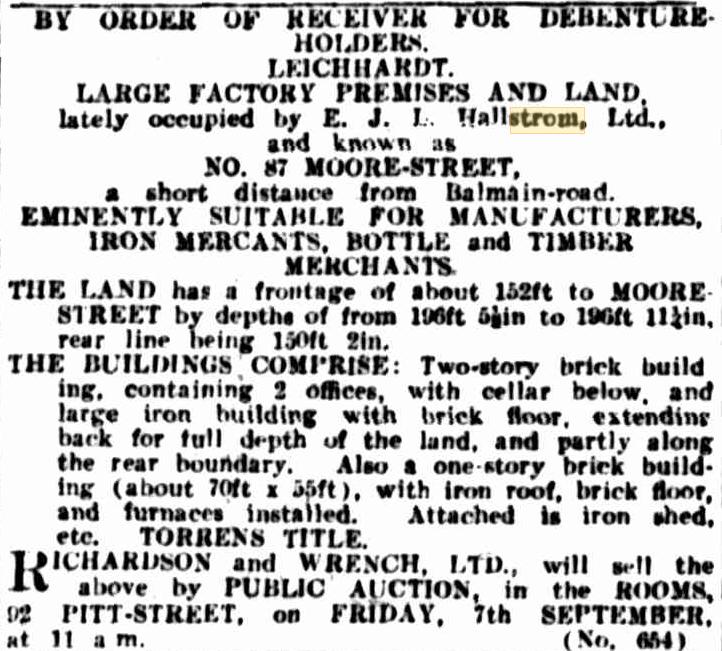
To the Nth. Sydney Boys' Intermediate High School. E. J. Hallstrom. Artarmon; HIGH SCHOOL NEXT (1928, February 2).The Sun (Sydney, NSW : 1910 - 1954), , p. 22 (FINAL EXTRA). Retrieved from http://nla.gov.au/nla.news-article224227664
QUALIFIED TO ENTER THE HIGH SCHOOLS OCTOBER EXAMS.
As a result of the High School entrance examination' held last October the boys and girls named qualified for admission to the Intermediate High Schools mentioned. They will be enrolled upon application to the principals of the following schools on February 5
MANLY I.H.S … Hallstrom, E. J., Dee Why; QUALIFIED (1929, January 24). The Sun (Sydney, NSW : 1910 - 1954), , p. 17 (CRICKET STUMPS). Retrieved from http://nla.gov.au/nla.news-article230369725
This Notice of prizes won lists so many rural prizes at the 1930 Brookvale Show that it could easily have been a smaller rival for the Royal Easter Show.
Crayon Drawing (fruit or flowers), boy or girl 16 years or under: Jean Hallstrom 1 Best Pen-and-ink Copy of Cartoon, boy or girl 13 years and under: Jean Hallstrom 1. Original Design, in water or dry color, for book cover, 7in. by 5ln. (not less than three colors), schoolboy or girl— Esme Hallstrom 1. Map of Australia, 16ins. by 12ins. (school boy or girl) Jack Hallstrom 1. Mapping Book, at least 5 maps (schoolboy or girl): Jean Hallstrom 1. Water Color Painting, from copy (school boy or girl): Jean Hallstrom 1. BROOKVALE SHOW (1930, April 12). The Sun (Sydney, NSW : 1910 - 1954), , p. 7 (LAST RACE RESULTS). Retrieved from http://nla.gov.au/nla.news-article223705078
Jean and Esme continued drawing and their drawings were published. The third and fourth ones show a lovely nature, a love of ‘fairy nooks’ perhaps, and a talent for art. The Hallstrom home at Willoughby amounted to 21 acres at the time it was sold after Sir Hallstrom passed away. Bush pockets and a park were donated to Willoughby Council prior to then. Perhaps these provided inspiration, along with popular stories every child has access to.
Their mother painted all her life and kept supporting local endeavours:
Lady Hallstrom gives her paintings away
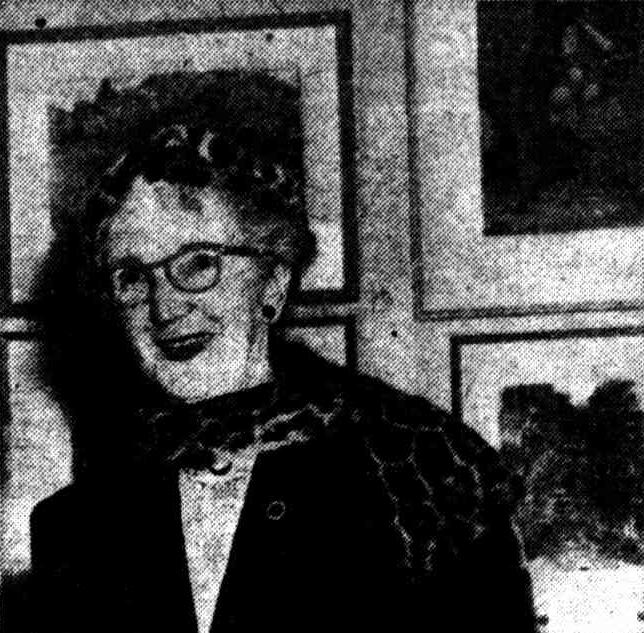
A TINY, grey-haired woman sat on a doorstep in Montmartre last year with a Polish artist, and painted a picture of the steep cobbled street in front of her. More than 100 Sydney women looked at the picture yesterday, and heard the artist — in a slim black suit, with elegant leopard skin hat and scarf — tell stories of her overseas painting tour. She is Lady Hallstrom, wife of Sydney philanthropist Sir Edward Hallstrom, who lent 30 water colors for an exhibition for the Metropolitan Group of the Country Women's Association. Proceeds of the showing, which was at Abbotsleigh, Cammeray, will buy furnishings for a room in Keera House, the CWA holiday home at Dee Why. New pictures None of the pictures had been shown previously. They are mostly landscapes and street scenes from the British Isles, Europe, Scandinavia and parts of America. Lady Hallstrom, soft-voiced and unassuming, said, "I painted them all in one or two hours each. The largest is about this big (indicating a canvas about 18in by 10). "I have no idea how many other paintings I've done — I couldn't even guess." Her companion on the seven months' trip (her second abroad) was Mrs. Grace Holswich, of Sydney. They returned last November.
Paints antiques
"Grace doesn't do much painting, only a few copies," Lady Hallstrom said. "She likes to look at antiques — and I like to paint them." On all her travels Lady Hallstrom took a bottle of water and a folding seat with her painting essentials. She took the water to mix her paints, in case none was available where she felt like painting, and used to set up the seat with equal aplomb in the streets of townships or on mountain tops. Although she has been painting since she was 16, Lady Hallstrom has never had a public exhibition, and has never sold a painting. Her exhibitions have been for charities, and she prefers to give away her paintings rather than to sell them. Photo: Lady Hallstrom speaking to C.W.A. members against a background of some of her paintings. Lady Hallstrom (1954, May 13). The Sun (Sydney, NSW : 1910 - 1954), , p. 49 (LATE FINAL EXTRA). Retrieved from http://nla.gov.au/nla.news-article230778845
These sketches, winning prizes, also shows the same 'earning it for yourself' ethos their father learnt as a 10 year old had translated across the generations. As pocket money, 7 shillings and 6d (2 ½ pence) in 1934 would be around £13.87 today or $23.35 cents, not bad pocket money for teenagers and ranking the Hallstrom girls as among some of Sydney's youngest professional artists of that era.
Jean’s:
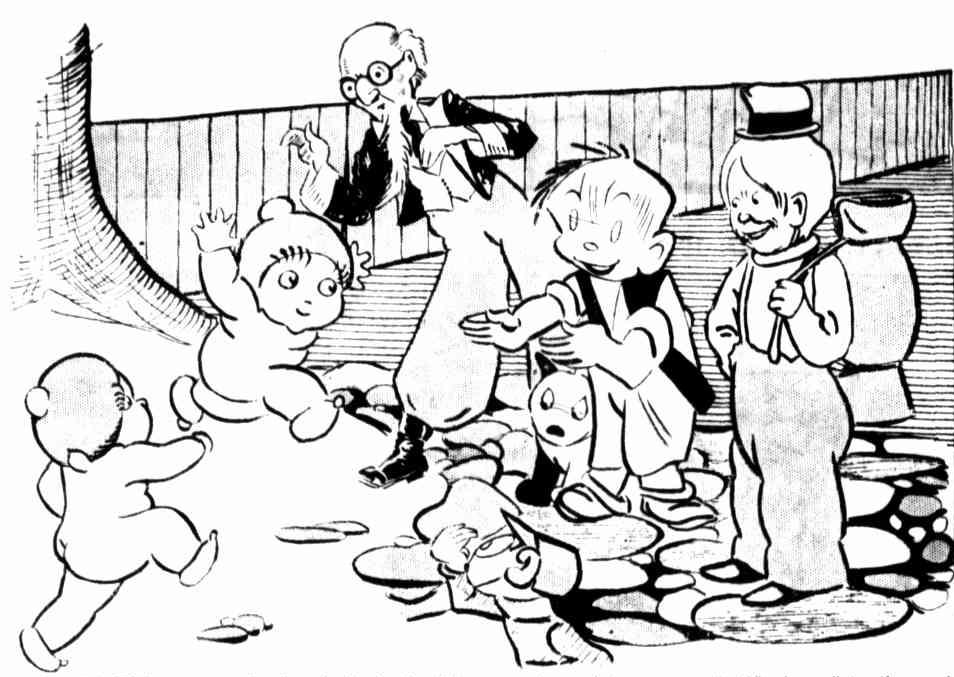
BIB AND BUB were one day lost in the bush. This scene shows their return to the "Sunbeams" family, much to the joy of all. For this sketch, Jean Hallstrom (17), 26 Ryans-rd., Willoughby, wins 7s 6d. No title (1934, July 22). The Sun (Sydney, NSW : 1910 - 1954), , p. 54 (STUMPS). Retrieved fromhttp://nla.gov.au/nla.news-article229571987
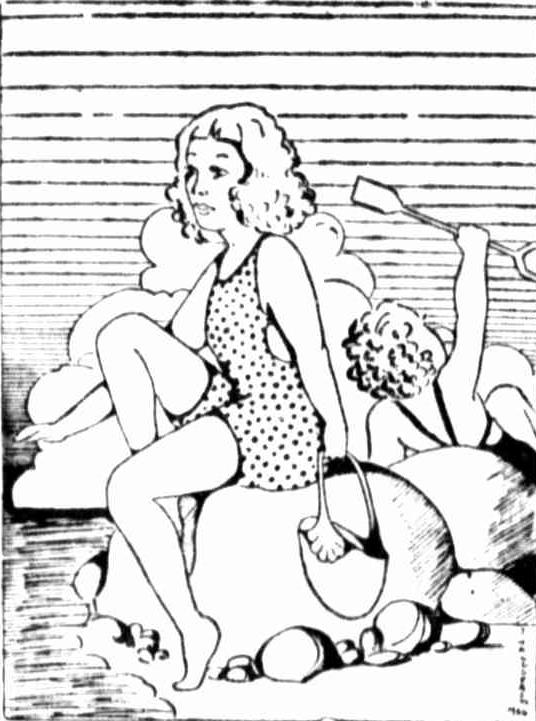
BY THE SEASIDE.— Purple Certificate to Jean Hallstrom, 26 Ryan's-rd., Willoughby. CASH PRIZE STORIES (1934, November 4). The Sun (Sydney, NSW : 1910 - 1954), , p. 3 (SUPPLEMENT TO THE SUNDAY SUN AND GUARDIAN). Retrieved from http://nla.gov.au/nla.news-article230156160

Purple certificate to Jean Hallstrom (17), 26 Ryan’s road, Willoughby. No title (1934, December 23). The Sun (Sydney, NSW : 1910 - 1954), , p. 4 (SUPPLEMENT TO THE SUNBEAMS). Retrieved from http://nla.gov.au/nla.news-article230165925
Memorial to Sir Joseph Banks
A £2000 memorial to Sir Joseph Banks was unveiled at Kurnell, Botany Bay (where he landed with Captain Cook), last week by Governor-General McKell. THE monument was given by Mr. Edward J. Hallstrom. Mr. McKell and Mrs. McKell and Mr. Hallstrom. and his daughter, Mrs. Jean Hill, planted banksia trees behind the memorial. Mrs. Hill modelled the head of Banks for a bronze plate on the memorial. Memorial to Sir Joseph Banks (1947, September 15). Worker (Brisbane, Qld. : 1890 - 1955), , p. 13. Retrieved from http://nla.gov.au/nla.news-article71311271
MEMORIAL TO FIRST GOVERNOR.
The Maritime Services Board, in consultation with the Royal Australian Historical Society, plans to erect a memorial to the first Governor of N.S.W., Captain Arthur Phillip, in front of the Board's new building on Circular Quay. The memorial will overlook Sydney Cove, which is still the official name of Circular Quay, where Phillip established the first settlement on the banks of the Tank Stream in 1788. A metal plaque for the memorial is to be provided by Sir Edward Hallstrom. MEMORIAL TO FIRST GOVERNOR. (1953, August 5). Construction (Sydney, NSW : 1938 - 1954), , p. 8. Retrieved from http://nla.gov.au/nla.news-article222897997
THE GOVERNOR PHILLIP MEMORIAL
This Memorial has just been erected in front of the Maritime Services Building, Circular Quay West, Sydney. It was just about this spot that Captain Arthur Phillip, R.N., landed in Sydney Cove on January 26, 1788. On the rear of the sandstone pedestal is this inscription: "This Memorial was erected by the Maritime Services Board of N.S.W. in conjunction with the Royal Australian Historical Society. The bust of Captain Phillip was sculptured by Mrs. Jean Hill, daughter of Sir Edward Hallstrom, through whose generosity the bust was donated." THE GOVERNOR PHILLIP MEMORIAL (1954, August 18). Construction (Sydney, NSW : 1938 - 1954), , p. 2. Retrieved from http://nla.gov.au/nla.news-article224517088
This last entry for the Arthur Phillip work was recently moved and can now be seen at the Museum of Sydney on the site of Australia’s first Government House. This Museum of Sydney page even shows a photograph of the sculptress at work.shared by her daughter
Esme’s:
Blue Certificate to Esme Hallstrom (14), 26 Ryans rd„ Willoughby.
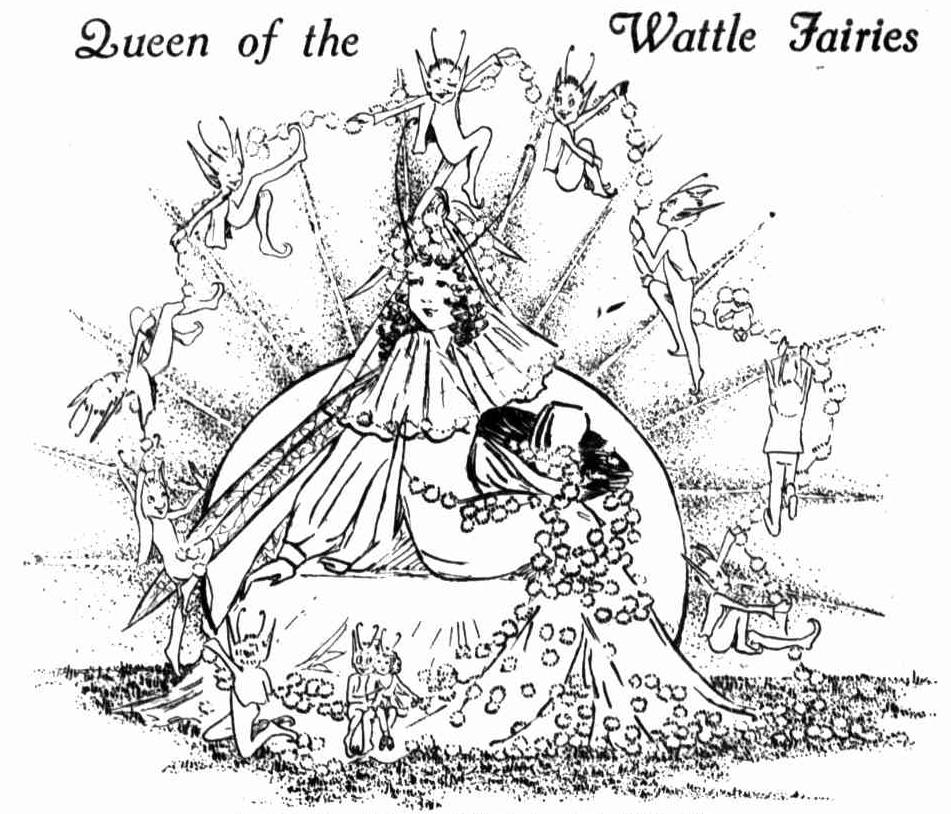
Queen of the Wattle Fairies , 7s 6d to Esme Hallstrom (14), 26 Ryan's rd., Willoughby. Queen of the Wattle Fairies (1933, July 23). The Sun (Sydney, NSW : 1910 - 1954), p. 2 (SUPPLEMENT TO THE SUNDAY SUN AND GUARDIAN). Retrieved from http://nla.gov.au/nla.news-article231441741
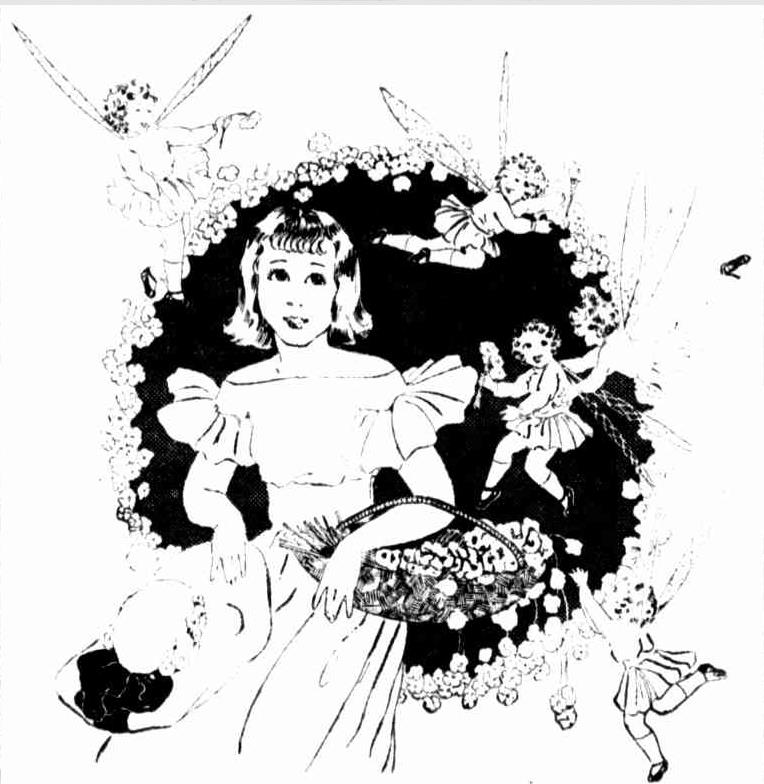
SUMMER GIRL.- — Purple. Certificate, to Esme Hallstrom. 26 Ryan's-rd,. Willoughby. No title (1934, November 25). The Sun (Sydney, NSW : 1910 - 1954), , p. 2 (SUPPLEMENT TO "THE SUNDAY SUN AND GUARDIAN"). Retrieved from http://nla.gov.au/nla.news-article230152425
Results of the 1937 final examinations of the Technical Education Branch are published below…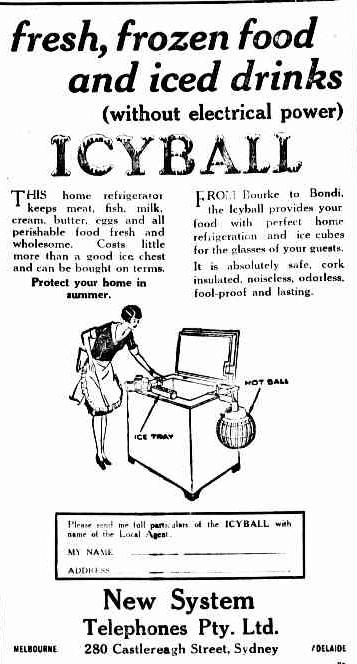 East Sydney: COMMERCIAL ART COURSE Stage III- … Esme Hallstrom ART DEPARTMENT. (1938, January 5).The Sydney Morning Herald (NSW : 1842 - 1954), , p. 8. Retrieved from http://nla.gov.au/nla.news-article17422817
East Sydney: COMMERCIAL ART COURSE Stage III- … Esme Hallstrom ART DEPARTMENT. (1938, January 5).The Sydney Morning Herald (NSW : 1842 - 1954), , p. 8. Retrieved from http://nla.gov.au/nla.news-article17422817
The Hallstrom girls earlier art works show the family has moved to Willoughby, while a Discharge of Bankruptcy Notice show Mr. Hallstrom is getting ready to begin again with the refrigerators he became famous for - soon after the 1928 Patent Letters applied for Notice appears, so does this little invention from a gentleman in America - no fridges were being made in Australia, they were all imported:
WHAT IS THE ICY BALL?
This is an age of progress, and the latest example in the West ls the Icy Ball Refrigerator. The Icy Ball requires no Ice, freezes ice cream, Jellies, and keeps food in even, temperature. It Is easily operated, requiring five minutes every 24 hours, yet is claimed to do the working of any refrigerator. without cost. No electric light is required, or running water, and the price ls from £32 10s cash, or easy terms can be arranged. Demonstrations daily at N. Phillips and Co, 867 Hay-street, Perth.WHAT IS THE ICY BALL? (1928, September 2). Sunday Times (Perth, WA : 1902 - 1954), p. 11 (First Section). Retrieved from http://nla.gov.au/nla.news-article58363277
Right: Icy Ball Advert with diagram FRESH, FROZEN FOOD (1928, December 19). Crookwell Gazette (NSW : 1885 - 1954), p. 6. Retrieved from http://nla.gov.au/nla.news-article221337859
BANKRUPTCY.
TAKE NOTICE That Edward John Lees Hallstrom, of 26 Ryan-street, Willoughby.
To the Official Assignee and Creditors.
TAKE NOTICE that Edward John Lees Hallstrom intends to apply to the Court, Supreme Court Building, Elizabeth-street, Sydney, on Monday, the 8th day of February, 1932, at 10 a.m., or as soon afterwards as the course of business will admit, that a Certificate of Discharge be granted to him under and according to the provisions of the Bankruptcy Act, 1898.—Dated this 20th day of January, 1932.
C. E. CHAPMAN, Solicitor for the Applicant, 29 Bligh-street, Sydney. IN BANKRUPTCY. (1932, January 22).Government Gazette of the State of New South Wales (Sydney, NSW : 1901 - 2001), , p. 404. Retrieved from http://nla.gov.au/nla.news-article220231666
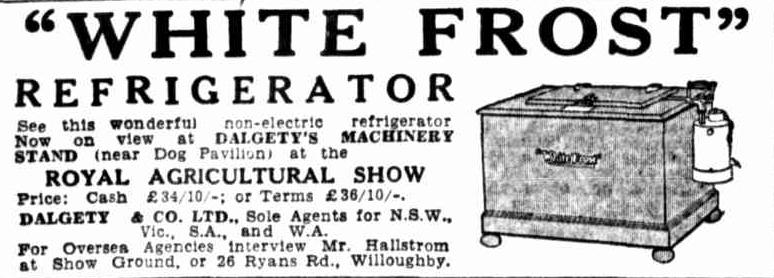
Above from: Advertising (1932, March 26). The Sun (Sydney, NSW : 1910 - 1954), p. 4 (LAST RACE RESULTS). Retrieved fromhttp://nla.gov.au/nla.news-article229884320
By 1933 Mr. Hallstrom had not only launched his 'White Frost',. he had also become an exporter:
To: PAPEETE. E. Hallstrom, 3 cs refrigerator units. NEW SOUTH WALES EXPORT MANIFESTS. (1933, December 19). Daily Commercial News and Shipping List (Sydney, NSW : 1891 - 1954), p. 6. Retrieved from http://nla.gov.au/nla.news-article161578998
The Food Saver That 'Pays For Itself'
It should be no surprise that a man who began life in rural areas and had a mother of country upbringing, and who began working himself at age 10 should focus on producing something that could be used to benefit people in the rural areas of Australia, without electricity in many cases, and make it affordable as well as safeguarding your health.
As a Cabinet Maker constructing something which could be cooled down, after decades of already being fascinated with machinery, began many improvements on great ideas. A list of his patents charts these:
Application for Letters Patent for an invention by Edward John Lees Hallstrom , titled - Improvements in refrigerating apparatus employing the absorption principle - 1934: Patent Office - Retrieved from the National Archives of Australia
Application for registration of a design by Edward John Lees Hallstrom for Refrigerator - Class 1 - 1934: Patents Office - Retrieved from the National Archives of Australia
Application for Letters Patent for an invention by Edward John Lees Hallstrom titled - Improvements relating to condensing means in refrigerating apparatus - 1935: Patents Office - Retrieved from the National Archives of Australia
Application for Letters Patent for an invention by Edward John Lees Hallstrom , titled - Improvements in household refrigerator cabinets - 1936: Patents Office - Retrieved from the National Archives of Australia
DAWN OF NEW ERA
HALLSTROM Improved Refrigerators - Kerosene Operated
NO other home utility gives greater convenience than a Refrigerator. It eliminates food waste and begins to pay for itself from the moment of installation. A HALLSTROM refrigerator in a country home is a necessity not a luxury, and requires two minutes daily attention in lighting a small kerosene lamp which automatically burns out.
In Australia a local industry of paramount interest to country dwellers has been pioneered and built up after years of experimental work, and the problem of food preservation for country people has been solved by the HALLSTROM kerosene operated Refrigerator. The inventor, E. 'Hallstrom, who holds Australian and world-wide patents, is also the manufacturer. In his spacious factory at 462-464 Willoughby Road, Willoughby, Sydney, the refrigerators are constructed entirely of Australian materials.
Why HALLSTROM Refrigerators are only available in Chest Models: On opening an upright refrigerator cold air descends and is lost. On the, opening of a Chest Model the cold air remains imprisoned.
European and American refrigeration engineers and inventors have found great difficulties in producing a non-electric semi-automatic refrigerator, and this field of refrigeration research and manufacture is strewn with numerous models placed on the market, subsequently recalled, and production stopped.
The HALLSTROM Refrigerator; which has proof of efficiency in country homes throughout Australia, will give a lifetime of service, is fully guaranteed, and costs less than 2/~ per week in kerosene. PAYS FOR ITSELF! See Local Agents for E. F. Wilks & Co., Ltd.; Simplex Baltic Machinery Coy., Ltd.; and Dangar Gedye & Co., Ltd. Trade names in N.S.W.: "Gulbraneen," "Hallstrom," and "Magicold." DAWN OF NEW ERA (1935, August 2).The Land(Sydney, NSW : 1911 - 1954), , p. 8. Retrieved from http://nla.gov.au/nla.news-article104197748
The New Era for Country Home Life PROGRESS AND COMFORT.
What a boon— non-electric Refrigerator for the country. Kerosene costs 2/- a week.
New Era in Home Comfort.
An ancient refrigerator marks the starting point of a new era in home comfort and good preservation. A starting point which like the car Industry was destined to expand with enormous strides until to-day almost everyone who can afford either a car or a refrigerator will add thorn to their list of modern possessions. The automobile has justified itself by the comfort and convenience it gives its owner. A refrigerator in a home has developed far beyond though degree of a luxury and has become a modern household necessity. For many years since the advent of commercialised electric power city dwellers were tho only section of the community who could obtain a suitable typo of convenient, refrigerator. Consequently country dwellers have up to fairly recent years still had to grapple with one of the most difficult problems the housekeeper has to face in summer months. Primarily it is a question of family health, but, in addition, there is the Important question of expenses Involved in food wasted. The food which quickly becomes unsuitable for consumption in hot weather represents so much money wasted.
Pays for Itself.
The modern refrigerator therefore provides not only a definite protection to health, but, remarkable though it may seem on first thought, it is one of the really modern household appliances I which pays for itself as time goes on. Large quantities of meat immediately 1 after a 'killing' on a country property can be stowed away and kept fresh and I wholesome for long periods. In addition I it enables the housewife to enlarge her I table menu with all the delicacies which I can be provided in mid-summer by use of a refrigerator. It is impossible to live in the city without being 'refrigerator minded.' Every modern home is incomplete without a refrigerator. In the country districts people are rapidly taking advantage of the boon to their home life which the advent of a nonelectric refrigerator has brought them.
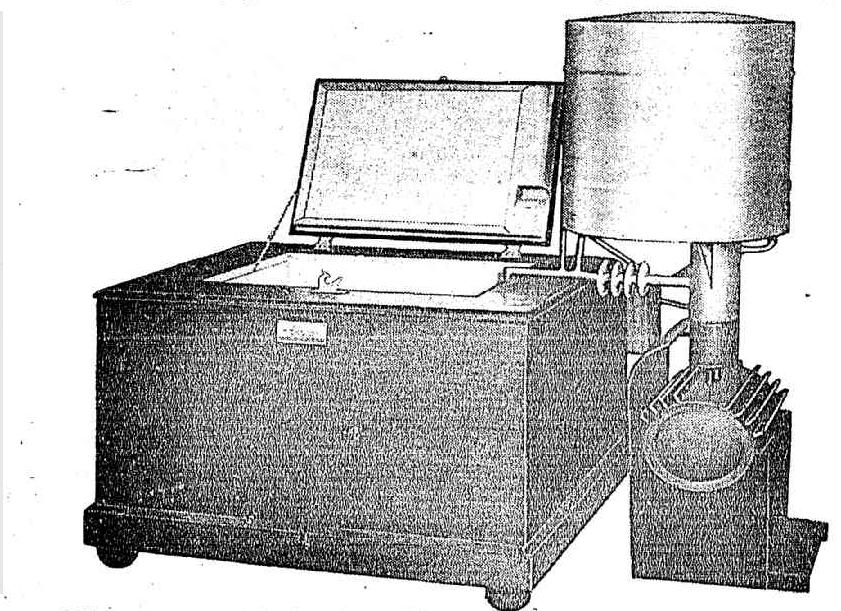
A visit to the large and modern factory of Edward John Hallstrom, of Willoughby, Sydney, gives a striking impression of the growth of this branch of the non-electric refrigeration industry which he has pioneered in Australia. Mr. Hallstrom is the inventor and manufacturer of the Semi-automatic kerosene operated refrigerators which have built up for him a fine reputation for so successfully fulfilling the pressing needs of such a large proportion of the population.
Simplicity and Trouble Proof.
A remarkable feature of the Hallstrom manufactured refrigerator is its extreme simplicity and trouble-proof system of operation in providing perfect refrigeration. All that is required by the User is to light a small kerosene lamp once a day, which automatically burns out after a short while, involving a total running cost of 2/- per week In kerosene. These kerosene operated refrigerators have no moving parts or mechanism, are strongly built to last a lifetime, and each unit passes through a most thorough process of testing as to construction and the Hallstrom factory. The cabinets have been designed and constructed to give the maximum of refrigeration any storage capacity, and by reason of the 'chest type' design of the cabinet, cold air remains imprisoned when the lidiIs lifted for the purpose of handling foodstuffs, which is a decided advantage in maintaining uniform refrigeration efficiency.These remarkable refrigerators are covered by patent rights throughout the world, and their perfect efficiency in every climate in Australia as well as the Pacific Islands has justified the confidence in them of the N.S.W. Distributors, Messrs. Dangar Gedye & Co. Ltd. The view expressed by one used after the arrival of a Hallstrom manufactured refrigerator to his country home, which Is typical of many others, was expressed an follows: 'The dawn of a now era has arrived for people compelled to live in the hot drought-stricken area.' Seeing is believing, and those who have not yet had the opportunity of actually wooing the Hallstrom manufactured non-electric refrigerator in operation should write for particulars, and arrangements will be made for a demonstration by the N.S.W. Distributors, Messrs. Dangar Gedye & Co. Ltd. either at their head office or their local country town agents.When Catholics (1935, September 19).Catholic Freeman's Journal (Sydney, NSW : 1932 - 1942), , p. 8. Retrieved from http://nla.gov.au/nla.news-article146504295
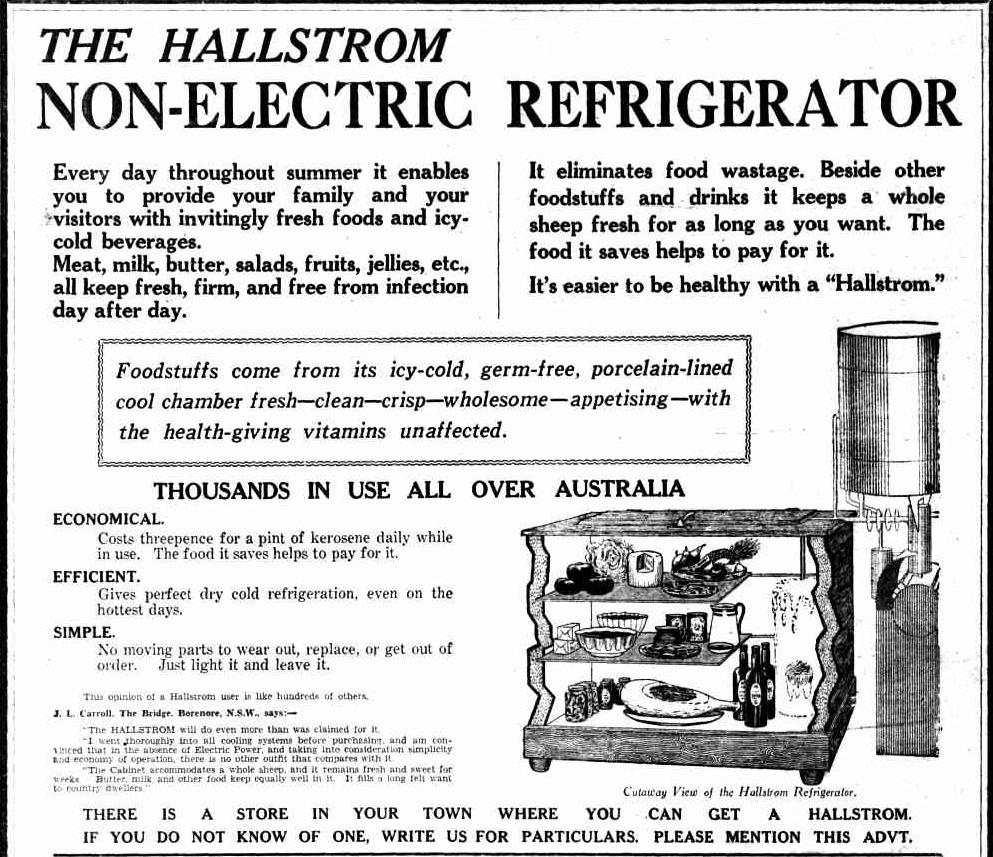
Above from: Advertising (1935, October 12). The Australasian (Melbourne, Vic. : 1864 - 1946), p. 55. Retrieved from http://nla.gov.au/nla.news-article141763675
Progress: The Hallstrom Era
For many years since the advent of commercialised electric power, city dwellers were the only section of the community who could obtain a suitable type of convenient refrigerator. Consequently country dwellers have up to fairly recent years still had to grapple with one of the most difficult problems the housekeeper has to face in summer months. Primarily it is a question of family health but in addition I there is the important question of I expenses involved in food wasted. Food which becomes unsuitable for I consumption represents so much money wasted. The modern I refrigerator provides definite protection to health and is one of the really modern household appliances which pays for itself as time goes on. Large quantities of meat immediately after a "killing" on a country property can be stowed away and kept fresh and whole-some for long periods. The house-wife can also enlarge her table menu with all the delicacies in mid-summer by use of a refrigerator. It is impossible to live in the city without becoming "refrigeration minded." Every modern home is incomplete without a refrigerator. Country people are rapidly taking advantage of the boon to their home life which the Hallstrom nonelectric refrigerator has brought to them. The large and modern factory of Edward John Hallstrom of Willoughby, Sydney, gives a striking impression of the growth of this branch of the nonelectric refrigeration industry which he has pioneered in Australia.
Mr Hallstrom is the Inventor and Manufacturer of the Semi-automatic kerosene operated refrigerators which have built op for him a world wide reputation for so successfully fulfilling the pressing needs of such a large proportion of the population. A remarkable feature of the Hallstrom manufactured refrigerators is their extreme simplicity and trouble proof system of operation in providing perfect refrigeration. They are also extremely economical. The user simply lights a small kerosene lamp once a day, which automatically burns out after a short while, involving a total running cost of 2/- per week m kerosene. They have no moving parts or mechanism — are strongly built to last a lifetime, and each unit passes through a thorough process of testing as to construction and refrigeration efficiency before leaving the Hallstrom factory. The Hallstrom refrigerators are trouble proof, give a lifetime of refrigeration efficiency, are most simple to operate and cost only 2/- per week in kerosene which is their sole running cost. They have I been Installed in thousands of homes J throughout Australia and the I Islands and their perfect efficiency in every climate has given womanly satisfaction to their enthusiastic tests Enquiries as to these Ideal country refrigerators should be seat immediately to the Victorian Distributors, Mitchell & John. Ltd., …Progress (1935, November 28). Cobram Courier (Vic. : 1888 - 1954), , p. 2. Retrieved from http://nla.gov.au/nla.news-article188621076
HALLSTROM LEADS WAY
The month decided upon for the public release of the 1937 Hallstrom Kerosene-operated Refrigerator is August. Then will be brought to the country public of Australia the most important development in the history of non-electric refrigeration. Country refrigeration has developed so much over the past 10 years that everywhere the advent of this entirely new product is awaited with most widespread interest.
The new model is a result of a decade of exclusive and specialised experience without parallel in the; successful manufacturing of nonelectric refrigerators in Australia; a success which each year has brought about the rapid expansion of manufacturing facilities and retail selling outlets.
This leadership of the entire refrigeration industry has been still further stabilised in the sensational announcement of the 1937 Model. In the new model is incorporated beyond doubt, the finest freezing unit ever produced in any type of kerosene operated refrigerator. It is aircooled, dispensing entirely with the usual water cooling system, and is encased in the most modern of streamlined white steel . upright cabinets. "Every feature has been designed to give greater efficiency, greater convenience, greater utility and moulded into a complete refrigerator unsurpassed in appearance- and ih value and at prices •unequalled in the entire refrigeration industry.
Further important announcements will be made on this Hallstrom masterpiece, and August will witness its arrival, in most country towns throughout the Commonwealth. HALLSTROM LEADS THE WAY (1937, May 21). The Land (Sydney, NSW : 1911 - 1954), , p. 24. Retrieved fromhttp://nla.gov.au/nla.news-article104149235
HALLSTROM
PERHAPS the most interesting exhibit to country visitors to the Royal show Is that of the Hallstrom kerosene operated refrigerators being displayed by the manufacturers on their large stand in the new Australian Manufacturers' Hall. This exhibit has attracted particular interest on account of the new model, which has been termed the 1938-39 Hallstrom Centenary Refrigerator. The Important features about this refrigerator, from a country man's point of view is the extra large storage space, as well as the very safe and simple system of operation. Just by the mere process of an oil burning lamp, burning for two hours out of each 24-hours, continuous refrigeration is provided. They combine all the best features for country refrigeration, and at the price of £50/10/ F.O.R. Sydney, they certainly represent very excellent value, particularly as they are not only covered by a 3 years' guarantee, but are designed and constructed to give many more years of trouble-free service. HALLSTROM (1938, April 14). The Farmer and Settler(Sydney, NSW : 1906 - 1955), , p. 9. Retrieved from http://nla.gov.au/nla.news-article117161172
COMPANIES ACT, 1936 (Section 323 (5)). NOTICE is hereby given that the names of the Companies set out below have been struck off the register. The Concentrating and Amalgamating Company Limited(In Liquidation). E. J. L. Hallstrom Limited (In Liquidation). COMPANIES ACT, 1936 (Section 323 (5)). (1939, June 23). Government Gazette of the State of New South Wales (Sydney, NSW : 1901 - 2001), , p. 3077. Retrieved from http://nla.gov.au/nla.news-article225078141
Boys, strong, for refrigerator factory. Sheet metal experience advantage. Apply personally. HALLSTROM. 452 Willoughby road, Willoughby.
SHORTHAND-TYPISTS. 20 years or over. Must be thoroughly competent. Apply personally, with references. HALLSTROM. 452 Willoughby road, Willoughby. Advertising (1939, October 9). The Sydney Morning Herald (NSW : 1842 - 1954), , p. 16. Retrieved from http://nla.gov.au/nla.news-article17638139
The Silent Knight
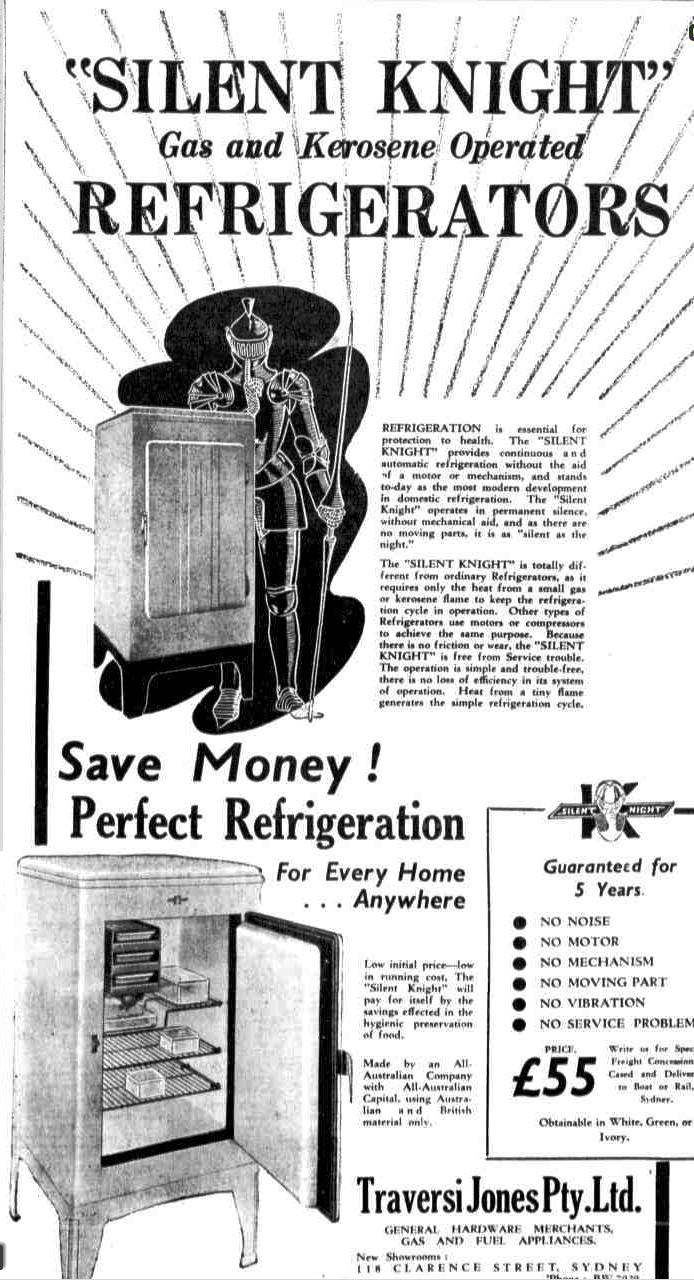 During the early part of World War Two Edward Hallstrom made further improvements to his fridge invention and came out with what would be his one of his most successful versions. He was also involved in the war effort, as were his children, son John serving, enlisting in 1939, while Jean;
During the early part of World War Two Edward Hallstrom made further improvements to his fridge invention and came out with what would be his one of his most successful versions. He was also involved in the war effort, as were his children, son John serving, enlisting in 1939, while Jean;
SYDNEY, NSW. C. 1939. JEAN HALLSTROM. ONE IN A SERIES OF PORTRAITS OF EARLY MEMBERS OF WOMEN'S EMERGENCY SIGNALLING CORPS (WESC), MANY OF WHOM BECAME WRANS. THE ALBUM OF PORTRAITS WAS COMPILED BY MRS FLORENCE VIOLET MCKENZIE OBE, FOUNDER OF WESC, WHICH TRAINED SIGNALLERS AND TELEGRAPHISTS. (DONOR M. TAYLOR) Image No: P01262.207, courtesy Australian War Memorial
His factory produced munitions, as well as refrigerators for the American Army for medical purposes. By 1945 Hallstrom Pty Ltd was turning out 1200 refrigerators per week and employing over seven hundred people and invented a machine for refrigerating anaesthetics which he presented to Sydney Hospital during these years as well as 'body armour - which brings us to that 'silent knight and wooden cabinets evolving into steel ones'.
These were not only affordable they were accessible in post-war scarcity and when some complained of the high cost of running them with electricity, Mr. Hallstrom met their energy bills - for a while.
In 1940:
'Silent Knight'
YOU need a refrigerator, Perhaps you think that is just nonsense, but when you consider these facts we believe you will reach a difernt conclusion. A refrigerator Is essential to health because It keeps food fresh and wholesome throughout the summer months when every country woman ...Thnt weans thut It offori nioro stornne upset) than tho motordriven types, tin Important consideration. The 'Silent Knight' Is soundless and reliable. It Is the Ideal refrigerator you need. It Is operated by Kerosene lamp, gas Jet or electric element. "Silent Knight" (1940, November 28). Advertisment Illustration from page 9 of same Issue: The Farmer and Settler (Sydney, NSW : 1906 - 1955), p. 7. Retrieved fromhttp://nla.gov.au/nla.news-article117484486
[Inventor/Submitter -] E L Hallstrom - Body armour - 1942: Record made by Army Inventions Directorate - Retrieved from the National Archives of Australia
EJL Hallstrom - Improvements in absorption refrigeration - 1944: Patents Office - Retrieved from the National Archives of Australia
Spectacular fire at Willoughby
Awakened by explosions which could be heard a mile away, hundreds of Willoughby residents early today watched a spectacular blaze which did £4000 damage at E. J. Hallstrom's refrigerator factory. The factory in Willoughby-road is worth £40,000, and firemen made a brilliant save, isolating the outbreak in the cabinet-packing Section. Here 400 refrigerators' — 200 ready for the usual daily delivery—were destroyed. Forty firefighters, directed by Deputy-Chief Officer Currer and Sixth Officer Bishop, quelled the fire in half an hour. Boiling over of a pot of bitumen, used for sealing the insulation in the refrigerators, is believed to have started the fire. Prompt action by resident works manager Ernest Bell, clad only in pyjamas, saved five motor lorries, which he drove to safety through flames. Spectacular fire at Willoughby (1948, March 2). The Sun (Sydney, NSW : 1910 - 1954), , p. 5 (LATE FINAL EXTRA). Retrieved from http://nla.gov.au/nla.news-article228998411
Mr Hallstrom rebuilt, spending thousands of pounds, and including:
Alterations and Additions. E. J. Hallstrom, 462 Willoughby Rd., £1085. Miscellaneous. Amenities building, cnr. Willoughby and Artarmon Rds.—E. J. Hallstrom, 462 Willoughby Rd., £1100; SMALL CONTRACTS (1948, April 14).Construction (Sydney, NSW : 1938 - 1954), , p. 7. Retrieved fromhttp://nla.gov.au/nla.news-article222879281
Clinic In Factory
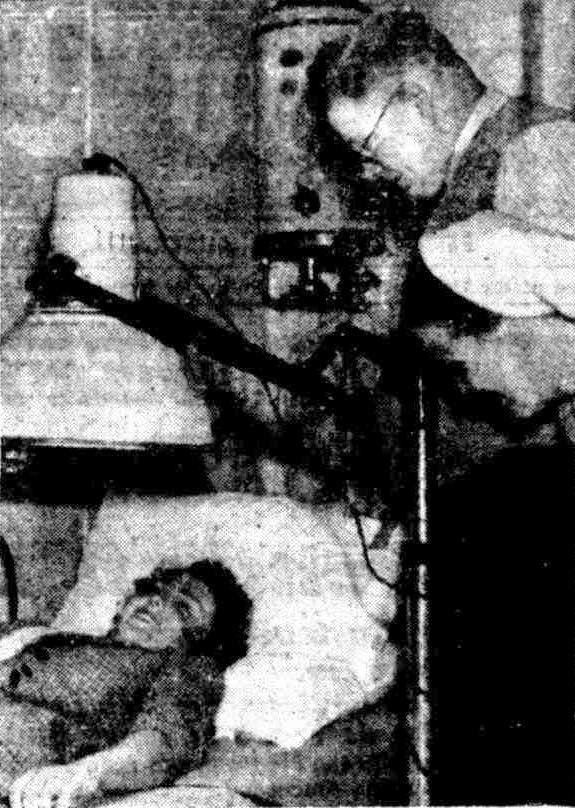
MR. E. J. HALLSTROM, Elizabeth Andrews (on bed), and Sister Hoy, in the clinic at Mr. Hallstrom's Willoughby (NSW) .factory. The clinic is for the treatment and examination of factory employees. Clinic In Factory (1948, May 30). Sunday Times (Perth, WA : 1902 - 1954), , p. 3. Retrieved fromhttp://nla.gov.au/nla.news-article59481418
Miscellaneous. Canteen, Willoughby Rd.—E. J. Hallstrom,462 Willoughby Rd., Naremburn, £5100; SMALL CONTRACTS (1948, November 24).Construction (Sydney, NSW : 1938 - 1954), , p. 14. Retrieved from http://nla.gov.au/nla.news-article222880995
There's a touch of sardonic humor on the wharves these days, now that discipline has been tightened up. One company, quick to sack men for offences on its wharf, is known as the Rocket Range — all hire and fire. Another has its wharf named Taronga Park, because the wharfies say that the foremen are like wild animals. ARTHUR POLKINGHORNE'S (1951, September 17). The Sun (Sydney, NSW : 1910 - 1954), , p. 11 (LATE FINAL EXTRA). Retrieved from http://nla.gov.au/nla.news-article229722191
Hallstrom's offer
A new-model refrigerator will be given by Mr. E. J. Hallstrom to anyone who has lost an uninsured Silent Knight refrigerator through bush-fires. Hallstrom's offer (1952, January 31). The Sun (Sydney, NSW : 1910 - 1954), , p. 13 (LATE FINAL EXTRA). Retrieved from http://nla.gov.au/nla.news-article230099147
Philanthropy - Health And Animals And Environment
Edward Hallstrom suffered from chronic bronchitis, which began when a small child at Coonamble. A focus on health for people concentrated on Cancer, TB and Heart conditions in massive donations which amounted to one million pounds over several years. Some records estimate he gave the same again to Taronga Zoo in donations of animals and facilities for years.
His wife and his own family, with records of illnesses not cured for decades and family members who served as health professionals or served the community in other capacities, are firm threads in his private and public life:
A New Auxiliary
A very successful meeting of women was held on Wednesday afternoon at Roseville for the purpose of forming an auxiliary to work for the Renwick Hospital for Infants, Summer Hill. Great interest was evinced in the movement, and it was decided to commence activities at once. The following office-bearers were elected:-Mrs. E. Hallstrom (president), Mrs. J. P. Osborne (vice-president), Mrs. E. Pye (honorary secretary), and Mrs. A. Diamond (honorary treasurer). BRIEFLY— (1934, March 9). The Sydney Morning Herald (NSW : 1842 - 1954), , p. 4. Retrieved from http://nla.gov.au/nla.news-article17057721
One of his first large donations was towards a replacement for HMAS Sydney. Edward had an ongoing honouring of the Navy - one item indicates his grandfather was a Swedish sea captain, his father in law had served aquatically too.
On 19 November 1941, HMAS Sydney, a light cruiser of the Royal Australian Navy with an impressive record of war service, was lost following a battle with the German raider HSK Kormoran in the Indian Ocean off the Western Australian coast. The loss of the Sydney with its full war complement of 645 remains Australia’s worst naval disaster. The Kormoran was also sunk, but 317 of its crew of 397 were rescued. The fate of the Sydney remains one of Australia’s greatest wartime mysteries; even the location of the wrecks was not established until 2008.
The circumstances of the Sydney-Kormoran action also contain dramatic elements. The ships' careers had been the antithesis of each other. TheSydney was an outstandingly successful warship, the most famous of the RAN's ships in November 1941. Aesthetically elegant, she had created headlines with her exploits in the Mediterranean, especially the brilliant action off Cape Spada.
The Kormoran's mission was to shun the limelight. Converted from a freighter she was well armed with guns, torpedoes and mines, but this armament was carefully disguised so that only the closest scrutiny would reveal that she was not a merchant ship. It was not her role to fight fleet actions but to operate alone against unescorted shipping for months at a time, avoiding publicity and supported by clandestine meetings with supply ships in remote locations.
The two ships met off the Western Australian coast in the afternoon of 19 November 1941. In the ensuing action the Kormoran's disguise was sufficient to entice the Sydney into close range where she was able to overwhelm her with gunfire and torpedoes. However, although mortally hit, the Sydney was able to fight back and ensure the raider's destruction before limping slowly away to her own fate and that of her crew.
A starboard view of HMAS Sydney taken in August 1941 Courtesy AWM. Image No.: 301407
For 12 days the government maintained the strictest secrecy about the loss of the Sydney. When Prime Minister John Curtin made the first of two public announcements on 1 December 1941, he did little more than confirm rumours that the Sydney had been sunk. For the public the shock of the loss was accompanied by bewilderment that such a disaster could occur. A suspicion that information was being concealed was strengthened by the delay in making the official announcement, by the lack of any real explanation when the announcement did come, and by the secrecy which surrounded the official investigation of the disaster.
A national fund, to be known as “Sydney Fund," will be launched soon to commemorate H.M.A.S. Sydney's heroic achievements by replacing her with another cruiser.
The Prime Minister (Mr. Curtin) said in Canberra to-day that he favored this course and would instruct the Navy and Treasury to confer immediately to iron out "technical difficulties." "Let those patriotic citizens who wish to give money for the purpose of the war, give, and we shall name the ship the Sydney," he said.
The Minister for the Navy (Mr. Makin) also said that public-spirited people who wished to assist the Government In any such project would find that their assistance would be welcomed. "Already initial suggestions have been made by civic heads of both Sydney and Melbourne concerning a public appeal to forward such a project," Mr. Makin said. "I have no doubt that within the next week we shall be able to say more clearly what proposals would be best."
A Sydney businessman to-day offered to start a fund' for the purchase of a new cruiser Sydney with a personal gift of £1000. He is Mr. E. J. Hallstrom, a refrigerator manufacturer, of Willoughby. "I feel sure that every person in Australia would spare something towards a nation-wide fund, If it were launched," he said.
Solemn Requiem Mass
Amid the peal of muffled bells, a huge congregation, representing every class and creed, united in paying their tribute to the memory of the men of H.M.A.S. Sydney, at the solemn Requiem High Mass at St. Mary's Basilica to-day. "We are united, to-day in a common bond of suffering," said Archbishop Gilroy, us he gazed out over a great expanse of faces where the deep mourning of mothers, wives, and sisters contrasted sharply with the white of naval summer uniforms. Women relatives of the men of the Sydney's gallant company were profoundly moved by the-solemn ritual of the Prayers for the Dead, and many affecting scenes were witnessed. The prayers were recited in Latin by the Celebrant (Rev. T. A. McNiven) and the deacons in black vestments around a catafalque draped in the white naval ensign and flanked by eight candles in ebony sconces.
Before a High Altar, hung with black and purple, a mourning color of the Church, the most solemn of Masses in the Church ritual proceeded with a choir of theological students intoning the responses. Myriads of candles sparkled as stars against a sable background. The congregation, which packed the Basilica to its southern doors, included Vice-Regal representatives and those of the Navy, Army and Air Force and of the political, civic, judicial and commercial life of the community. A contingent of Catholic naval men cut a swathe of white between pews filled with women relatives of the Sydney men in sombre black.
Phalanxes of olive-green and white were formed near the High Altar by girls of the C.UB.A. and V.A.D.'s. The Governor (Lord Wakehurst) and Lady Wakehurst, and Brigadier-General Anderson. representing the Governor-General (Lord Gowrie), occupied a special pew. One of the most moving moments of the ritual came when two naval buglers sounded "The Last Post" from a point high up in the newly-completed organ gallery. "Every one of us feels a sense of personal loss at the passing of a gallant company and this magnificent ship, that bore the name of our city," said Archbishop Gilroy.
"To the mothers, fathers, brothers, sisters, wives, children and friends of the deceased risen I tender an expression of the most profound sympathy, a sympathy which, as you see, Is shared by this huge congregation. "Here are men and women, from all walks of life, all inspired by a common purpose before the altar of God, to express, their sympathy and unite their prayers for these men, whom. God has called before the judgment seat of the Almighty "We grieve because they have left us, but our grief is not without hope. They have passed from this vale of tears, and we join in offering for them the Mass. the most sublime prayer or the Church."
The celebrant of the Mass, Rev. T. V. McNiven, was formerly a lieutenant on the first cruiser Sydney, which sank, the Emden. He was assisted by the Catholic chaplains of the Army and the Air Force.
Aid For Dependents
Normal dependents' allowances will be paid to relatives of the personnel of H.M.A.S. Sydney until the fate of the cruiser is finally decided. Official circles hope that survivors of the cruiser will be picked up to give an account of what happened to her. If, however, no survivors are found and the Navy presumes that tlie men are dead, the normal pensions operating. alike for wives and dependents of Navy, Army, and Air Force men lost in action will be paid. Widows with dependent children under the age of 16 get a weekly pension of 42s where the rate of pay of the member, did not exceed '26s 9d a day. Where the rate of pay exceeded 26s 9d a day, ; pensions vary accordingly to a maximum of 60s a week. In addition, 10s a week will be payable ' for the first child and 7s 6d each for the second and subsequent children.. Where a widow has no dependent children, the minimum schedule rates vary according to the rate of pay of the member of the forces—' from 23s 6d where the daily pay of the member was 6s a day to 60s a week where the daily pay was 50s or more. However, where the Repatriation Commission is satisfied that the circumstances of- the- widow justify an increase to the schedule rate, it may increase any such lesser rate to an amount not exceeding 42s a week. The Commission was liberal in its interpretation of its discretionary power, said the Chairman (Mr. John Webster) in Melbourne to-day. For instance, he said, personal earnings of a widow, assistance from sons or daughters, sick pay from any society, or organisation, and the first 20s weekly of income from investments, bank interest. &c., were disregarded. As a consequence, more than 95 per cent, or the widows without dependent children now receiving pensions were being paid at the maximum rate of 42s a week. There will under no circumstances be any gap between cessation of naval payments and the commencement of payment of pensions. The Navy Board will Intimate to the Repatriation Department the date upon which it proposes to cease making the usual Navy payment to dependents, and upon that date the Repatriation Department will provide the first of regular pensions.
Safeguarding Interests
The Minister for the Navy (Mr. Makin) said in Canberra to-day that dependents of the Sydney's men need have no fear that their interests will not be safeguarded by the Government. Assistance to dependents of those missing on the lost cruiser will be provided by the Royal Australian Naval Relief Fund Commodore Muirbead-Gould in charge of naval establishments in Sydney, will receive donations to the Naval Relief Fund for sailors' dependents Commodore Muirhead-Gould explained -to-day that the pensions which dependents of the Sydney's men would receive would be much less than the allotments that the men would send home but of each pay. The Royal Australian Naval Relief Fund was intended to help the needy who would be living in reduced circumstances through the loss of their men-folk. Mrs. C. J. Pope, president or the Naval War Auxiliary, said to-day that she knew of one dependent who needed money at once to pay the rent. “That is just one case, and there will be more," she added -Money may be needed for illnesses, and there are expectant mothers who may need help to tide them over."' Under the auspices of the N.S.W. Council of Churches, a special memorial service for the men of H.M.A.S. Sydney will be held in St. Stephen's Presbyterian Church, Macquarie-street, city, on Thursday, at 11 a m
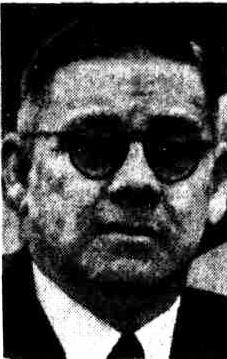
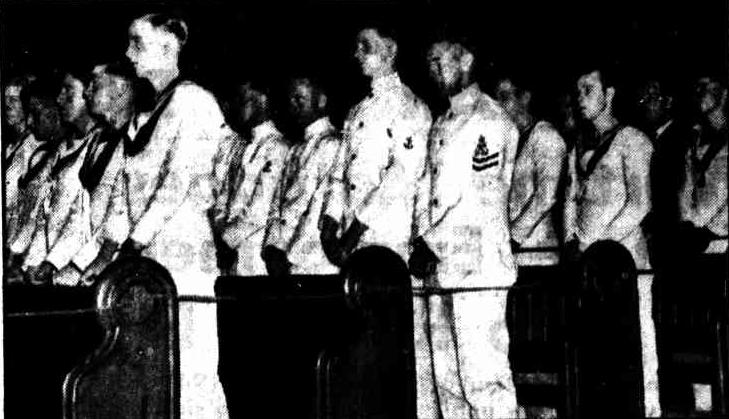
Mr. E. J. L. Hallstrom, who has offered £1000 in .start a new Sydney land. Officers and ratings listen attentively to an address by Archbishop Gil my at the Solemn Requiem Mass at St. Mary's Basilica to-day for men of H. M.A.S. Sydney. Commemorate Sydney's Exploits (1941, December 2). The Sun(Sydney, NSW : 1910 - 1954), , p. 3 (LATE FINAL EXTRA). Retrieved from http://nla.gov.au/nla.news-article230958654
NEW SYDNEY FUND TO OPEN AT ONCE. SYDNEY: 'The new Sydney fund' to replace HM.A.S. Sydney In Australia's naval strength Is to be opened Immediately the Lord Mayor (Alderman Crick) announced to-day.
Duty of New South Wales
In this nation-wide appeal will be to raise £1 000,000 by Christmas. The Lord Mayor of Melbourne (Cr. Beaurepaire) has already pledged his state to provide £500 000. Alderman Crick to-day sent telegrams to the Lord Mayors of all capital cities in the Commonwealth, inviting support.
Before
Before the announcement of the fund, more than £6000 was sent to the Lord Mayor at the Town Hall. This Included £5000 from Mr. Frank Albert, whose son, the late Cadet Midshipman Otto Albert, was a Geelong College colleague of the late Captain Joseph Burnett, of H.MA.S. Sydney, and £1000 from Mr. E. J. L. Hallstrom, North Sydney businessman. NEW SYDNEY FUND TO OPEN AT ONCE (1941, December 3). The Newcastle Sun (NSW : 1918 - 1954), , p. 3. Retrieved from http://nla.gov.au/nla.news-article167485535
THE NAME OF SYDNEY. Portrait of Viscount Sydney Unveiled. A portrait of Viscount Sydney, after whom Governor Phillip named Sydney Cove, was unveiled at History House, Young Street, Sydney, Headquarters of The Royal Australian Historical Society, on May 19th last. The portrait, which was copied from the original in the National Portrait Gallery, London, by Mr. W. A. Moir, was presented and unveiled by Mr. E. J. Hallstrom. Advt.—Will party who picked up black cocker spaniel return him to or come and get the 8-year-old boy who owns him. THE NAME OF SYDNEY. (1952, May 28).Construction (Sydney, NSW : 1938 - 1954), , p. 6. Retrieved from http://nla.gov.au/nla.news-article223548365
£200 prizes in play contest First prize of £100 cash is offered in the Playwrights' Advisory Board stage play competition, Sir Edward Hallstrom, Sydney philanthropist has provided total prize money of £200. Entries must be submitted by May 31, 1955. Details are available from Miss A. Sykes, Box 4220. G.P.O., Sydney. £200 prizes in play contest (1954, September 14). The Argus (Melbourne, Vic. : 1848 - 1957), p. 9. Retrieved fromhttp://nla.gov.au/nla.news-article23458235
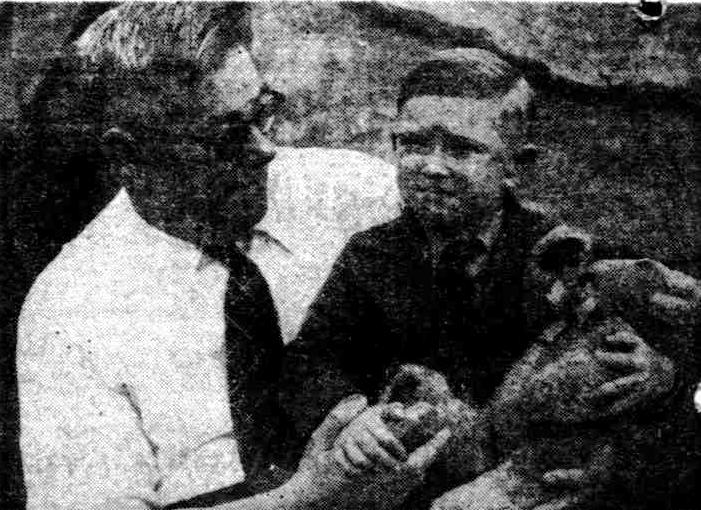
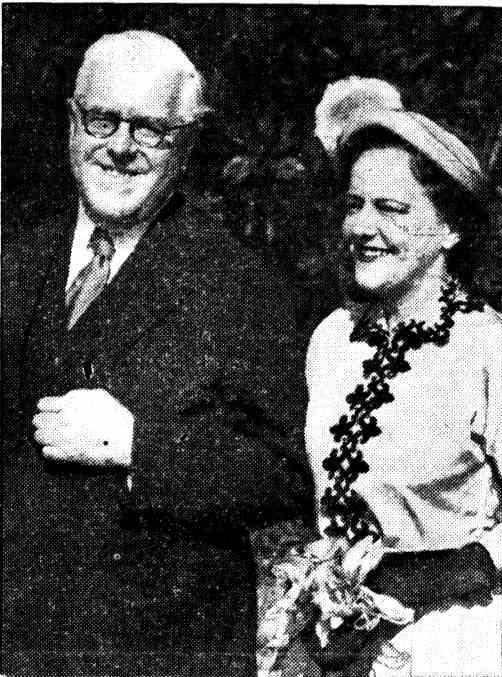 Well-known doctors wed
Well-known doctors wed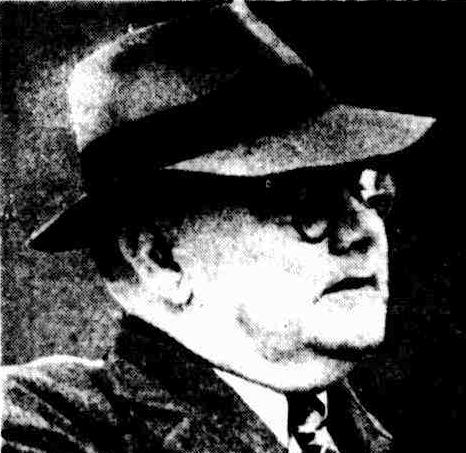 WHEN Edward Hallstrom heard that a new drug for treating tuberculosis had been discovered in America, recently, he opened his cheque-book and asked: "How much and when can we get it?"
WHEN Edward Hallstrom heard that a new drug for treating tuberculosis had been discovered in America, recently, he opened his cheque-book and asked: "How much and when can we get it?"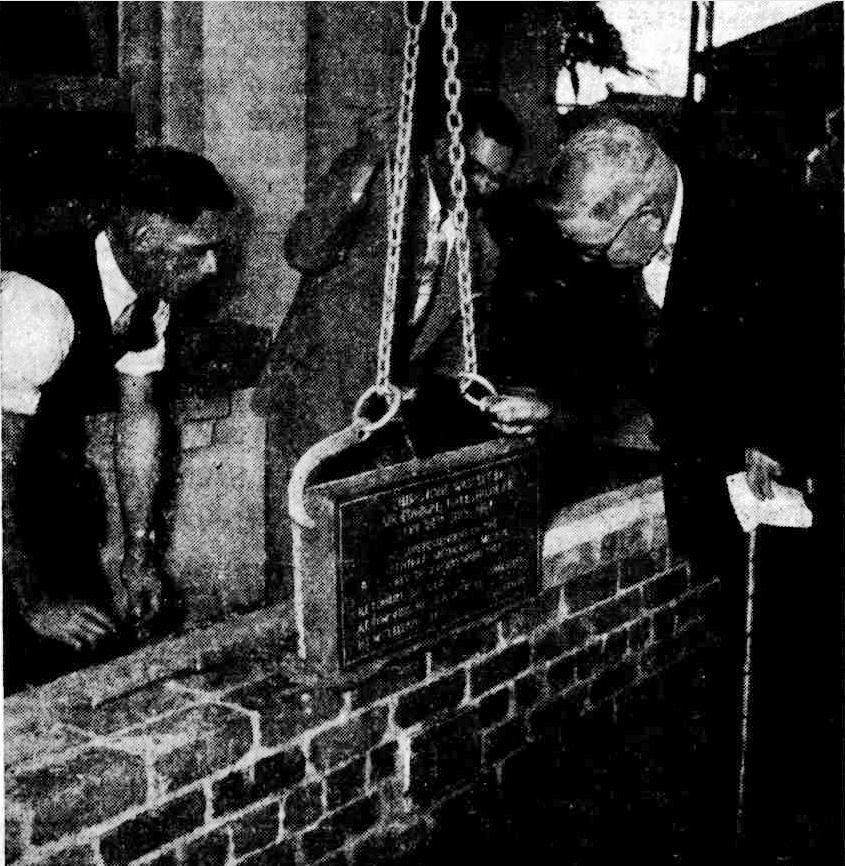
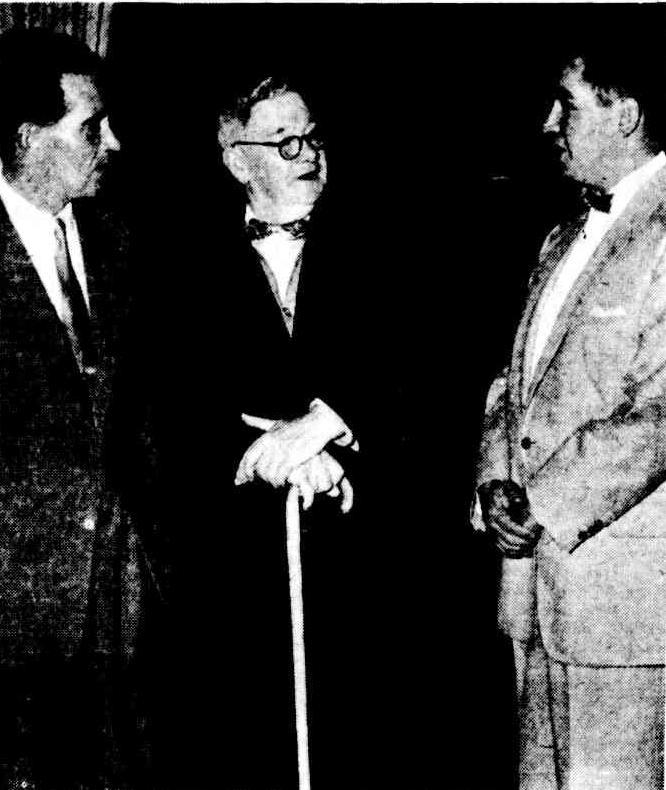
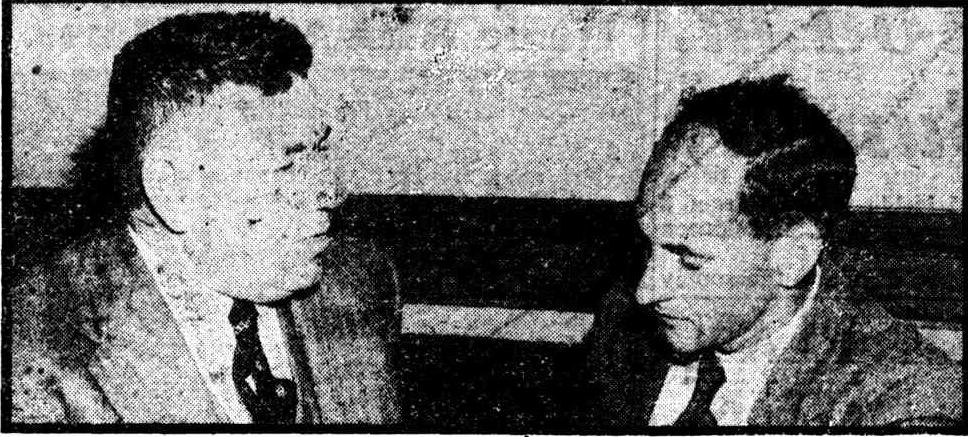
By KEN BLANCH, A "BRISBANE TELEGRAPH" STAFF WRITER
CRUSADER DEDICATED TO THE BATTLE AGAINST CANCER—
One day early this month Sydney refrigerator manufacturer Edward John Hallstrom got into his car, drove to Royal Prince Alfred Hospital, and offered the Board of Directors £50,000 to set up a cancer clinic. He did it as easily and naturally as if he had been taking a relaxing afternoon drive in the country. Giving away small fortunes is no novelty for this man of 60. In the past 20 years he has become Australia's best known philanthropist. He has given away so much money that he does not know what it would all add up to. A MILLIONAIRE in his own right, Hallstrom scoffs at the suggestion that he is generous. He once told me: "I do not give away my money. I invest it in the most important" of all causes — humanity."
E. J. Hallstrom is a short, stout, pleasant man who looks as though he could be Dr. Evatt's twin brother. In fact, during a visit to Brisbane in recent years he was mistaken by aerodrome employees for the Labour Party's leader. His philanthropic ventures have become so numerous that he recently handed over the control of his £l million refrigerator factory at Willoughby, in Sydney's northern suburbs, to his son, John, so that he could devote more time to them.
THESE activities' include cancer research, a clinic for "blue babies,"- zoos, and an experimental sheep station for natives in the highlands of New Guinea. The story of Hallstrom's life could, almost have come straight from a story book. He was born of English parents, and spent the early days of his childhood in Redfern, in the heart of Sydney's slums.
As a child he took an interest in animals — still his consuming passion today — and, while other children spent their pocket money on sweets, he used his to buy medicines and equipment to treat sick neighbourhood pets. Hallstrom went to school with the "dead end" kids of Redfern, and at 13 left to take a job in a furniture factory. He learned so quickly that at 18 he was managing the place, and at 21 had his own factory turning out cabinets for ice chests. By the time he was 21 he had foreseen, the up-and-coming modern refrigerator, and was making his own cheap kerosene-powered units. Now his Willoughby plant is the biggest in Australia. It turns out about 1,200 refrigerators a week.
HALLSTROM first became interested in cancer research when- he offered John Braund, who made the sensational claim in 1947 that he could cure cancer, £10,000 to set up a clinic. A week after his offer, Hallstrom denounced the medically unqualified Braund as a fraud. Feeling that he owed something to cancer sufferers, he then gave the money to the Royal Prince Alfred Hospital to set up a clinic. Excellent results from research at this clinic have prompted his latest offer. Hallstrom has . also setup a "blue baby" clinic at the Hospital which has been responsible for more than a dozen successful "blue baby" operations. HIS experimental sheep station at Nondugl, in the New Guinea highlands, resulted from a visit during which he decided that the natives did not have enough clothing or opportunity for development. He spent thousands of pounds to build station equipment and accommodation, and air freighted sheep into the wild mountain country at £20 a head. Hallstrom's love of zoos and animals has brought him to the chairmanship of Sydney's Taronga Park Zoo, recognised as one of the world's est. In recent years he has spent countless thousands of pounds , to secure for. the Sydney, London and New -York zoos some of the finest arid rarest animals in the world. Although Hallstrom is so free with his money, when it can help his fellow men, he is quick to spot any insincerity designed to defraud him. A SPECIAL small utility truck is sent to collect his "appeal" mail every morning, but he discards thousands of letters begging money. Yet I know of one case in which he built another house for a newly-married couple whose, new home was burnt out by a faulty refrigerator which did not even come from his factory.
Paradoxically, Hallstrom, who has given hundreds of thousands of pounds to help sick and suffering people, has never had good health. He suffers from chronic bronchitis, and has a comfortable bedroom adjoining his factory office so that he can retire when he has one of his frequent attacks. A trained nurse attends him constantly, and a formidable battery of telephones arid dictaphones flanks his bed so that he can continue working even when sick. Giving away fortunes is just a habit (1952, January 18). Brisbane Telegraph (Qld. : 1948 - 1954), p. 5 (CITY FINAL). Retrieved fromhttp://nla.gov.au/nla.news-article216528357
HALLSTROM GIFTS TO FAR WEST
The gift of four refrigerators for each of the Baby Health Clinic cars run by the Far West Scheme in the country has been offered by well-known philanthropist Sir Edward Hallstrom. "This is a very generous gesture and one that we most sincerely appreciate," said the General Secretary, Matron E. E. Hill, M.B.E. recently. "Our Sisters who run these Clinics have been working under great difficulties in the heat of the outback areas where they all attend to 800 babies each, every month. The refrigerators they have were installed when the cars first started running, more than 20 years ago. This magnanimous present will make conditions much better for them." HALLSTROM GIFTS TO FAR WEST (1958, January 17). Western Herald (Bourke, NSW : 1887 - 1970), p. 8. Retrieved from http://nla.gov.au/nla.news-article103987545
Taronga - A Zoo Ark
One of many articles focused on Sir Hallstrom love of all creatures great and small relates his having been a lover of animals since a small boy in the country, one of those children who would bring home stray animals or nurse ill ones back to health. He loved birds, had a private aviary at his home in Willoughby which housed exotic feathered delights. He loved every other animal too, finned, scaled, furred, whether from here or elsewhere.
Some ascribe this to wanting to ensure the Taronga Zoo was a success in attracting visitors but Mr. Hallstrom, as head curator, got rid of the miniature railway, elephant and camel rides and performing seals saying, “It’s a zoo, not a circus”..
The zoo was also a place where many a sick animal was nursed back to health. Mr. Hallstrom is the gentleman who is attributed for establishing a successful breeding program at Taronga, perhaps one of the earliest incidences of this now world renowned 'Zoo Ark'. This was discussed at a Royal Zoological Society of New South Wales Meeting, published in their 1945-1946 Annual Report (See under Extras below). Edward Hallstrom was a member and one of four Vice Presidents of this Society, which worked with the Taronga Zoo Trust Board, of which he was also a member. He was also the Royal Zoological Society of New South Wales first endowment member.
From that annual publication: 'An important and difficult problem related to rare and vanishing- birds and animals, and it seemed very necessary that breeding sanctuaries should be developed in this country. Mr. Brown, the Secretary of the Trust, was now in Central Africa securing giraffes and zebras, lions and elephants mayhao also, for the Zoo. At the present time there are only two giraffes in Australian Zoos, one in Taronga and one at
Perth, W.A. These are also becoming scarce in their native land, and it has become imperative to breed them in this land. There are great difficulties in the breeding of wild animals in zoos, as the parent is apt to kill the young soon after birth unless special individual care is taken. He suggested scholarships should be created in each State for
the study of breeding not only the rare members of the Australian, but also the rare and vanishing wild animals of other countries, so that the species can be kept alive in zoos. This should be a national responsibility subsidised by the Commonwealth, special enclosures to be created and special research students to be employed to watch the breeding. This would not really be an innovation, as certain phases of health are already under control and all animals have to be quarantined under the Health Departments of the various States. That such is possible has been shown elsewhere, the Whipsnade Experiment proving a wonderful success, and it must be done soon here, as through settlement our wild life was rapidly decreasing and numbers are vanishing, some already extinct. He hoped that this Society will co-operate in this aim, as it always has in the past, and he hoped to see the Society's own aim, of a Zoological House, soon fulfilled.
The motion was seconded by Mr. E. J. A. Hallstrom, who also paid tribute to the great work done by the late Secretary, Mr. A. F. Basset Hull, and hoped that his wishes with regard to the building would soon be carried out. There was urgent need as, until the Society owned its own meeting-centre its progress would be much handicapped.
The motion was carried by acclamation. '
Although later ridiculed by those who think you need degrees in everything to be accredited to think, and criticized for his methods, Mr. Hallstrom's methods worked, he did save thousands of animals throughout his life by being 'nurse' himself. He also was known for being a voracious reader of everything so that, even if he did have to leave school at age 13, he was still a lifelong learner who didn't think he knew everything, ever.
Although curious items appear, such as this July 1941 snippet stating "A Macaw Feather in Sydney's Hat - A macaw at Willoughby is the first bred in Australia and gives his tail for ladies' hats. THE Red and Yellow Macaw pictured on this page was bred by Mr. E.Hallstrom ...." RED AND YELLOW" macaw, bred by Mr. E. Hallstrom, of Willoughby, is worth £50. " The Sun (Sydney, NSW : 1910 - 1954) Sunday 27 July 1941 p 3 Article Illustrated - and all birds do molt, the accepted or usual rate for birds such as this discarding feathers is two per year so even if Mr. Hallstrom's birds did live between 40 and up to 70 years, as some have been recorded, that's still not too many tail feathers.
Edward Hallstrom loved zoos - he had one in the form of beloved birds at his home in Willoughby, installed another at Bayview, and set aside bush areas as 'zoos without cages' in the form of flora and fauna nature reserves.
This snippet from a long article ' Doesn't know how much money he's given away' by Blake Brownrigg states: He first owned a dog. Gradually he acquired white mice, guinea pigs, cats, rabbits, parrots, and other birds - his first zoo. He doesn't drink, smoke, or gamble. With all his wealth and power, he is one of the least ostentatious men I have ever met. Doesn't know how much. (1951, October 22). Barrier Miner(Broken Hill, NSW : 1888 - 1954), p. 4. Retrieved from http://nla.gov.au/nla.news-article48658529
Sydney, 10th January, 1941.
IT is hereby noticed that, in accordance with the provisions of section 28 of the Crown Lands Consolidation Act, 1913, Edward John Lees Hallstrom, Esquire, is hereby appointed (in the place of Mr. A. F. Basset Hull, resigned) as a trustee of the portions of land at Bradley’s Head Port Jackson, hereinafter particularised, namely—
The areas of 43 acres 1 rood 5 perches, 5 acres 1 rood 24 perches, 2 acres 1 rood 9 perches and 9 acres, dedicated 24th April, 1912, 22nd April, 1914, 29th November, 1918, and 14th October, 1932, respectively, for Zoological Gardens and Additions thereto, and known as Taronga Park. The area of 98 acres 2 roods 17 ½ perches, dedicated 29th November, 1918 for Public Recreation, and known as Ashton Park. A. W, YEO, Minister for Lands. Government Gazette Notices (1941, January 10). Government Gazette of the State of New South Wales (Sydney, NSW : 1901 - 2001), , p. 65. Retrieved from http://nla.gov.au/nla.news-article220094297
Work will commence in the New Year. New offices are being erected at Taronga Park Zoo to replace those destroyed by fire last year. Plans were prepared by the Government architect. The building will be officially opened early in 1945. The entire cost, £8,500, has been defrayed by Mr. E. J. L. Hallstrom. OPPORTUNITIES. (1944, December 20).Construction (Sydney, NSW : 1938 - 1954), , p. 13. Retrieved fromhttp://nla.gov.au/nla.news-article222869712
NEW OFFICES, TARONGA ZOOLOGICAL PARK, SYDNEY. DESIGNED BY GOVERNMENT ARCHITECTS' DEPARTMENT.
After the destruction of the offices at Taronga Zoological Park by fire, and faced with an expense for rebuilding and reoccupation, the Board, or the Zoo Trust, must feel exceedingly grateful to Mr. J. E. Hallstrom for coming forward with his offer to pay for the rebuilding of these offices. In gratitude and as recognition for this act of grace, the building now bears his name. It is designed in the modern Georgian manner on exceedingly simple lines. When the open flagstone court is lined with trees and tub foliage, as it. will be, the approach, which leads to a stoneflagged porch, will be rendered more inviting. The foliage will act as a contrasting foil to the building, which is in pastel shades and light tones. of colour. The walls are of mottled light cream bricks, with a tiled roof in light red to match the adjoining building. The woodwork has been painted in cream colour. The gable ends and soffit of the eaves are in light blue. On the ground floor are the Administrative Offices and upstairs accommodation is for temporary and permanent staffs, with lockers, lavatories, rest rooms, etc. The walls are rendered internally in cement. "The Zoo" has developed into what is regarded far and wide as the most beautiful thing of its kind in the world.
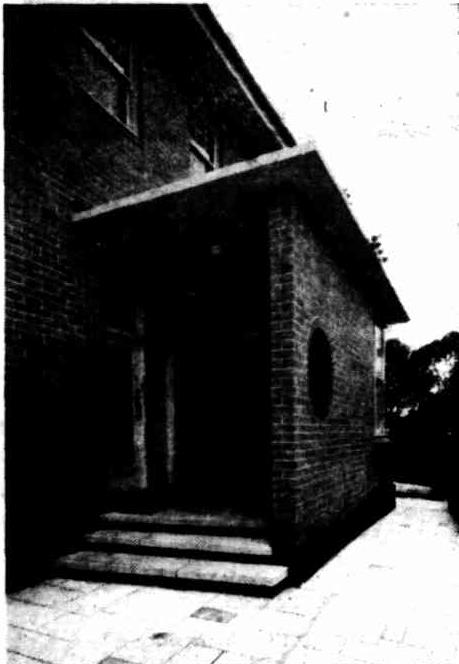
THE SHELTERED PORCH.
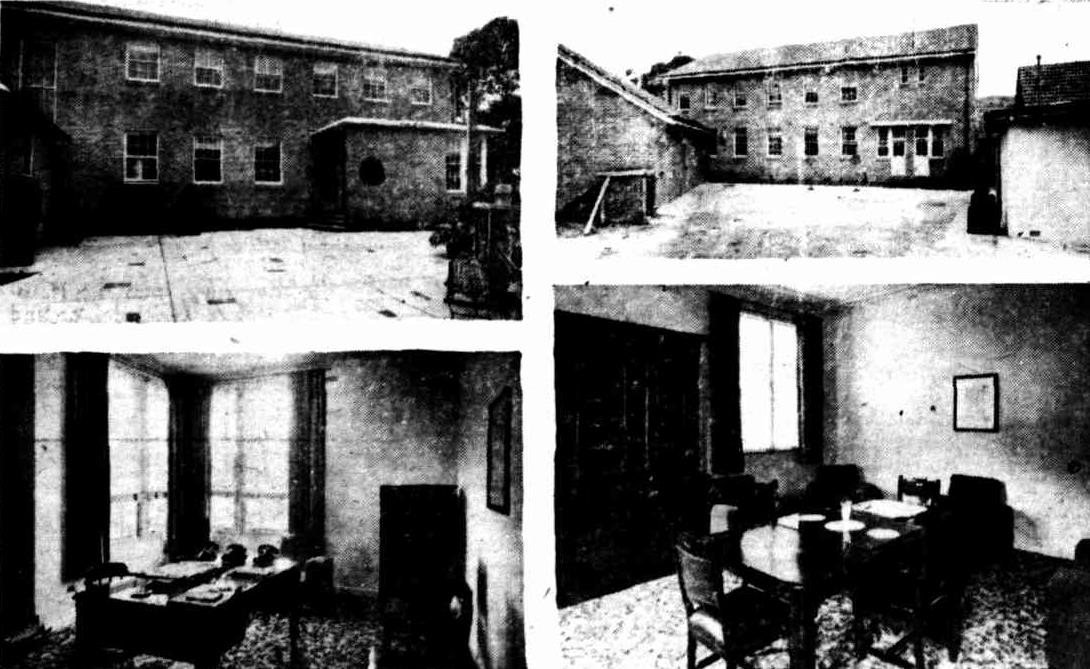
FOUR VIEWS OF THE NEW OFFICES, TARONGA ZOOLOGICAL PARK, SYDNEY.
NEW OFFICES, TARONGA ZOOLOGICAL PARK, SYDNEY (1945, September 5).Construction (Sydney, NSW : 1938 - 1954), , p. 2. Retrieved fromhttp://nla.gov.au/nla.news-article223545799
Mr. Hallstrom seemed to want to have lots of white or albino animals. Older Pittwater residents can still recall albino kangaroos being brought to his 'sanctuary' at Bayview(these eventually ended up on 'Hallstrom Island - part of the Snowy Scheme - see below) but he also brought these rare speciemn in from overseas as well, on the other side, export black swans to Italy - 'From Como to Como' features in a British Pathe film - perhaps they were really from Dee Why or Narrabeen...at any rate, he knew the way to keep people visiting the zoo was to allow them to see something they may never have seen before - only in this way would they be able to keep up with the costs of housin or upgrading facilities, feeding all those animals, and meeting the wages of those hired to look after them. Recent announcements by the current NSW Government of investing millions to improve what is the 2016 Zoo Ark loved as Taronga Zoo are some indication that it has never been cheap to meet the needs of running a proper zoo:
White Koala, Monkey for Zoo: Taronga Park now has a white koala (a perfect albino male, two years old), and a white monkey will reach there soon. Deputy president of the Zoo Trust-(Mr. E. J. Hallstrom) said the koala was captured- "somewhere" in NSW.
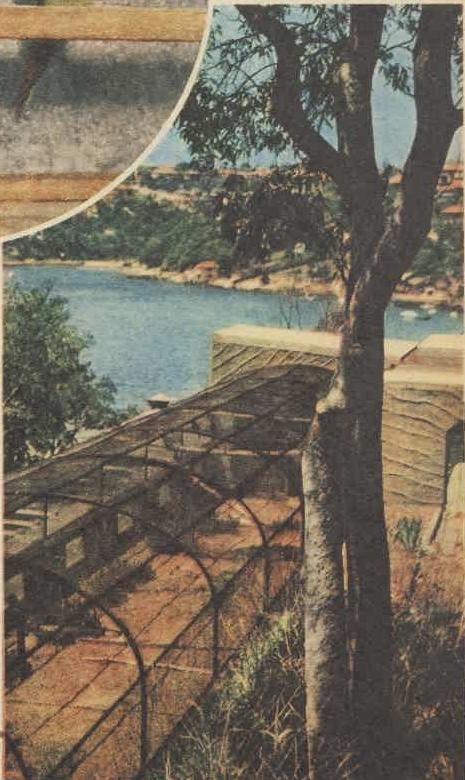 "It is still fairly wild, and gives anyone a clout who goes too close," said Mr. Hallstrom. " We will do all we can now to breed more like him." The white monkey reached Sydney from South Africa in the steamer Tai Ping Yang. Like the koala, it, too, is an albino male, two years old. "You might see only ‘one' among several million monkeys," said Mr. Hallstrom. Two rare black-maned lions, a tapir, leopard, cheetah, and flock of South African birds, were also aboard the Tai Ping Yang. BITS AND PIECES (1947, November 7).Warwick Daily News (Qld. : 1919 -1954), , p. 2. Retrieved from http://nla.gov.au/nla.news-article191856455
"It is still fairly wild, and gives anyone a clout who goes too close," said Mr. Hallstrom. " We will do all we can now to breed more like him." The white monkey reached Sydney from South Africa in the steamer Tai Ping Yang. Like the koala, it, too, is an albino male, two years old. "You might see only ‘one' among several million monkeys," said Mr. Hallstrom. Two rare black-maned lions, a tapir, leopard, cheetah, and flock of South African birds, were also aboard the Tai Ping Yang. BITS AND PIECES (1947, November 7).Warwick Daily News (Qld. : 1919 -1954), , p. 2. Retrieved from http://nla.gov.au/nla.news-article191856455
Jaguar dies
No longer will an old jaguar at Taronga Park Zoo frown and growl for wide-eyed kiddies. It died yesterday from cancer. Chairman of the Taronga Trust (Mr. E. J. Hallstrom) said that the animal had been ill for a long time. Another jaguar has been bought to replace it. SPOTLIGHT ON THE NEWS (1949, June 3). The Sun (Sydney, NSW : 1910 - 1954), , p. 4 (LATE FINAL EXTRA). Retrieved fromhttp://nla.gov.au/nla.news-article229769730
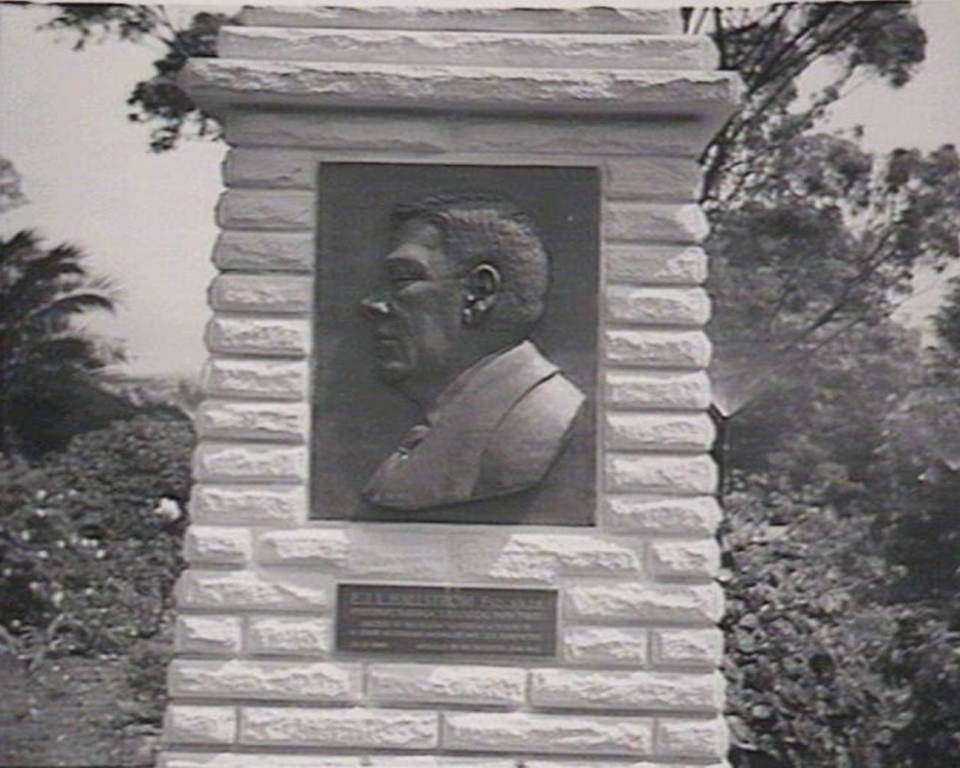
Sir Edward Hallstrom- Date of Work 11 & 12/1950 Government Printing Office 1 - 50514 From NSW Govt Printer series - Taronga Park Zoo - monuments & memorials at Taronga Zoo (Sydney, N.S.W.) Image no.d1_50514, courtesy State Library of N.S.W., The Mitchell Library.
John Hallstrom becomes a more official part of the Taronga Zoo work:
Sydney, 9th April, 1948. IT is hereby notified that, in accordance with the provisions of section 26 of the Crown Lands Consolidation Act, 1913,John Edward Hallstrom, Esq., is hereby appointed (in the place of Professor W. J. Dakin, resigned) as a trustee of the portions of land at Bradley's Head, Port Jackson, hereinafter particularised, namely:—
The areas of 43 acres 1 rood 5 perches, 5 acres 1 rood 24 perches, 2 acres 1 rood 9 perches, and 9 acres, dedicated 24th April, 1912, 22nd April, 1914, 29tli November, 1918, and 14th October, 1932, respectively, for Zoological Gardens and Additions thereto, and known as Taronga Park.
The area of 98 acres 2 roods 17 ½ perches, dedicated 29th November, 1918, for Public Recreation, and known as Ashton Park. P. 48-2 513.
W. F. SHEAHAN, Minister for Lands. Government Gazette Appointments and Employment (1948, April 9). Government Gazette of the State of New South Wales (Sydney, NSW : 1901 - 2001), , p. 867. Retrieved from http://nla.gov.au/nla.news-article224778057
Edward Hallstrom became to be considered such an authority on how to set up and run a zoo his advice was sought by one of Australia's oldest zoos:
Old Grey Nurse
I SEE where Mr. E. J. Hallstrom has offered £75 for a grey nurse. That's a lot of money. For that amount he can have my Aunt Bertha. She's not only grey, but she's also a matron, which is infinitely better value than a nurse. Incidentally, his offer has c
"Where's Joe?"
If Mr. Hallstrom really wants to know where the best sharks go in spring he might have a look around a few Sydney fish cafes. We've had a lot of bad luck chasing around for a shark for Mr. Hallstrom. Last week the family landed a whopper at Bondi Beach. There was Mrs. Davey with a line around his tail, Aunt Bertha administering anaesthetic at the front end and the rest of us screaming and cheering. It looked like the money. Suddenly somebody looks around and says, "where's Joe??'
Down in mouth
You guessed it. Brother Joe's been down in the mouth for weeks. Now he was down in the shark's mouth. As Aunt Bertha pointed out, that increased the value of the shark by a few bob, but my wife wouldn't have it. She said we'd have to get Joe out of the shark bec
9FT. SHARK FOR ZOO
A 9 feet 6 inch shark, netted off Austinmer Beach on Friday, arrived at Taronga Park Zoo last night. It was in a special steel case. Chairman of Taronga Park Trust E. J. Hallstrom said last night: "The shark will be on exhibition tomorrow." The grey nurse shark was netted off Austinmer Beach by the crew of the meshing trawler Kembla. It weighs 500 pounds.Four men will share in the £100 offered by Mr. Hallstrom if the shark lives seven days. 9FT. SHARK FOR ZOO (1950, October 1).The Sun (Sydney, NSW : 1910 - 1954), , p. 5. Retrieved from http://nla.gov.au/nla.news-article229630100
Shark Netted at Austinmer In Taronga Zoo
The 8501b. grey nurse shark, c
IF SHARKS LIVE WILL BRING £150
SYDNEY, October 1.— The Taronga Park Zoo aquarium now has two sharks in Its pool. One is groggy and the other is rare. The Taronga Park Trust chairman Mr. E. J. Hallstrom, today accepted the aquarium's second shark in two days. The first, an 8ft. 6in. 850-lb. grey nurse, was caught at Wollongong last Friday. Fishermen towed it 10 milees to Port Kembla. Mr. Hallstrom sent eight men in a truck, and a water tank, for the shark, which reached Taronga on Saturday. If it lives seven days the fishermen will collect £75. Latest reports claim that the shark is groggy. The second shark arrived at the aquarium today. Four shark meshers caught it off South Curl Curt Beach. It is 7 ft. 6 in. and is a man-eater. Experts said that itwas a rare black-tailed porbeagle shark, seldom seen in these waters. If the porbeagle lives seven days the four meshers will also collect £75. IF SHARKS LIVE WILL BRING £150 (1950, October 2). Maryborough Chronicle (Qld. : 1947 - 1954), , p. 3. Retrieved from http://nla.gov.au/nla.news-article147951523
The porbeagle (Lamna nasus) is a species of mackerel shark in the family Lamnidae, distributed widely in the cold and temperate marine waters of the North Atlantic and Southern Hemisphere. The meat and fins of the porbeagle are highly valued, which has led to a long history of intense human exploitation. However, this species cannot sustain heavy fishing pressure due to its low reproductive capacity. Direct commercial fishing for the porbeagle, principally by Norwegian longliners, led to stock collapses in the eastern North Atlantic in the 1950s, and the western North Atlantic in the 1960s. The porbeagle continues to be caught throughout its range, both intentionally and as bycatch, with varying degrees of monitoring and management. The International Union for Conservation of Nature (IUCN) has assessed the porbeagle as Vulnerable worldwide, and as either Endangered or Critically Endangered in different parts of its northern range. The maximum lifespan of this species appears to be 30–40 years in the Atlantic, but could be as much as 65 years in the South Pacific. - from - https://en.wikipedia.org/wiki/Porbeagle
Spotted baby
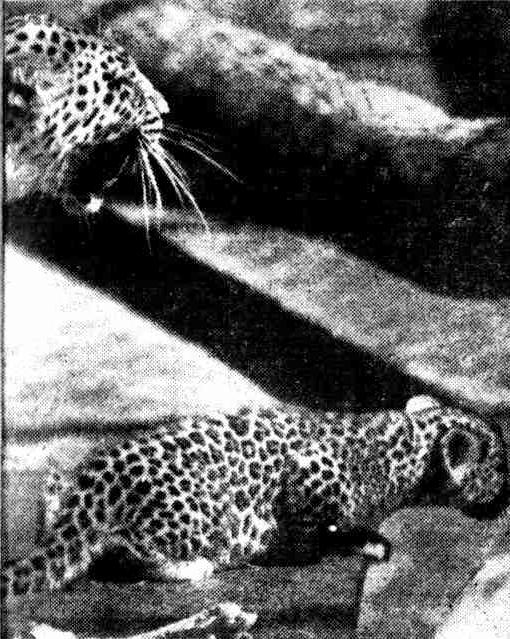
PADDY the leopard cub is zoo baby number 2401 — the latest arrival at Taronga Park. He is the 2401st animal baby successfully born and bred at Taronga Park since the zoo was shifted there from Moore Park 35 years ago — and fourth of his spotted kind. Paddy, who made his debut in the Big World only a fortnight ago — after a few weeks in the dark recesses of his mother's den — is one of the friendliest leopard cubs lever bred at the zoo. He was so friendly with the Sun cameraman that Ma turned on him. The odd thing is that Paddy's mother is herself the tamest leopard ever seen in Taronga Park. She was given to Taronga Park Trust Chairman Hallstrom by the Johannesburg Zoo, and normally allows herself to be hand fed. Said a Zoo keeper today: "We can't make the old lady out. She's as docile as a tabby, but she seems to have other ideas for young Paddy's future behavior." Spotted baby... Impact! Firefly breaks back on H.M.A.S Sydney (1951, March 1). The Sun (Sydney, NSW : 1910 - 1954), , p. 5 (LATE FINAL EXTRA). Retrieved from http://nla.gov.au/nla.news-article230068409
Hallstrom To Pay For Virus Study
Mr. E. J. Hallstrom said last night that he would meet the cost of the university's sending a scientist to Mildura to investigate the effect of myxomatosis on marsupials. Mr. Hallstrom is vice-president of the Fauna Protection Board.
The Dean of the Faculty of Medicine, Professor H. R. Dew, said that Dr. A. Bolliger, considered Australia's leading authority on marsupials, would carry out the investigation. Dr. Bolliger said he hoped to fly to Mildura on Sunday.
"It is time some proper scientific examination was made," he said. "We have appealed to everyone in the district to send us in a specimen of one of these infected animals, birds, or fish, but not one specimen has been sent in," he said.
The State Director-General of Health, Dr. E. S. Morris, last night denied a report in a Sydney newspaper that he had said doctors were "completely baffled by the encephalitis virus."
"SENSATIONALISED”
"What I did say," he declared, "was that there had been an enormous amount of research done all over the world on virus diseases, including encephalitis and poliomyelitis, but, so far, no one has been able to discover a cure or how the diseases are transmitted in epidemic form.
"When this appeared in print it was sensationalised."
The Minister for National Development, Mr. R. G. Casey, said in Canberra that the myxomatosis virus had not been tested on humans, but on some higher forms of monkeys, which reacted in a similar manner to humans to the virus. The virus had been tested on a number of domestic animals as well. Mr. Casey repeated that leading scientists in Australia had stated that the myxomatosis virus did not affect humans. Hallstrom To Pay For Virus Study (1951, March 2). The Sydney Morning Herald (NSW : 1842 - 1954), , p. 10. Retrieved from http://nla.gov.au/nla.news-article18202068
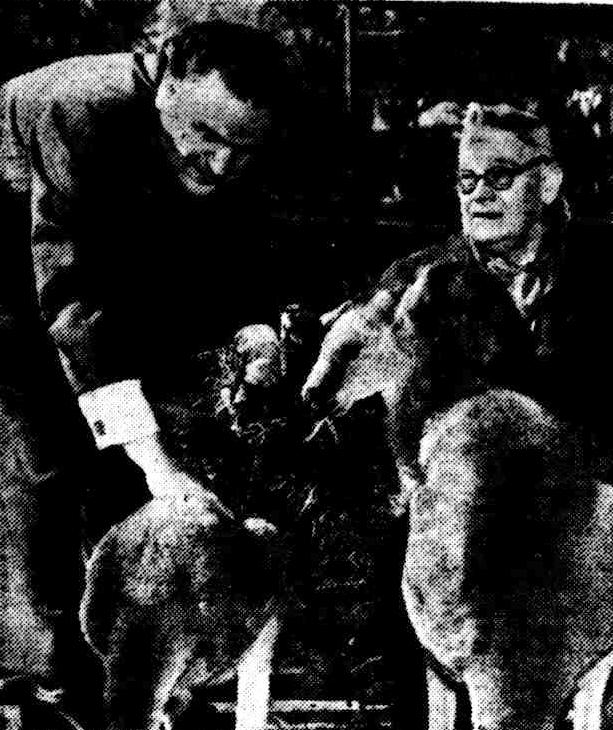
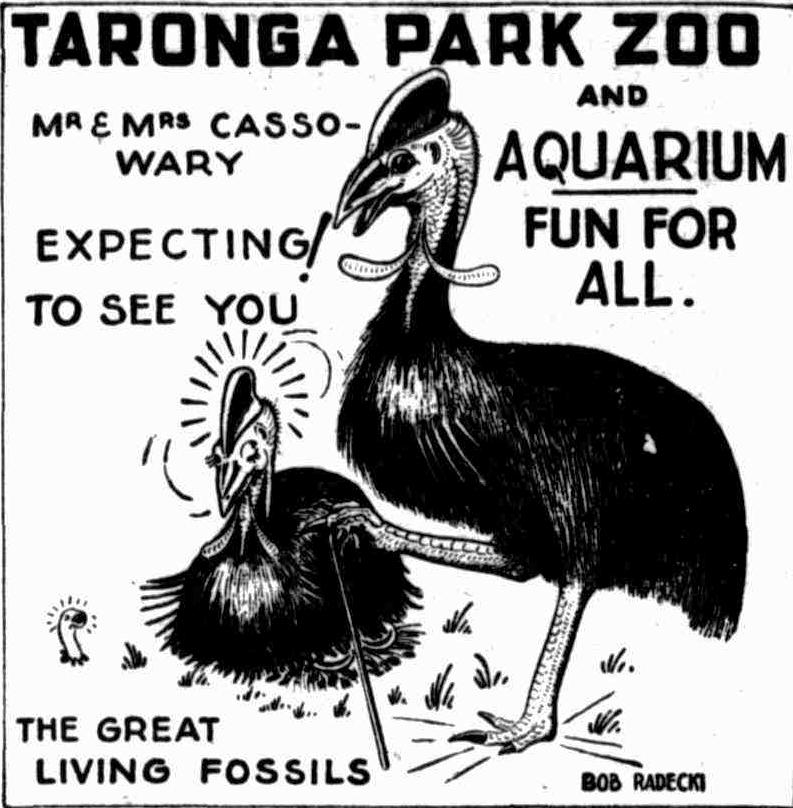
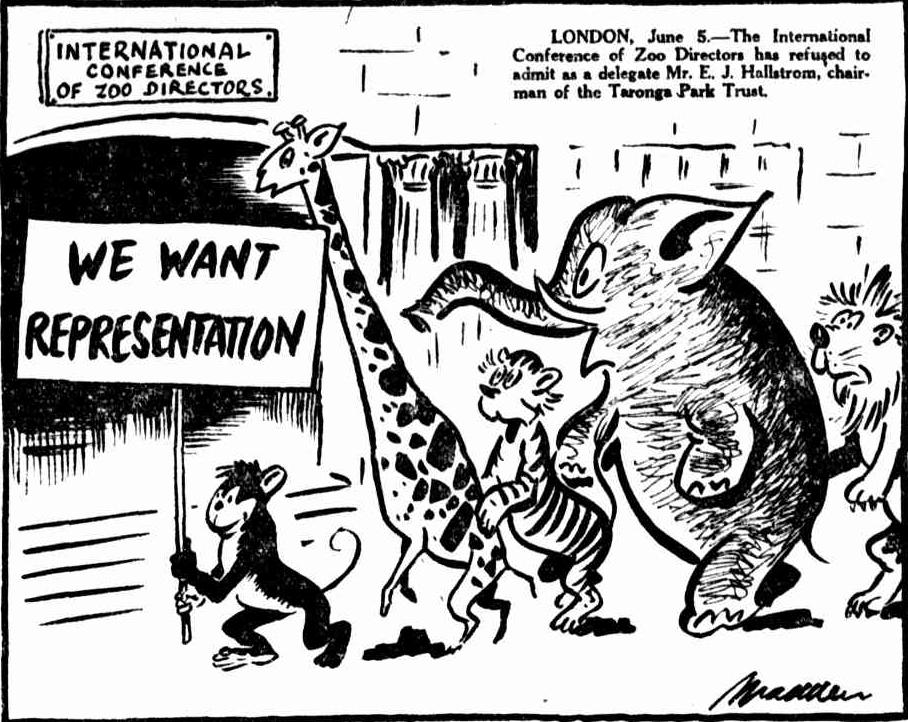
TARONGA PARK LIONS
Mr. Hallstrom Replies
Sir,-My attention has been drawn to three letters in the "Herald," September 4, under the heading,''Lions for Circuses." I feel that had the writers been aware of the actual facts their letters would not have been written. So that they may know the true position, I am taking this opportunity of setting the facts out, and will be obliged if you will be so good as to publish my letter to remove the erroneous misconception that has arisen. . .
One letter, "Be Fair to Beasts," in my opinion, is particularly damaging, unkind, and untrue, and is not being kind to a human being whilst claiming to "be fair to beasts." The real facts as set out in recent newspaper articles were perfectly clear and could not reasonably give rise to the statement, "Lions for Circuses."
The plain and interesting fact is that I was offered lions in Africa for £200 each, and I have had several inquiries in Africa for lions from Australia. Nothing more than that. No promise on my part to sell lions or to buy them. It was interesting news and should not have been capable of distortion. There is no project in existence for the selling of lions by me to circuses.
The other item of news was that Chicago Zoo offered to sell Taronga Park five kangaroos. I consider that particularly interesting, and to offer to sell us kangaroos amounted to "taking coal to Newcastle."
Even if there were some arrangement to sell or dispose of surplus stock in Taronga Park, surely I could be trusted with the destiny of a few animals that come under my care there.
Perhaps, the writers of the letters do not know that both in my private capacity, and at Taronga Park, I am continually having birds and animals sent to me or placed under my care because of their ill-health or injury. These birds and animals are restored to health, returned to their owners, or returned to their natural habitats.
From injured koala bears sent to me, I have built up a sanctuary where these injured creatures are now breeding, and are under the jurisdiction of the Fauna Board.
E.J.L. HALLSTROM (F.R.Z.S.). Mosman. Letters (1950, September 5). The Sydney Morning Herald (NSW : 1842 - 1954), p. 2. Retrieved from http://nla.gov.au/nla.news-article18176586
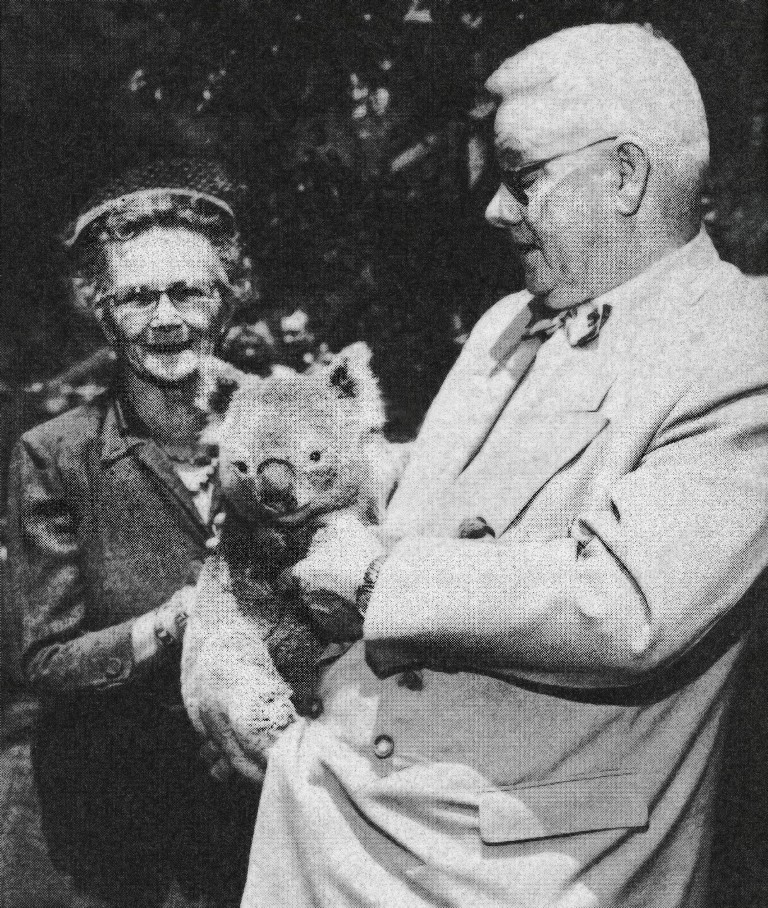
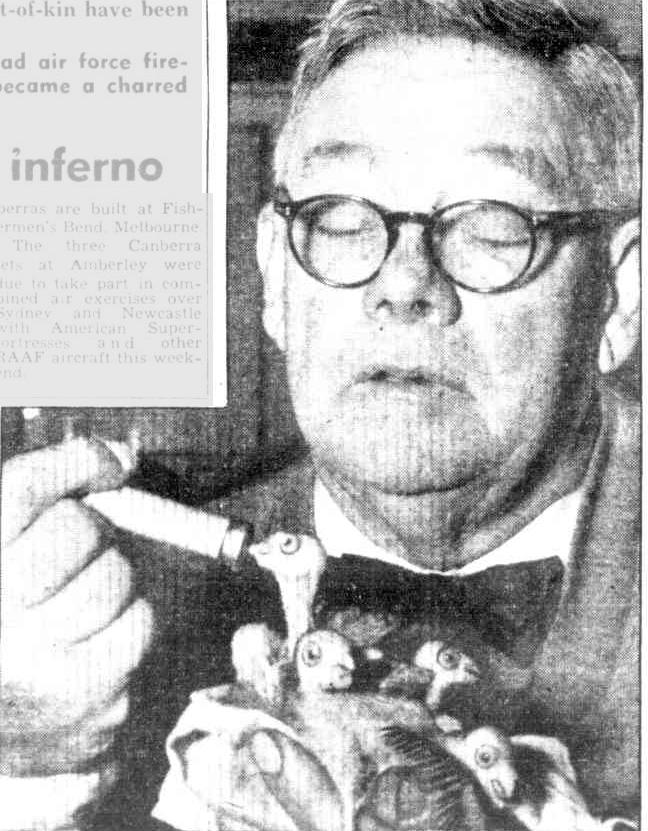
ACT OF PARLIAMENT ASSENTED TO.
Legislative Council Office, Sydney, 20th September, 1956.
IT is hereby notified, for general information, that His Excellency the Lieutenant-Governor has, in the name and on behalf of Her Majesty, this day assented to the undermentioned Act passed by the Legislative Council and Legislative Assembly of New South Wales in Parliament assembled, viz.:—
Act No. 19, 1956.—"An Act to dedicate Taronga Zoological Park as a public park; to provide that the existing trustees of that Park shall be deemed to have been appointed under the Public Parks Act, 1912, as amended by subsequent Acts; to extend the term of office of Sir Edward Hallstrom as a trustee of that Park; to amend the Crown Lands Consolidation Act, 1913, the Public Parks Act, 1912, and certain other Acts in certain respects; and for purposes connected therewith." J. R. STEVENSON, Clerk of the Parliaments. ACT OF PARLIAMENT ASSENTED TO. (1956, September 28). Government Gazette of the State of New South Wales (Sydney, NSW : 1901 - 2001), , p. 2829. Retrieved fromhttp://nla.gov.au/nla.news-article220390833
Can Boongarry, tree-kangaroo, jump 100 ft. to the ground? FOR YOUNG AUSTRALIANS By NORMAN McCANCE
We have a racehorse somewhere in the family called Jean Garry, a black mare that "also ran" at Caulfield, and her sire was a steeplechaser most aptly called Boongarry, which is the native name for the Tree Kangaroo, the world's champion long distance jumper.
Before I tell you something about this Boongarry —the marsupial, not the horse— may I explain that you can have too much of a good thing, and see so many rarities that they, become no longer rare. I have in mind a remarkable botanical curiosity called a Maidenhair Tree, or Gingko, which is; a relic of a wonderful period in earth's history when all vegetation was ferns. It is, therefore, a living fossil. It is a sacred Japanese tree and there were once only three in Melbourne. But someone with lots of money ordered a whole avenue of them to be propagated and planted in the Dandenong Ranges. The curio became a commonplace.
Common in Sydney
There was once a Tree-climbing Kangaroo in the Melbourne Zoo, and we used to gaze upon it as a great wonder. But Sir Edward Hallstrom, the great benefactor of the Taronga Park Zoo in Sydney, ordered about 20 pairs to be brought from New Guinea, and the last time I was at Taronga Park I had the same feeling of nightmare as I had when I walked down the Gingko grove. I saw in Sydney so many Boongarries that one of the rarest marsupials in Australia became almost as common as guinea pigs —and about as interesting. I suppose if you papered your dining room with Corot's "Bent Tree." a wonderful picture would become simply a pattern on the wall. And fancy a hundred Mona Lisas smiling.
Handsome
There are only two kinds of Tree-climbing Kangaroos in Australia — the true Boongarry or Lumholtz Tree-Kangaroo named after Carl Lumholtz, who discovered it in the Herbert River district of Queensland during an exploration; and the smaller species, Bennett's Tree Kangaroo. Boongarry is a very handsome creature with grey coat and creamy waist-coat, and a coal black face. He can cover the ground quite nimbly, but his home and hunting-grounds are in the tree-tops. He, if hard pressed or if someone cuts down the tree, can leap from these arboreal heights 60ft. to the ground in one great jump, and no other living creature can challenge this phenomenal record. It has even been said that Boongarry can land safely from a tree-top 100 ft. from the ground, but I think we have to draw the line somewhere. Some student in physics with a knowledge of the acceleration rate of falling bodies may calculate the force of Boongarry's impact upon earth after a leap from such a height. If he assures us that no living bone arid muscle could I withstand such a shock, I will believe him.
Different
Boongarry is simply a kangaroo that has gone aloft and adapted himself for a tree-top existence.) In so doing he has developed marked differences from his ground-living relatives. His fore and hind legs are nearly equal in development, because all four are in use in tree-climbing, whereas the ordinary kangaroo's hind legs are abnormally developed for jumping, while its forelegs have dwindled almost to the degree where they are just a support for the paws. In the tree-climbers, the hind feet are broad and the second and third toes are quite well developed and not just appendages of the great toe as in true kangaroos. Moreover, the claws of the fourth and fifth toes are strongly curved for clasping boughs. Unlike possums, Boongarry does not use his tail to grip the boughs of a tree for greater safety but maintains balance with -his fore and hind Jimbs while his tail hangs loosely down beneath him. It would be a gigantic tree- python that could challenge Boongarry in the tree-tops, and I cannot think of any other enemy that would cause him to take prodigious leaps of 60 ft. or 100 ft.
What 100 ft. is
The green and gold tree-python of New Guinea could scarcely frighten a ring- tail possum, anyhow, being only about four feet long. So I think that when Boongarry comes down to earth he would very likely do it as you or I would by climbing slowly and safely down to the bottom branches, and dropping neatly down without unnecessary risk. Have you any idea of what a 100 ft. jump would be? From about the 9th floor of the Manchester Unity Building to the pavement in Swanston Street opposite the Town Hall ! Can Boongarry, tree-kangaroo jump 100 ft. to the ground? (1953, December 30).Weekly Times (Melbourne, Vic. : 1869 - 1954), , p. 28. Retrieved from http://nla.gov.au/nla.news-article225647855
Black Swans From Australia To Italy 1962 - British Pathe video
Mr. Hallstrom would also take animals that were not wanted elsewhere - sometimes with tragic results. An elephant named 'Nellie' fell into a moat and broke her back at the elephant enclosure decades before elephants were housed in more suitable 'fields':
Nellie The Elephant Fractured Spine - Big Loss For Taronga Park
Sydney, May 23. — A fractured spine caused the death of the Taronga Park Zoo elephant Nellie on Saturday. Officials said this after a post-mortem examination yesterday. Nellie fell into the moat that guards the Zoo's elephant house on Saturday. The president of the Taronga Park Trust, Mr. R. J. Hallstrom, said last night that the post-mortem examination had been held yesterday instead of Monday to prove or disprove the theory that Nellie had been strangled. He said that filling in of the moat would start today. The moat would be replaced with a fence of steel and concrete strong enough to withstand a 20-ton blow. Large crowds congregated at the elephant house yesterday. The elephants missed Nellie, a keeper said. 'That's them singing out to her now.' he added. 'She was a good elephant.' Nellie The Elephant Fractured Spine (1949, May 24). Barrier Daily Truth (Broken Hill, NSW : 1908; 1941 - 1954), p. 1. Retrieved from http://nla.gov.au/nla.news-article140899144
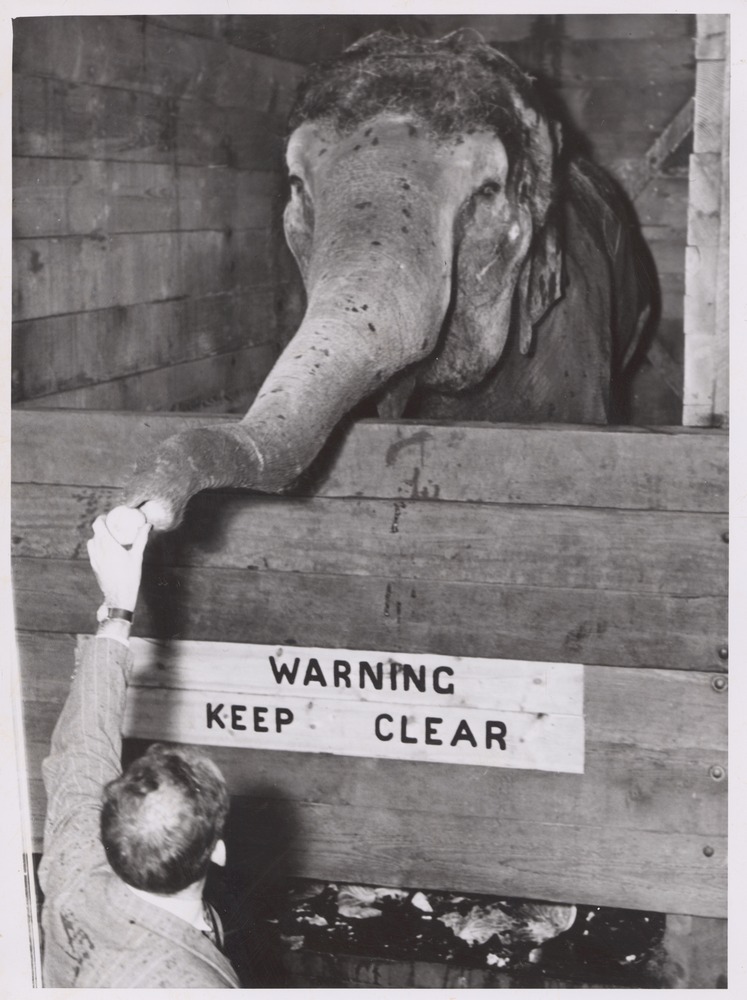
Nellie, rogue elephant aboard the "Arcadia" accepts an apple from Mr. J. E. Hallstrom who brought her from Sth Africa [picture] 1948 Argus Newspaper Collection of Photographs, courtesy State Library of Victoria. http://handle.slv.vic.gov.au/10381/221740
Taking animals could no longer be where they once were also brought a few celebrities of the animal world to the zoo:
PLANS TO REFORM RAKE CHIMP
DARWIN, Tuesday.—Sydney philanthropist Sir Edward Hallstrom plans to reform Jimmy the chimpanzee. Sir Edward said he would break Jimmy of his drinking habit when he got him to Taronga Park. Sir Edward is in Darwin to get Jimmy back from the remote Elcho Island Mission station. Jimmy, formerly the star chimpanzee of the Tarzan films, has been voyaging around the Pacific with actor yachtsman John Calvert. The voyage ended when the Sea Fox, Calvert's yacht was beached at Elcho Island. Sir Edward said Jimmy would be allowed a ration of cigarettes but no alcohol at Taronga Park. PLANS TO REFORM RAKE CHIMP (1959, July 22). The Canberra Times (ACT : 1926 - 1995), , p. 18. Retrieved fromhttp://nla.gov.au/nla.news-article103125792
Although, as can be seen above from some items, Mr. Hallstrom was considered a 'talented amateur', Taronga flourished under his stewardship. Times change and his own focus on bringing in specialists in each field for each animal, zoologists, while still being 'The Chief'
The tenacious keeper of Taronga Zoo
From GAVIN DOUGLAS
WHAT right has Sir Edward Hallstrom, honorary life director of Taronga Zoo, to start charging motorists £2 a month for parking on the road down to the Zoo wharf?
The answer, as Mosman motorists learnt to their annoyance this week, is that Taronga Park Zoological Trust owns the road, and can do what it likes. Very well then, let us go further: what statutory right has 77 years old Sir Edward to decide or help decide what the Trust shall do? The answer to this question is-none.
The truth of the matter is that for the last five years Sir Edward has exercised authority of a kind which is probably unique in the major zoological gardens of the world. The latest edition of "Who's Who In Australia" describes Sir Edward as "Honorary Life President Taronga Park Zoological trust..
This is not correct. The real president (honorary, though not for life) is Sir Edward's 49 years old son, Mr. John Hallstrom. Yet the only public statements made about Taronga since John Hallstrom's appointment to this office in 1959 have all come from Sir Edward.
Sir Edward, the phenomenally generous refrigerator manufacturer who became president of the Trust in 1948, lavished so much of his personal fortune on the zoo (his total benefactions in this direction have been estimated at £750,000) that it became difficult to imagine how Taronga would ever again manage without him. Unfortunately, the Public Parks Act provides that all members of public trusts in N.S.W. must retire at the age of 70.
But not Sir Edward. As his 70th birthday approached, the N.S.W. Parliament amended the Act "in its application to Sir Edward Hallstrom" by replacing the words "seventy years" with "seventy-three years." Time slipped by, however, and soon the president was 73.
At a farewell function in 1959, the then Premier, the late Mr. J. J. Cahill, "nominated" Sir Edward as an "honorary life director" of the Trust, and at its next meeting the Trust seconded this informal nomination. Ever since then, with not a skerrick of statutory authority, Sir Edward has continued to exercise wide executive power.
He no longer has a Trustee's vote, but he attends all Trust meetings, and at each meeting he submits a report for the Trustees' consideration. "I simply make recommendations," he explains, "and they can accept them or reject them. They've never turned me down on anything yet though."
Although now in his 78th year, Sir Steward usually works a six-hour day from Monday to Friday at Taronga-unless, of course, he happens to be overseas on zoo business. During the last two years, he has made three trips to the United Stales, six to New Guinea, and one to Indonesia and Singapore. On the. last of these trips he presented five kangaroos to the Los. Angeles Zoo, and received in return the skeleton of a 20,000 years old. sabre-tooth tiger.
It is impossible not to admire Sir Edward's philanthropy and vitality, but his policy of zoo management is by no means above criticism. Before he became president of the Trust, Taronga had a curator and an assistant curator, both of whom were trained veterinarians. These men retired or resigned during the early 1950s and were not replaced.
Today Taronga has neither a veterinary scientist nor a trained zoologist on its staff. "There's no zoologist in Australia who has the qualifications to come and advise us," says Sir Edward. "All over the world zoos have gorillas and lose them. I acquired seven, and I've still got seven. What do I want a zoologist for?"
Compare this with the view expressed recently by Professor Bernhard Grzimek, director of Frankfurt Zoological Gardens. Professor Grzimek, who is renowned throughout the world not only as a zoo director but also as a crusader for the preservation of wild life in Tanganyika's Serengeti game reserve, is at present visiting Australia. Interviewed here the other day, he said that Frankfurt Zoo employed eight scientists: two veterinarians and six biologists. "That is how a modern zoo must be run," he said. IN NEW SOUTH WALES THIS WEEK The tenacious keeper of Taronga Zoo (1964, August 5). The Canberra Times (ACT : 1926 - 1995), , p. 2. Retrieved fromhttp://nla.gov.au/nla.news-article105836814
The Pittwater Connections - Nature Reserves, Fauna And Flora Sanctuary And Holiday Homes For Respite
Mona Vale - Bayview - Avalon Beach - Whale Beach
Setting aside or taking on looking after bush and the flora and fauna that thrives there was a Hallstrom family focus. When Edward Hallstrom became part of Taronga Zoo officially in 1941 he quickly recognised one of the most adorable and endearing Australian animals is the koala. Even today visiting dignataries and celebrities are photographed with the koala.
Unfortunately the koala, which you see moving when it has to 'migrate' to different food trees through the annual seasons, and not all that much at other times, was hunted during the 1930's, almost to extinction. It hadn't been treated too well prior to then either.
Pittwater, as we now know, has lost all the koalas that once lived here. The encroachments of developments, people allowing their dogs to hunt them, the loss of habitat food trees all combined and the result was we don't have any anymore.
Edward Hallstrom must have been horrified by what he witnessed happening and although he may have had one eye on making Taronga more lucrative through this beautiful animal's universal appeal, he also ensured the best in the business were called in to save the animal - basing his 'zoo' for koalas here in Pittwater.
Just before an announcement he has been appointed an Honorary Ranger under the BIRDS and Animals Protection Act, 1918-1930, this item appears in Warringah Shire Council minutes if meetings records:
19. Lands Department, 6/10/42, advising that the Department has received from Mr. E.J.L. Hallstrom an application for the purchase of part of a private subdivision road which runs into Cabbage Tree Road, requesting that the Council furnish particulars of the dedication of the road as a public road, and suggesting if no evidence of dedication is available, the Council consider taking action under the provisions of Section 224 of the Local Government Set to make the road a public road, after which it could be closed and sold under the Public Roads Act provided such a course is found to be unobjectionable in the public interest. Resolved, - That, as recommended by the Engineer, the Council object to the closing of the road, and that it take action under the provisions of Section 224 (3) of the Local Government Act to make the road a public road. (Crs. Baths, McLean)
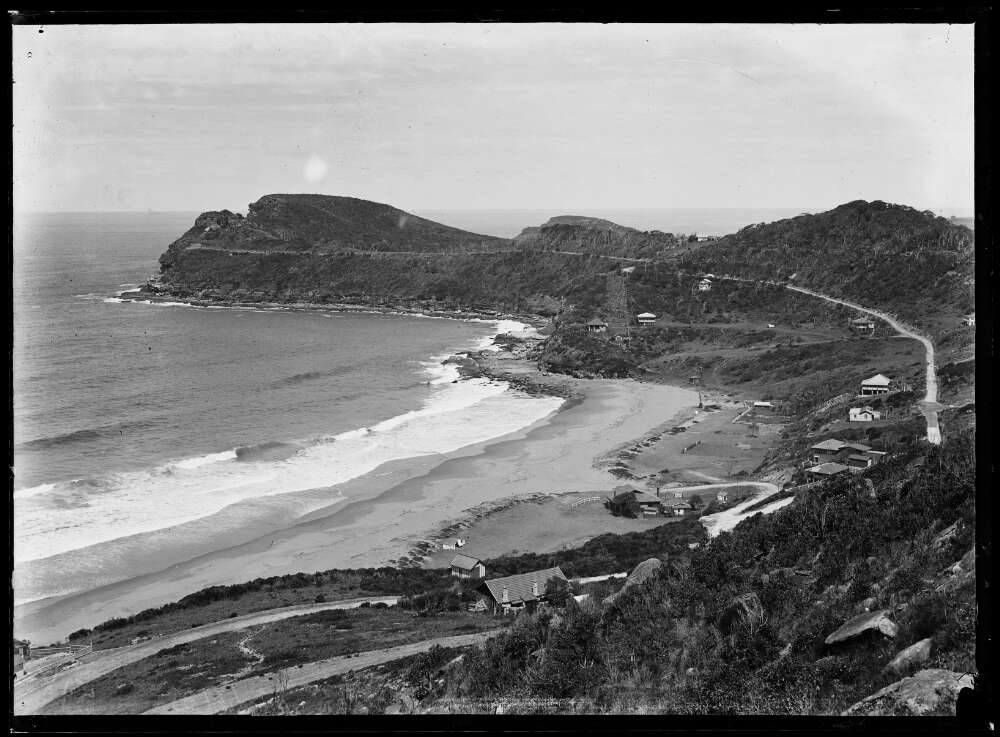
WILD FLOWERS AND NATIVE PLANTS. PROTECTION ACT, 1927. Appointment of Honorary Rangers. THE undermentioned persons have been appointed as Honorary Rangers in pursuance of the provisions of the Wild Flowers and Native Plants Protection Act, 1927: — James Joseph Brosnan, Diamond-street, Tingha. Clarence Ernest Martin, Starkey-street, French's Forest. Alice Edie Collins, 70 Spring-street, Arncliffe. Clement George Hallstrom, 55 Nicholson-street, Strathfield. M. E. MANFRED (for Minister for Local Government). Department of Works and Local Government, Sydney, 28th August, 1940. WILD FLOWERS AND NATIVE PLANTS PROTECTION ACT, 1927. (1940, September 6). Government Gazette of the State of New South Wales (Sydney, NSW : 1901 - 2001), , p. 3707. Retrieved from http://nla.gov.au/nla.news-article225104543
APPOINTMENT OF AN HONORARY RANGER. BIRDS and Animals Protection Act, 1918-1930, and the Careless Use of Fire Act, 1912, as amended by the Bush Fires Act, 1930: Mr. Edward John Lees Hallstrom, of 462 Willoughby road, Willoughby, has been appointed an Honorary Ranger for the purposes of these Acts. (692) J. M. BADDELEY. APPOINTMENT OF AN HONORARY RANGER. (1942, October 16).Government Gazette of the State of New South Wales (Sydney, NSW : 1901 - 2001), , p. 2773. Retrieved from http://nla.gov.au/nla.news-article225124871
The Sanctuary, a place of healing, was also offered as a place of study;
Koala Study Centre For N.S.W.s . The Chief Secretary, Mr. C. H. Matthews, said last night that, the deputy chairman of the Fauna Protection Panel, Mr. E. J. Hallstrom, had offered to make his property at Mona Vale available for research into the conservation of koala bears. He said Mr Hallstrom would put up any buildings required and would provide labour for the care of the animals.
He said that he and the panel appreciated Mr. Hallstrom's generosity. It was intended, to use the property as a centre for scientific investigation into the breeding, feeding, and diseases of koalas. EXPERT ADVICE: The panel would-have the advice of experts, including Professor P.D. F. Murray, Challis Professor of Zoology at the University of Sydney. Mr. Matthews said the panel was making a State-wide survey to find out about-how many koalas there are. He appealed to the public to give the chief guardian of fauna. Mr. F.J. Griffiths, any information about the location of koala colonies in New South Wales Mr. Griffiths is in the Chief Secretary's Department. Koala Study Centre For N.S.W. (1949, October 18). The Sydney Morning Herald (NSW : 1842 - 1954), p. 2. Retrieved from http://nla.gov.au/nla.news-article27577048
Perhaps, the writers of the letters do not know that both in my private capacity, and at Taronga Park, I am continually having birds and animals sent to me or placed under my care because of their ill-health or injury. These birds and animals are restored to health, returned to their owners, or returned to their natural habitats.
From injured koala bears sent to me, I have built up a sanctuary where these injured creatures are now breeding, and are under the jurisdiction of the Fauna Board. E.J.L. HALLSTROM (F.R.Z.S.). Mosman. Letters. (1950, September 5). The Sydney Morning Herald(NSW : 1842 - 1954), p. 2. Retrieved from http://nla.gov.au/nla.news-article18176586
More Than 50 Injured Koalas Saved At Coastal Sanctuary
By A STAFF CORRESPONDENT:
A CAR sped along the Pacific Highway towards Sydney late one summer night. There was a bump against the front mudguard, so slight that it was hardly noticed by the driver. Anyone watching closely, however, would have noticed a grey ball of fluff, lit up for a moment by the headlights, bounce on to the side of the road. After a time they would have seen it crawl away into the bush. That injured animal was a koala. A number of koalas, which sleep during the day and move around at night, have been hit by cars. Some have been killed.
The more fortunate of the injured ones find their way to the private sanctuary run by Mr. E. J. Hallstrom, industrialist and naturalist, at Mona Vale. Mr. Hallstrom is president of the Taronga Park Trust. There they are joined by others of their kind, who have got into fights among themselves, been caught in traps, fallen from trees, been burned in bush fires, and suffered a variety of injuries. During the past five years 50 to 60 koalas have been treated there, mainly for fractures and burns. Over 80 per cent, have regained normal health.
Mr. Hallstrom deals with cases of simple fracture himself. He calls in a vet. for compound fractures and other difficult cases. It was found that koalas strongly objected to being treated lying down. So a special apparatus was devised to enable them to recover in their natural sitting-up position. It consists of an upright wooden post, mounted on a rubber cushion. The bear sits with its legs straddled each side of the post, and clings to the wood with its claws. After its broken limbs have been set, they are strapped into a suitable position around the post.
How They Are Fed: If the animal is capable of feeding itself, a box of leaves and a canister of water are left within easy reach. Otherwise it is fed with milk from a spoon. A young koala which was picked up in a gutter at Vaucluse had two fractured limbs and a broken pelvis. The injured parts of its body were set in plaster, and it was carefully nursed for nearly three months. It is now well and the mother of a baby at Taronga Park.
I drove out with Mr. Hallstrom to see the 20-odd koalas at present convalescing at Mona Vale. The sanctuary is in typical bush scenery, on a hillside overlooking the sea. More than 5,000 young trees, mostly grey gums, have recently been planted to ensure a good supply of natural feed. Injured koalas spend their time in a shed during wet weather, and in a small paddock "hospital" clear of trees (to avoid further injuries from falls) when it is dry.
When they, are well enough to climb and take care of themselves, they are released into a 15-acre paddock, where they live in completely natural surroundings. The paddock is also used for breeding purposes. I saw several of the convalescents perched in the trees. Some were sleeping peacefully in the forks of branches. Others, with their young in pouches or on their backs, were crawling precariously amongst the thick foliage after food.
"Mac," a bush veteran who helps Mr. Hallstrom look after the animals, nodded at one young mother who was working her way obstinately along a particularly slender branch. "If it snaps." he said, "she'll be back in hospital. Mostly they send the young ones out on the tricky branches after they're a few months old. Two months in the pouch, a month being carried piggy-back, and they're ready to fend for themselves. I've seen them hanging on as cool as cucumbers with a westerly blowing the branches all over the place."
I asked "Mac" how he dealt with burns, and how the animals behaved when they were hurt.
"Burns," he said, "I treat with salt and water solution and special emulsions. Where their eyes are closed up I use silver nitrate drops to take off the scum. Most of them sit still during treatment and don't make any fuss. They're not overburdened with brains, but they seem to realise we're trying to help. I've known them scratch and nip a bit at first, but they soon get tame enough to be handled. Once they get well and back in the trees again it doesn't take long before they forget 'civilisation'."
Mr. Hallstrom explained that most of the koalas get injured "on nocturnal prowlings after food and females," or during bush fires when they curl up in the trees and refuse to budge. "Although their fur is close-knit and highly resistant to water," he continued, "they have been known to die of pneumonia. Twenty-odd years ago hundreds of thousands died of a disease rather similar to sinus. "With pneumonia and septic conditions setting in around fractures, I usually give a few shots of penicillin." More Than 50 Injured Koalas Saved At Coastal Sanctuary. (1950, September 6).The Sydney Morning Herald (NSW : 1842 - 1954), p. 2. Retrieved from http://nla.gov.au/nla.news-article18181334
Please note this following article will upset children, we would not read it out to them - it will upset adults too - but should form part of this record, especially during current times when we find ourselves in danger of losing all koalas - it also shows Edward's son John had begun to take in many of the duties in looking after the animals thank you Mr. Gellert:
Leon Gellert Finds Himself.. AMONG THE KOALAS
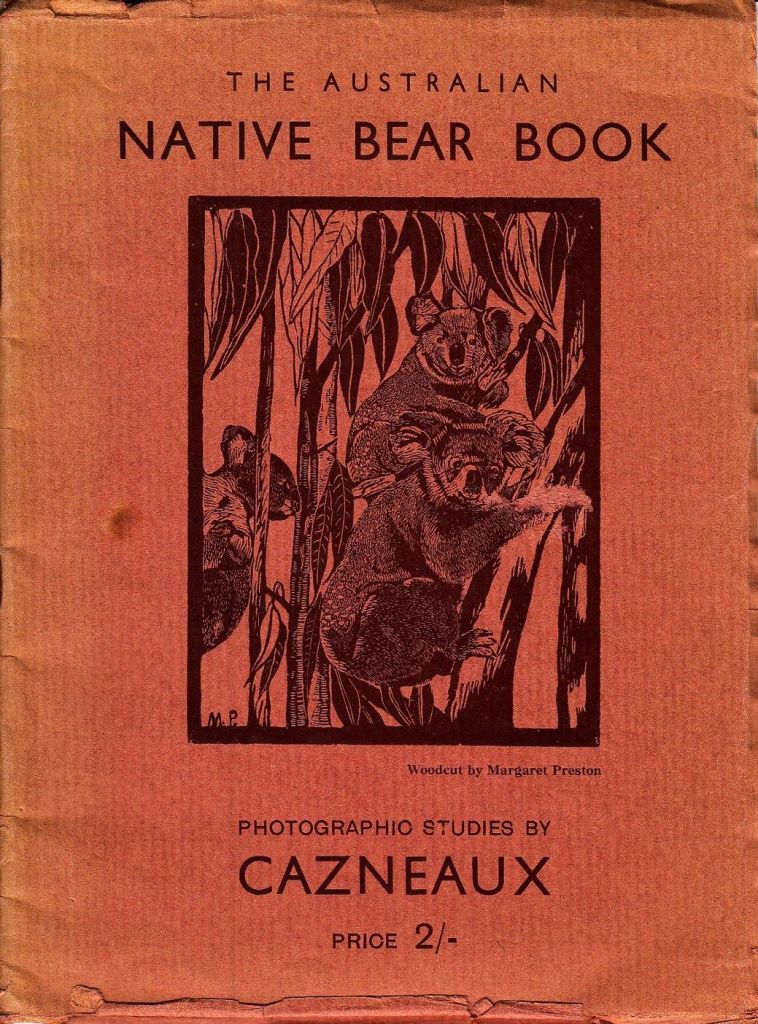 AN incensed reader has sent me a newspaper clipping in which, she claims, a libellous injustice has been done to a koala. It states that at Mona Vale one of these animals bit and poisoned the hand of a solicitous naturalist who was trying to succour it-a Mr. John Hallstrom. The name seems familiar. Were there any truth in this alarming story it could only be assumed that the unhappy marsupial, immeasurably wiser than its kind, singled out that particular hand as most deserving the honour of the first koala-bite in history.
AN incensed reader has sent me a newspaper clipping in which, she claims, a libellous injustice has been done to a koala. It states that at Mona Vale one of these animals bit and poisoned the hand of a solicitous naturalist who was trying to succour it-a Mr. John Hallstrom. The name seems familiar. Were there any truth in this alarming story it could only be assumed that the unhappy marsupial, immeasurably wiser than its kind, singled out that particular hand as most deserving the honour of the first koala-bite in history.
Such reckless stories of the ferocity of our native bears may have their uses. Apart from frightening us into barring our doors more securely at night, they should act as a warning to those foolhardy wayfarers who are always eager to rescue a country's fauna from its natural surroundings.
Man, in his dealings with creatures of the wild, suffers many misadventures. He may be torn asunder by raging silkworms, brutally battered to death by butterflies or trampled underfoot by stampeding ladybirds, but he is never, never, never bitten by koalas.
This is not to say that every-body who chooses to play fast and loose with a koala comes away unscathed.. The single occasion on which I engaged one of the species single-handed proved to be a pretty bloody affair.
MANY years ago my friend Harold Cazneaux (the celebrated photographer) and I were assigned to bring out an illustrated booklet on the Australian native bear. During the preliminary operations of getting facts and photographs at Koala Park, Mr. Noel Burner, the director of the sanctuary, placed an exquisite cub of about seven inches long in my arms while he and Cazneaux went in search of a larger specimen.
Mistaking me for the bole of a stunted bluegum, the animal began to mount, hand over hand,[for the topmost branches where, if instinct could be relied upon, the most succulent pastures were to be found. I tried as gently as possible to thwart its purpose, but my tender restraint was met with a cheerful but desperate opposition. The harder I tugged, the deeper its needle-sharp claws dug in.
.jpg?timestamp=1471781871586) Having negotiated my vest, it scrambled from one chin to the next and began its ascent of the face, itself, where the yielding, penetrable tissues were more to its liking. Eventually it gained the summit and, as far as I remember,- settled down among the sparse undergrowth and quietly dropped off to sleep.
Having negotiated my vest, it scrambled from one chin to the next and began its ascent of the face, itself, where the yielding, penetrable tissues were more to its liking. Eventually it gained the summit and, as far as I remember,- settled down among the sparse undergrowth and quietly dropped off to sleep.
By the time Mr. Burnet returned my countenance was ashambles. But, there and then, I was given a lesson in the correct method of disengaging a koala bear from the human face. The procedure is much like removing a cluster of fishhooks that have become embedded in the flesh. The booklet is long since out of print and Mr. Cazneaux's incomparable photographs have circulated on their own merits and have been acclaimed in every quarter of the globe.
THE publication I speak of was an inexpensive little thing, and I can recall only one other incident in connection with it, and that was a true story that my friend Hemsley told me while it was in preparation.
Hemsley is one of those kindly, sensitive mortals who shudder visibly at the very thought of pain wantonly inflicted.
One evening, as we were travelling together on the ferry-boat from the city, I told him of our prospective brochure on the koala, and saw him wince at the mention of the name. After some moments of grave silence he came out with his story. It was simple and brief.
"It was towards the end of my knicker bocker days," said Hemsley. "There were three of us all boys of about the same age and armed with pea-rifles, we had set out across country one morning for a day's rabbit-shooting.
"We had tramped through the fields and low-lying paddocks for hours. We had scattered through the stubble and peered into burrows. We had combed the bushes and the dead wood for miles around but with no sight of a rabbit, except, here and there, a vanishing tail.
"By midday not a shot had been fired. And then someone suggested that we make our way up the gentle slope of ground to the foothills where, out of reach of the sun, under the tall timber we could eat our lunch.
.jpg?timestamp=1471781937205) "AS soon as we got well into the belt of towering gums we collapsed forlorn and frustrated at the foot of the largest of then and lay there on our back munching and grumbling.
"AS soon as we got well into the belt of towering gums we collapsed forlorn and frustrated at the foot of the largest of then and lay there on our back munching and grumbling.
"Revived by our meal, we gathered enough energy to make a target of a young sapling. But we soon wearied of sapling shooting and once more lay on our backs in the shade looking up at the blue fragments of sky showing through the distant wickerwork of leaves. It was close timber and the lowest branches emerged from their trunks some twenty feet from the ground.
"Suddenly the idling eyes one of us descried a small brown shape huddled in the delicate fork of the highest limb of our tree. It swayed in the mild wind overhead like a tiny mariner caught in the farthest rigging. And although none of us had seen one we all knew that it was a koala.
"There was great excitement. Game at last!-and nicely silhouetted against a clear heaven.
"After the usual dispute as to whose privilege it was to have the first shot we were all at it firm singly, at first, and then in volleys
"The brown shape continued to swing unconcernedly and then someone scored a hit.
"There were yells of delight as our marksmanship improved and we could hear our bullets find their mark.
"Slowly the small brown bundle began to stir, unfolding itself like a woollen glove. And then we saw a drop of blood among the dead leaves at our feet. Another drop fell beside it and another. It wouldn't be long now, we thought, before that clump of fur came tumbling down. It must be fairly riddled with lead by this time.
"Nevertheless a feeling of un-easiness had set in. From away up in the tree-top there came drifting down to us a sound that made us lower our rifles and stand close together-a white faced little group, paralysed with awe. It began as a soft whimpering such as might have come from a forsaken child and swelled to the terrible grief-stricken lamentation of a heart hopelessly broken. It went on and on.
THERE was no protest in that piteous crying-only an inconsolable anguish. And as the moaning continued we noticed that the bear had begun to move.
"It was coming down-not falling down, but slowly, falteringly groping its way along the branch to the main stem, weeping and shaking its head from side to side as it paused, every now and again, to steady itself.
"Eventually it arrived at the lowest limb and commenced its backward descent of the smooth trunk. Never was progress so slow.
"And all the time we stood there watching and listening watching its poor feet fumble for a grip so that pieces of bark came clattering down-listening to that interminable crying of despair.
"When at last it reached the ground, it hesitated for a second or two and then, as though it had lost the power to see, it came stumbling to where we stood petrified with shame and horror. And there it sank at our feet.
"Not till we had realised that it was dead did we notice, clinging to its back, another diminutive bear looking up at us with bright beady eyes. It seemed as though that heroic mother had, with its last gasp, trustingly committed her cub into our care.
"I tell you that during the whole of that horrible journey home none of us spoke a single word. And since that day I have never touched a firearm of any kind."
COULD see that Hemsley was considerably upset. But it was time for me to leave him. The boat was drawing into my wharf.
As I rose to go I said, "And what became of the . . ."
But somehow I could not get the words out of my mouth. With a dumb gesture of understanding I left him sitting there.
Leon Gellert Finds Himself.. (1950, October 15). The Sunday Herald (Sydney, NSW : 1949 - 1953), , p. 2. Retrieved from http://nla.gov.au/nla.news-article28670685
Wild Life Preservation Society of Australia. Preserving Australia's Fauna and Flora.
The Annual Report of the Secretary of The Wild Life Preservation Society of Australia for the year ending June 30th, 1950, sets forth in considerable detail the various activities of this important Organisation, which quietly, consistently and altruistically, year in and year out, strives to preserve the flora and fauna of our country against the apathy of the people and the inroads of vandalism. Regret is expressed that the Wild Life Section of C.S.I.R.O. cannot find time to tackle many of the problems that the Society would wish, the Report stating that this section "continues to concern itself only with the rabbit.'" International Conference. In August, 1949, the International Union for the Protection of Nature held a conference under the auspices of UNESCO at Lake Success, U.S.A., the purpose of the conference being the sponsoring of more efficient conservation and the better use of the earth's resources. Mr. Ellis Troughton, of the Australian Museum, Sydney, and Mr. Harold Coolidge, Washington, acting for the Society, were Australian delegates. Dr. J. H. Westerman, a Councillor of the Society, was also present. The Society is represented by the Secretary, Mr. Allen A. Strom, and Mr. E. J. Hallstrom, representing the Taronga Zoological Park Trust, on the Fauna Protection Panel. A protest has been made during the year regarding the alienation of land between National Park and Garrawarra Park. All those interested in this important work should belong to this Society, the annual subscription for which is for men, 10/-, and women 5/-, with life membership at five guineas. The Hon. Secretary is A. A. Strom, 6 Coopernook Avenue, Gymea Bay, Sydney. Wild Life Preservation Society of Australia (1950, November 1). Construction (Sydney, NSW : 1938 - 1954), , p. 16. Retrieved from http://nla.gov.au/nla.news-article222890795
Plan to save our koalas
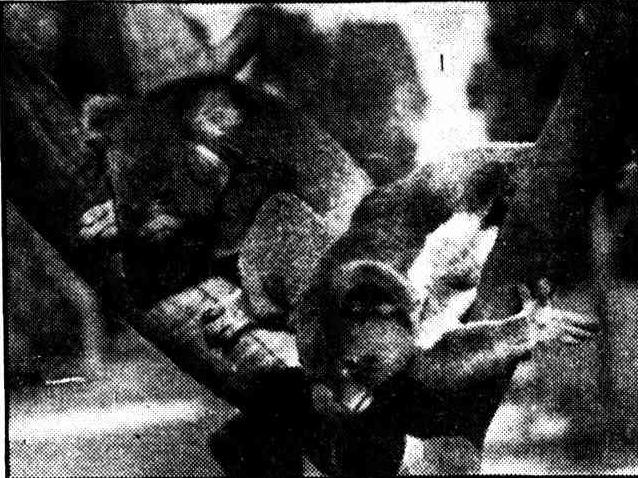
"WHAT GIVES DOWN THERE?"
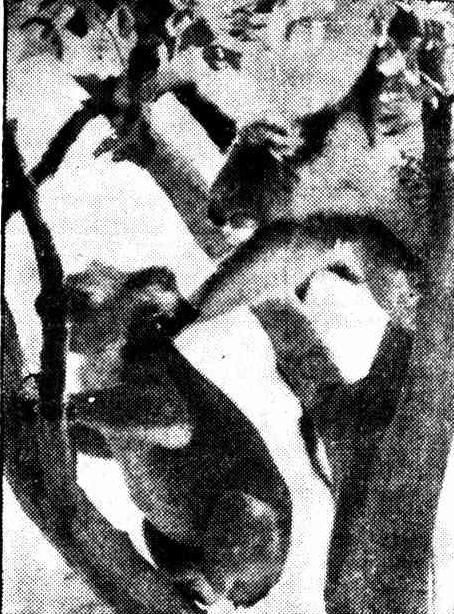
"NOW THEN, BUZZ OFF."
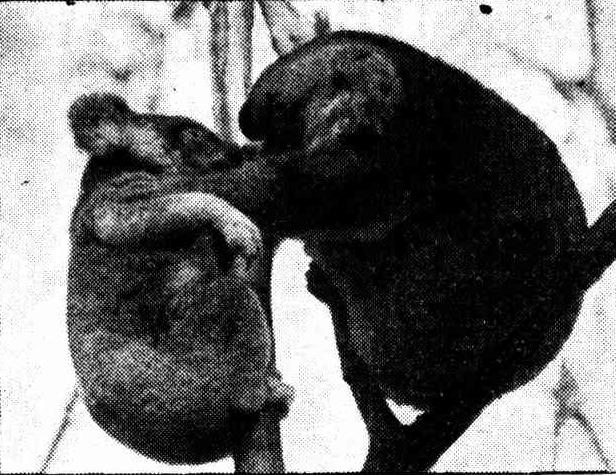
"CAREFUL, COBBER"
FAR behind what the world has come to call the Iron Curtain, in a tiny wooden village schoolhouse in Bessarabia, I was once shown a postcard which the aged schoolmaster carried carefully in his wallet, in just the same way as a soldier carries the photograph of his wife or sweetheart. He had shown it to his class year after year when the geography lesson on Australia came round, and was never tired of displaying it at night under an oil lamp to the gaping peasants in the village wine-shop. It was the worn photo of a Dinkum- Aussie who has done more to publicise Australia abroad than the Department of Information and the Departments of Tourism put together — the koala.
Throughout the Continent, in all sorts of odd places, I came across photos of our little ambassador, who knows no politics, and who has captured the world's imagination even more than the kangaroo or the platypus. In hotel, bars, cafes, restaurants you had to be ready to brush up your zoological knowledge of the koala, the kangaroo and the platypus once it became known that you came from Australia Wheat, wool and gold, Australia's rapid march in industry, arid its civilisation meant little in the school geography books beside our remnants of the fauna of a bygone geological age-saved from extinction long ago by a timely land-subsidence which cut our continent off from Asia.
To foreign eyes this land of ours is a living museum of ancient geological forms of life— a place where evolution stopped, another "Lost World" with monotremes and marsupials instead of the pterodactyls and dinosaurs. If there is any animal which has become a martyr to human greed and cruelty, it is the gentle, inoffensive koala; if any animal has a damning indictment to present against humanity, it is the koala. In the days of our first settlers, it was flourishing almost everywhere except in Western Australia. But the harmless little gumtip-eater had the bad luck to possess a strong hide and a lovely fur which would stand up to a lot of wear. That started the white man's slaughter of the innocent. More than a million were killed and their skin's exported to America (under the name of "wombat" skins, in order to allay any public outcry). Only 25 years, ago, American fur catalogues still listed them as such. Under the depredations of the fur-hunters, the koala began to shrink fast in number. Then came the virus disease which swept Australia's animal life, killing off countless numbers of marsupials of other species, as well as the koala. The harmless koala began to disappear everywhere except in Queensland, where it had been on the list of totally protected animals. Then followed the "depression" killings, when the Queensland Government lifted its protection from koalas to give "employment" to workless and raise money from the furs. Tens of thousands were ruthlessly shot down from their trees, in spite of loud protests from conservationists who were awake to the fact that one single live koala was worth, as a tourist attraction, a thousand killed for their skins. The only country on earth with koalas was robbing itself of the greatest tourist draw on earth.
After the "depression" massacre, Australia suddenly woke up to the fact that there were only about 100 koalas left in NSW, about 300 in Victoria; and in Queensland, where there had been a million, only a few thousand. It was thanks to men like Keith Minchin, in South Australia, Noel Burnet, at Koala Park, NSW, and other informed and capable conservationists (as well as the extension of the Native Flora and Fauna Protection Acts), that the koala was narrowly saved from extinction along with the pretty little Toolachi wallaby and the other harmless and beautiful wild creatures which have become extinct within living memory.
In response to public pressure, the NSW Fauna Protection Panel was set up several months ago under Chief Fauna Protector Mr. F. J. Griffiths. Among the 14 other members of the unpaid panel, is Mr. E. J. Hallstrom, Sydney philanthropist and animal lover, as Deputy Fauna Protector. The panel's programme is a comprehensive one for the restoration, protection and maintenance of our wildlife. Its first job is to find out what the koala population stands at, where it is distributed and how it is getting along. Re-populating areas where the koala once lived, but from which they have disappeared, is also on the agenda.. Through the Press and over the radio, the panel is seeking information and help from the public, and is gradually piecing together the information it is gathering. It has already established that the koala-colonies exist in some 100 places in the State, almost all along our eastern seaboard, and thickest on the Far North Coast. Very few are found west of the Blue Mountains now. Mr. Griffiths believes that the past five lush seasons ' and the. relatively few bush-fires have boosted Australia's animal and bird, populations to the highest level in long years. Although there are today some 350 game sanctuaries in this State, they are giving little or no real protection to our wild life. The panel is considering the establishment of special reserves in different parts of NSW to include all forms of our wild life. These will be under the control of the panel and will be subject to special supervision by appointed officers.
One other aspect of the panel's work is to set up at Mona Vale an experimental station to breed and study koalas on 40 acres of land made available by Mr. Hallstrom. All native wild animals (except pests such as the dingo and the flying-fox) are fully protected under the Protection Act. With the exception of the koala and the lyre-bird, they can be exported only to foreign zoos or scientific institutions. The koala and the lyrebird cannot be taken outside Australia under any circumstance. Neither can they be owned by anybody but the Crown. The panel is expected to make the same ruling for the platypus. Killing of any protected bird or animal may bring a fine of up to £50. Possession of a skin carries the same penalty. Shooting a kangaroo carries the same, penalty except during an open season, declared when the animal is proved to be a pest. No reptile is protected in Australia. While most native birds are protected, the Fauna Protection Panel is particularly interested in getting information of the whereabouts of the lyre-bird. If you are caught killing a lyre-bird you can expect the full £50 penalty! The kookaburra, although claimed by some to be a pest, is protected. If protection were dropped, a storm of sentimental protest would blow up overnight, Mr. Griffiths believes. The wedge-tailed eagle (of the species which recently created a sensation at King's Cross when it attacked a woman and her child) is the biggest' eagle in the world. The panel does not know what to do about the wedge-tailed eagle. They would like to protect it, but it has occasionally been known to attack lambs. Manufacturers of toy koalas have made huge profits from the public's love of the dreamy-eyed little marsupial. Overseas visitors to these shores have taken away thousands of them, including American "Queen for a Day" Mrs. Mortensen's last-minute gilt of an armful when she left by plane last December. Our postal stamps have made the koala known abroad, and hundreds of thousands of postcards (manufacturers say the koala card is No. 1 seller) have gone to all parts of the civilised world. . It was the State Minister for Tourism (Mr. G. J. Arthur) who rushed the toy koalas to- Mrs. Mortensen at the airport-This is the Minister's comment on the koala: — "The koala and our other unique animals and birds are our trump tourist draw-card. They can earn us fortunes from tourists jaded by the monotonous attractions in other countries. . . . We must not grudge money spent on their care or on koala parks." Plan to save our koalas (1950, February 9). The Sun (Sydney, NSW : 1910 - 1954), , p. 24 (LATE FINAL EXTRA). Retrieved fromhttp://nla.gov.au/nla.news-article230079332
The Koala sanctuary was also used as a breeding place with some koalas being sent to the United States of America, despite a ban on exporting these creatures, in 1952 to be part of a film ‘Botany Bay’. Released in 1953 this American drama directed by John Farrow and starring Alan Ladd, James Mason and Patricia Medina was based on a novel of the same name by Charles Nordhoff and James Norman Hall. Two kagaroos were also flown in to appear the film.
Hollywood "limit" on koalas Sydney, Thursday: Four koala bears being flown to Hollywood on Sunday for the film "Botany Bay'' must be returned within six months, an official of the N.S.W. Chief Secretary's Department said today. Any young born to the bears, two males and two females, also must be re-turned, he added. About 56lb. of gum leaves will be on the plane to feed the bears on their 40-hour trip. Mr. E. J. Hallstrom, Sydney philanthropist, said today the State Government had issued a' special permit for the bears to leave Australia for the first time since their export was banned 25 years ago. "Probably about 2,000,000 people will see the bears during their stay at San Diego Zoo, where they will be expertly cared for," Mr. Hallstrom said.Hollywood "limit" on koalas. (1952, January 4). The Argus(Melbourne, Vic. : 1848 - 1956), p. 3. Retrieved from http://nla.gov.au/nla.news-article23155540
These koalas came from the Mona Vale Sanctuary and recognised Hallstrom when he visited them at the San Diego Zoo late in January 1952. Sir Hallstrom ran into controversy during this episode which he resolved with customary logic:
We Might Lose Our 4 Koalas; Canberra. - Four koala bears flown to America for a film, "Botany Bay," don't know all the fuss they're causing back home. Mr. Clive Evatt, N.S.W. Chief Secretary, who authorised the bears' departure, wants them returned to Australia. But Sir Earle Page, Federal Health Minister, says the Commonwealth will not allow the animals to return by air, because disease might be introduced. He doesn't mind if they come by sea, spending a quarantine period on the way. Mr. E. J. Hallstrom, from whose private sanctuary the bears were taken, says they could not survive a sea trip, and wants them to stay in America. Unless they return to Australia in the form of a skin rug, the bears look like forming the first permanent koala colony outside Australia. We Might Lose Our 4 Koalas. (1952, February 12). Barrier Miner (Broken Hill, NSW : 1888 - 1954), p. 3. Retrieved fromhttp://nla.gov.au/nla.news-article49235794
However, they will remain in the zoo on indefinite loan from the Taronga Park Zoological Gardens in Sydney. This loan from the 'land of living fossils' is expected to last as long as the small marsupials do well in San Diego. 'It is purely an experiment,' Mr. Hallstrom said. There are not likely to be any other koalas exported because of the strict embargo imposed by the Government when they almost became extinct a quarter of a century ago. The need for Mr. Hallstrom's brief visit arose, he explained, after Mrs. Benchley directed so many fineries to him about the koalas' care that answers would have become encyclopaedic if he tried to write them down. He said he examined the bears this morning and they appear to be adjusting quite well to California's varieties of eucalyptus, the koala's only diet. He added he was satisfied with Mrs. Benchley’s plans for a spacious koala enclosure. Four Koalas Loaned to America. (1952, March 14).Centralian Advocate (Alice Springs, NT : 1947 - 1954), p. 15. Retrieved from http://nla.gov.au/nla.news-article59835828
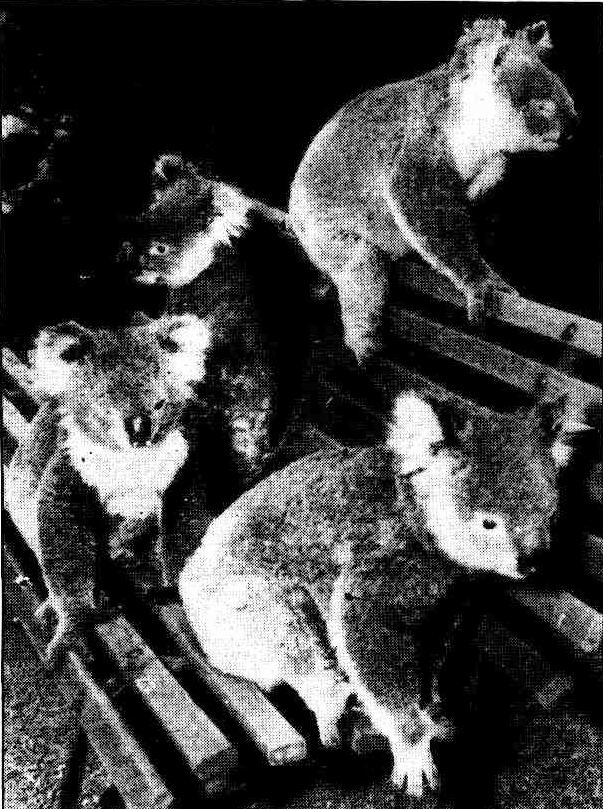
Although the koalas sent to America appeared at first to be adapting well to their new environment and diet they did not live as long as they may have at home. Koalas require more than one kind of tree and are seasonal migrators to these different trees for food.
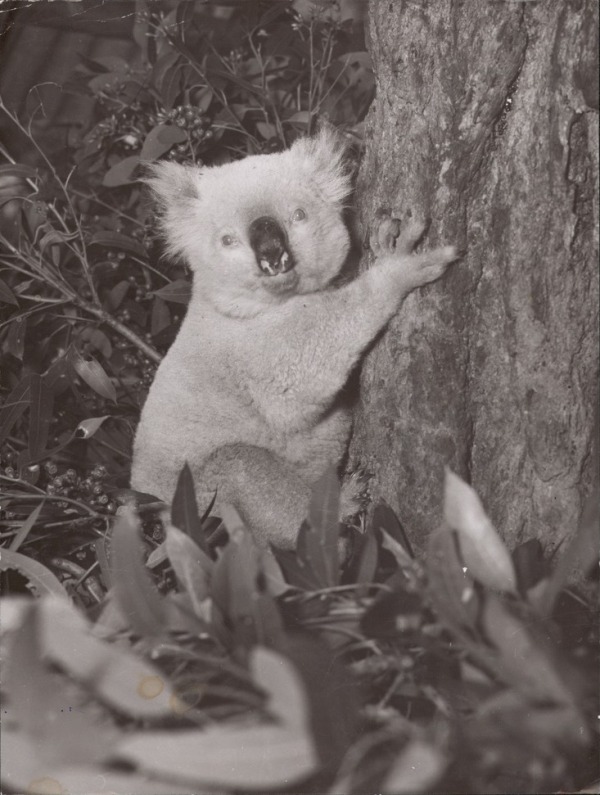 It was here that he 'bred' his white koalas too - albinos that may have not done so well in the Australian sun. The image to right shows one of the white koala bear bred by Mr. Hallstrom - 1953, Courtesy State Library of Victoria. Image No.: 702895272
It was here that he 'bred' his white koalas too - albinos that may have not done so well in the Australian sun. The image to right shows one of the white koala bear bred by Mr. Hallstrom - 1953, Courtesy State Library of Victoria. Image No.: 702895272 Mr. Hallstrom also purchased land at Mona Vale which was utilised to grow food for the animals at Taronga Zoo until the 'elephant grass' etc. wasfound unsuitable for that purpose. AS this land had been subject to flooding prior to making it fields for growing food Mr. Hallstrom had drains installed. This increased the land value as it could then be changed in classifciation - which happened again later on too, and sold off some and kept some, building a cottage in Coolawin Road Avalon, in Darley Road, Mona Vale and in Cabbage Tree Road, Bayview. The Whale Beach and Avalon places may have been for family members, the Mona Vale and Bayview premises connected to koala care:
NSW State Records lists:
Primary Application - Edward John Lees Hallstrom 3 roods 37 1/2 perches on Bassett Street Mona Vale in Parish Narrabeen County Cumberland Volume 7018 Folio 86 – April 1952
Primary Application - Edward John Lees Hallstrom 3 acres 1 rood 25 1/4 perches on Bassett Street Mona Vale in Parish Narrabeen County Cumberland Volume 6969 Folio 15 – April 1952
Primary Application - Edward John Lees Hallstrom 5 acres 1/2 perch on Darley Street Mona Vale in Parish Narrabeen County Cumberland Volume 6969 Folio 14 – April 1952
Primary Application - Edward John Lees Hallstrom 3 roods 39 3/4 perches on Mona Street in the Parish Narrabeen County Cumberland Shire Warringah Volume 7218 Folio 123 – May 1955
Primary Application - Edward John Lees Hallstrom 3 acres 2 3/4 perches in the Parish Narrabeen County Cumberland Shire Warringah Volume 7217 Folio 221 - May 1955
Primary Application - Edward John Lees Hallstrom 32 perches on Walter & Scott Street in the Municipality & Parish Willoughby County Cumberland Volume 9672 Folio 92
No 38028 Edward John Lees Hallstrom 3 a 1 r 25'A p lot, 56 sec 1 Mona Vale Est Bassett St. Mona Vale. No 38029 Edward John Lees Hallstrom 2 a 1r 393i p pt lot 57 sec 1 Mona Vale Est Darley St, Mona Vale. Advertising. (1953, August 14). The Sydney Morning Herald(NSW : 1842 - 1954), p. 12. Retrieved from http://nla.gov.au/nla.news-article18379617
GOVERNMENT NOTICES - REAL PROPERTY ACT NOTICE Applications have been made to bring the undermentioned lands under the Real Property Act. Plans may be inspected and caveats lodged at the Land Titles Office. Sydney, until the respective dates mentioned. 5th MARCH 1954 No 38027 Edward John Lees Hallstrom 5 a 2 1/2 perches lot 54 sec 1 Mona Vale Est Darley St, Mona Vale. Advertising. (1954, January 29). The Sydney Morning Herald(NSW : 1842 - 1954), p. 18. Retrieved from http://nla.gov.au/nla.news-article18407097
Warringah Alts, and adds, to cott.. Coolawin Rd.—Hallstrom Pty. Ltd.: METROPOLITAN WATER SEWERAGE & DRAINAGE BOARD (1951, September 26).Construction (Sydney, NSW : 1938 - 1954), , p. 14. Retrieved from http://nla.gov.au/nla.news-article222887044
Cabbage Tree Road, W.B. cott. — Sir Edward Hallstrom, O., Hallstrom P/L., Willoughby, B„ £1000. SMALL CONTRACTS (1952, December 10). Construction (Sydney, NSW : 1938 - 1954), , p. 17. Retrieved from http://nla.gov.au/nla.news-article223550450
'W.B. cott' means weatherboard cottage. The Coolawin road - Avalon Home and the Malo Road, Whale Beach homes may have been for family use
Mona Vale: Darley Rd.: W.B. adds.— Sir Edward Hallstrom, 462 Willoughby Rd., Willoughby, O., £1000. SMALL CONTRACTS (1954, March 24).Construction (Sydney, NSW : 1938 - 1954), , p. 20. Retrieved from http://nla.gov.au/nla.news-article224515186 weatherboard 'additions'.
FAUNA PROTECTION ACT, 1948. Appointments.
THE Governor-in-Council has approved of the following persons being appointed as members of the Fauna Protection Panel:—
Dr. Robert Carrick, Senior Principal Research Officer (Bird Section), Wildlife Survey Section, Commonwealth Scientific and Industrial Research Organization, Canberra—nominated by the Colonial Secretary from persons nominated by organisations the constitutions of which include specific or general objects in relation to the preservation, conservation, protection or scientific investigation of fauna-—vice Sir Edward John Lees Hallstrom. Charles Edward Elphinstone, Esquire, Deputy Surveyor General, Department of Lands—nominated by the Secretary for Lands—vice Arthur Robert William Littlewood Jones, Esquire. C. A. KELLY. FAUNA PROTECTION ACT, 1948. (1957, April 5). Government Gazette of the State of New South Wales (Sydney, NSW : 1901 - 2001), , p. 1125. Retrieved from http://nla.gov.au/nla.news-article220352216
As can be seen below this section, Edward Hallstrom remained a lover of the sea and all those who go into this. His ethos of 'saving lives' naturally extended to supporting those who also save lives - surf life savers. He donated or funded many surfboats, along with other items.
He also gave t the community as well - not just structures and boats but an opportunity to establish a Flora and Fauna Sanctuary. From Warringah Shire Council Minutes of Meetings records:
(B) Warringah & Manly A. & H. Society, 30/1/56, stating that His Excellency the Governor desires to spend the best part of a full day in Warringah Shire on the occasion of the opening of the Brookvale Show on 16th March, and supplying the timetable which has been approved by His Excellency a namely, (a) the Governor arrives at Shire Hall approximately 12.30 pm; (b) Shire President to extend Civic Welcome; (c) Official Show Luncheon, 1p.m.; (a) Governor to open Brookvale Show at 2.30 p.m. (e) Governor to open new Sir Edward Hallstrom Pavilion, say 3.3.0 p.m.; aM (r) possibly Shire President and others would then entertain His Excellency for a short period.
20/8/1956 Brookvale Park. Deputation from representatives of Warringah & Manly A. H; Society: 12. Resolved, - That the Committee's recommendations be adopted, and the application for the letting of the Hallstrom Pavilion for storage purposes be refused. (Crs. Gwynne, Job)
Scotland Island Progress Association, 8/5/59, regarding the following matters:- (a) seeking co-operation in recognising the 150th anniversary of the grant of Scotland Island to Andrew Thompson, being of the opinion that this was the first official grant of land in what is now Warringah Shire; (b) asking that notices be erected in the Church Point wharf shelter shed prohibiting the use of it as a store room; (c) asking to be allowed to put an awning something like a car- port in front of the bush fire shed; (d) seeking Council's concurrence in an approach to the Chief Secretary's Department with a view to finding out if it would be possible to instal koalas on Scotland Island, the Association already having the promise of Sir Edward Hallstrom to give assistance; and (e) asking if Council can do anything to stop the practice of cleaning fish on the public wharves at Church Point and Bayview, which makes the steps dangerously slippery. 19, Council's decisions:- (a) noted, the Council to co-operate; (b) that notices be erected as requested; (c) already authorised by Council; (d) that the Council support the request; and (e) that the necessary notices be erected prohibiting this practice. (Crs. Reynolds, Job)
7th of January, 1963
PRESIDENTIAL MINUTE: ESTABLISHMENT OF FLORA & FAUNA SANCTUARY PITTWATER PENINSULAR. The 'President outlined an interview he had with well known Sydney philanthropist Sir Edward Hallstrom concerning the future protection and cultivation of flora and fauna on the Pittwater Peninsular. Sir Edward wished to establish a flora and fauna sanctuary on his property covering some forty acres of choice bushland off Cabbage Tree Road, Mona Vale, for the protection and breeding of Koala Bears, Kangaroos and other native fauna. He also desired to address Council at 8 p.m. on Monday 21st January to explain his proposals. Resolved,- That Council agree to interview Sir Edward Hallstrom at 8 p.m. on Monday 21st January regarding the proposals.
Ordinary Meeting 21.1.63. CONFERENCE WITH SIR EDWARD JOHN LEES HALLSTROM , CONCERNING THE ESTABLISHMENT OF A FLORA AND FAUNA SANCTUARY ON THE PITT- WATER PENINSULA. The President welcomed Sir Edward Hallstrom and introduced him to Councillors, then invited him to address Council on the future protection and cultivation of flora and fauna on the Pittwater Peninsula. Sir Edward stated that he wished to establish a sanctuary of flora and fauna on his property covering some 40 acres off Cabbage Tree Rd., Mona Vale, for the protection and breeding of koala bears, kangaroos and other native fauna. Sir Edward then showed Councillors and the assembled gathering a film setting out full details of his undertaking at the sanctuary, and asked the Council if it would take steps to have the land rezoned' "Special Uses" - "Sanctuary for flora and fauna". Moved by Cr. Jones, seconded by Cr. Gold, "That Council accede to Sir Edward Hallstrom's request that the land as outlined by the Town Planner be rezoned for "Special Uses" - "Sanctuary for flora and fauna", and that the Minister be asked to make the necessary adjustments. An amendment was moved by Cr. Beckman, seconded by Cr. Pickett -Heaps "That this matter be referred to the Town Planning Committee." DEFEATED A further amendment was moved by Cr. Brown, seconded by Cr. Pickett-Heaps, - "That Sir Edward Hallstrom be advised that this Council has no power to accede to his request, but that the matter will be placed on the Council's business papers for consideration after the Warringah Planning Scheme is prescribed, and will be taken into consideration when the varying scheme of this Council and the ratepayers of Warringah is being prepared for the Minister for Local Government. DEFEATED. The motion was CARRIED.
LEFT: White and grey. Nine white kangaroos were flown to Sydney for Sir Edward Hallstrom and are at his Mona Vale farm, where these two color pictures were taken by Ron Berg.
ABOVE: Young albino kangaroo, which has a snow-white pelt and pink eyes, it looks more fragile than the grey kangaroo of the same species. Like all albinos, it has weak eyesight. White kangaroo: Tasmania's pride (1958, September 10). The Australian Women's Weekly (1933 - 1982), , p. 3. Retrieved from http://nla.gov.au/nla.news-article46468613
A dream.. and a team.. disintegrates by Kevin Pearman of the "Cooma-Monaro Express"
Within six years the 'Snowy scheme' will be completed and thousands of highly-skilled men and women who contributed to the engineering wonder will be spread through every State of Australia and overseas countries. ….The lake, created by a 481 ft. high dam is capable of holding nine times the volume of water in Sydney Harbour, over an area of 56 square miles. From the lake, one development — the 'Snowy Murray' — runs virtually sth-west through the Great Dividing Range to Khancoban, near the Victorian Border, where it empties into the Murray River. The second, the Snowy Tumut', runs northwest, also through a tunnels system, into the Tumut River which is a tributary of the Murrumbidgee. Near the dam wall, the party boarded one of three large pleasure craft owned by the Authority - all have since been sold — for a cruise across part of the lake, which measurers 32 miles from end to end. The boat, a former motor torpedo recovery vessel, passed quite close to Hallstrom Island which has been stocked with albino kangaroos from the private collection of Sydney breeder, Sir Edward Hallstrom. A dream.. and a team.. disintegrates (1968, August 2). The Beverley Times (WA : 1905 - 1977), , p. 4. Retrieved from http://nla.gov.au/nla.news-article201778456
This short snippet from a film by British Pathé allows us to see the Koala and Pittwater Flora and Fauna Sanctuary
Koala Bears Threatened By Extinction (1962)
Sir Edward Hallstrom with two companions strolling through his sanctuary where he tries to preserve breeds of animals that like the Koala are near exhibition. MS. Koala mother with baby on back climbs tree. CU. Sir Edward Hallstrom looking up into tree. Various shots of koala bears.
(F.G. Comb) by British Pathé Date found in the old record - 16/02/1962. FILM ID:2613.26
The Pittwater Flora and Fauna Sanctuary was sold off the year after Sir Edward passed away. This wasn't the only land set aside or given to establish fence-less arks:
Muogamarra - Another Flora and Fauna Reserve
The wonderful Muogamarra Nature Reserve, presently opened for visitors to marvel at its spring beauties, owes part of its grounds to them being handed over by Edward Hallstrom
The Muogamarra Nature Reserve is a protected nature reserve located in the Sydney region of New South Wales, in eastern Australia. The 2,274-hectare (5,620-acre) reserve is situated in the northern edge of Sydney and lies between the suburb of Cowan to the south, and the Hawkesbury River to the north.In 1836 George Peat was granted 50 acres (20 ha) on the Hawkesbury River at what is now Peats Bight. He built huts and a wharf there, and farmed his land. A dairy farm was then built nearby at Peats Crater. Founded by John Duncan Tipper in 1934 when he leased 600 acres (240 ha) to protect the flora, fauna and aboriginal sites, due to his concern at the loss of Hawkesbury sandstone forest. He named the site 'Muogamarra', which he believed was an aboriginal Awabakal word meaning "preserve for the future." This area was at the northern end of what is now the nature reserve. Over time Tipper expanded his lease to 2,050 acres (830 ha). In 1954 the land was given up by Tipper and gazetted as Muogamarra Sanctuary.
The 750-acre (300 ha) Sir Edward Hallstrom Faunal Reserve was dedicated in 1961 in what is now the southern part of the nature reserve. This was the work of Allen Strom and Sir Edward Hallstrom. In March 1969 the two areas were amalgamated into what is now Muogamarra Nature Reserve, under the control of the NSW National Parks and Wildlife Service. - from www.nationalparks.nsw.gov.au/visit-a-park/Muogamarra-Nature-Reserve
LANDS DEPARTMENT NOTICES
FAUNA PROTECTION ACT, 1948-1967.—
PROCLAMATION
(l.s.) A. R. CUTLER, Governor.
I, Sir Arthur Roden Cutler, Governor of the State of New South Wales, with the advice of the Executive Council and in pursuance of the powers vested in me under section 9 (1) of the Fauna Protection Act, 1948-1967, do, on the recommendation of the Director, National Parks and Wildlife Service, proclaim that the areas dedicated as a Nature Reserve by Gazette notifications of 10th June, 1960, 5th February, 1965, and 16th September, 1966, as Hallstrom Nature Reserve No. 15 and Hallstrom Nature Reserve No. 15, Extensions Nos 1 and 2, shall henceforth be known as "Muogamarra Nature Reserve No. 15". (N.P.W.S. 21e-1)
Signed and sealed at Sydney, this 5th day of March, 1969.
By His Excellency's Command,
T. L. LEWIS, Minister for Lands. (1050) GOD SAVE THE QUEEN! LANDS DEPARTMENT NOTICES FAUNA PROTECTION ACT, 1948-1967.—PROCLAMATION (1969, March 28).Government Gazette of the State of New South Wales (Sydney, NSW : 1901 - 2001), , p. 1207. Retrieved from http://nla.gov.au/nla.news-article220065982
One man's achievement
MUOGAMARRA owes its existence as a reserve to one a man, the late John Duncan Tipper, who devoted a lifetime to its preservation. An engineer by profession, he undertook lone-handed guardianship of the wilderness region as early as 1923. He pointed out that much of the sandstone flora around Sydney is unique. The land is useless for cultivation and so escaped early settlement, but he was worried about the march of the suburbs.
In 1933 his work was recognised when the State Government gave him permissive occupancy of the first 600 acres. Twenty years later Muogamarra was proclaimed a sanctuary in perpetuity, under a trust headed by John Tipper.
It is now a Nature Reserve, enlarged about four years ago by inclusion of the adjoining 2000-acre Hallstrom Nature Reserve, and is administered by the National Parks and Wildlife Service. One man's achievement (1972, August 16). The Australian Women's Weekly (1933 - 1982), , p. 26. Retrieved from http://nla.gov.au/nla.news-article48082051
Willoughby
£3000 has been offered by Hallstroms Pty. Ltd. as a contribution towards the beautification of an area under control of the Willoughby Council. Mr. Hallstrom has also offered to pay the cost of erecting waiting sheds for tramway passengers in Willoughby Road and Artarmon Road. Opportunities for Business (1946, July 17).Construction (Sydney, NSW : 1938 - 1954), , p. 6. Retrieved from http://nla.gov.au/nla.news-article222874101
A gift of £2000 to improve parks in the Municipality of Willoughby has been given to the Council by Mr. E. J. Hallstrom. Opportunities for Business (1946, September 4). Construction (Sydney, NSW : 1938 - 1954), , p. 6. Retrieved from http://nla.gov.au/nla.news-article222874465
NOTICE APPOINTING A TRUSTEE UNDER THE CROWN
LANDS CONSOLIDATION ACT, 1913
IT is hereby notified that in accordance with the provisions of section 26 of the Crown Lands Consolidation Act, 1913, Arthur Robert William Littlewood Jones, O.B.E., is hereby appointed as a trustee of an area of about 88 acres 2 roods 17 perches at Athol Bay, parish of Willoughby, county of Cumberland, dedicated 29th November, 1918, for Public Recreation, and known as "Ashton Park", in the place of Sir Edward John Lees Hallstrom, retired. Pks. 58-4,861.
J. M. A. McMAHON, Minister for Lands. NOTICE APPOINTING A TRUSTEE UNDER THE CROWN LANDS CONSOLIDATION ACT, 1913 (1959, November 13). Government Gazette of the State of New South Wales (Sydney, NSW : 1901 - 2001), , p. 3485. Retrieved from http://nla.gov.au/nla.news-article220309490
Surf Boats For Saving Lives And Seaside Holiday Cottages
Edward Hallstrom was a keen supporter of surf life saving and donated numerous surf boats, with a focus on "for smaller clubs". In a January 1952 article published by The Sydney Morning Herald announcing his donating a further £400, he stated, "The Surf Life Saving Association deserves all possible public support. I have already given, as promised, seven surfboats, but to encourage others to support this appeal I shall be glad to give another, which I would like to go to one of the weaker clubs." - 'Lord Mayor Urges Support for Herald Surf Fund - The Sydney Morning Herald -January 11, 1952
Surf Boats- North Narrabeen – Freshwater – Dee Why - Bondi - Bronte ...and further ashore
For the 1947-1948 Season the Tamarama SLSC received it's first new full-sized surf boat, the "Ted Hallstrom 1", donated by Edward Hallstrom - Waverly Council book HERE.
Edward Hallstrom was a big supporter of surf life saving clubs too, a Patron at Warriewood SLSC. To begin with many of these surfboats were named for him. After a while they began to be named after birds, perhaps because they were the 'fliers' then too!
HALLSTROM PATRON
Sir Edward Hallstrom has been elected patron of Warriewood Surf Club. HALLSTROM PATRON (1952, September 24). The Sun (Sydney, NSW : 1910 - 1954), , p. 39 (LATE FINAL EXTRA). Retrieved from http://nla.gov.au/nla.news-article231007467
One of his first surfboats and others follow
SIR EDWARD HALLSTROM, who has donated a new lifeboat GOT £250 CHEQUE FOR SAVING LIVES SYDNEY, Friday.-A Sydney business man, Mr. E. J. Hallstrom, tonight handed Tamarama Surf Club lifesavers a cheque for £250 to buy a surfboat. Officials of the club had approached Mr. Hallstrom after Mr. J. Braund had rejected his £20,000 offer to set up a cancer clinic. They told Mr. Hallstrom" they were engaged in saving lives, and that their first and only boat had been lost in a gale during the war. Mr. Hallstrom has already donated two boats to Dee Why Surf Club. GOT £250 CHEQUE FOR SAVING LIVES (1948, February 7). Newcastle Morning Herald and Miners' Advocate (NSW : 1876 - 1954) , , p. 1. Retrieved from http://nla.gov.au/nla.news-article134320770
Life Saving Club Received Boat
SYDNEY, Friday.
Mr. J. Hallstrom, whose offer to J. Braund to provide £20,000 for a cancer clinic was withdrawn, has donated £250 to the Tamarama Life Saving Club to buy a surf boat.
Club officials approached Mr. Hallstrom and told him they were engaged in saving life and their only boat had been lost in a gale during the war. Mr. Hallstrom has donated already two boats to the Dee Why Club. BRAUND APPEALS TO FORMER PATIENTS FOR INFORMATION (1948, February 7). The Canberra Times (ACT : 1926 - 1995), , p. 4. Retrieved from http://nla.gov.au/nla.news-article2737105
ANY 'IDEAS. — The '64 members of Tamarama Surf Club want suggestions on the best way to catch porpoise alive. If they are able to snare six ; porpoise alive they stand an excellent chance of getting a third surf-boat from Mr. E. J. Hallstrom. No title (1951, February 19). Lithgow Mercury(NSW : 1898 - 1954), p. 1 (CITY EDITION). Retrieved from http://nla.gov.au/nla.news-article220744912
Wife risks death in heroic rescue
Sydney, Sunday
THE heroine of yesterday's surf drama off Warriewood tonight was nursing her husband, who lay helpless with illness while she battled single-handed to save their disabled yacht from destruction.
Mrs. Alma Kothner (picture right), whose fortitude amazed the crews of a surf boat and a police boat which went to her aid, was at the helm of the yacht Alcyone when a huge sea snapped the rudder. Alcyone drifted helplessly towards the rocky shore as Mrs. Kathner flashed distress signals from a small torch.
Six lifesavers left a dance at North Narrabeen and put out in their surf boat to row to the yacht, five miles away. They fought the waves until they reached Alcyone, but she was so near the rocks they, could not get alongside. Ken Hodges, a probationary constable, put on a belt and swam 30 yards through shark-infested water with a line. Mrs. Kathner helped him on to the yacht, and fastened the tow rope. It snapped twice as the surf boat, full of water, and battered by the storm, went down into troughs between the waves. Each time Hodges dived in and swam back to the surf boat for a new one.
Boat disappears
The police boat Nemesis arrived after the surf boat crew, cramped with cold and exhaustion, had held the yacht for four hours. They had just boarded Nemesis and fastened a line from Alcyone, when their wrecked surfboat disappeared. Mrs. Kathner, drenched and cold, stayed on the yacht, and fastened new tow lines as the storm broke the others. Mrs. Kathner, who cannot swim, clung precariously to the side of the rolling yacht as wind and waves tried to pluck her loose. A Sydney newspaper has started a fund to replace the £450 surf boat. But philanthropist Sir Edward Hallstrom said today he would buy the club a new one. Wife risks death in heroic rescue (1952, December 29). The Argus (Melbourne, Vic. : 1848 - 1957), , p. 3. Retrieved from http://nla.gov.au/nla.news-article23210614
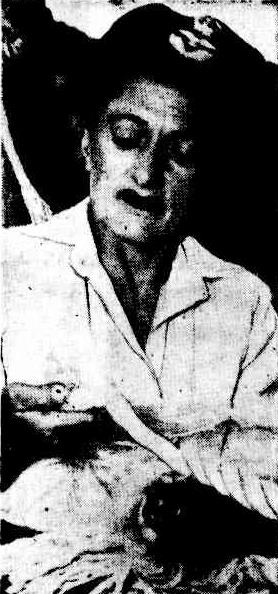 New Boat For Rescue Men
New Boat For Rescue Men
Sydney philanthropist Sir Edward Hallstrom will buy a new surfboat for North Narrabeen lifesavers to replace the one they lost on Friday night in a rough weather rescue. Sir Edward said last night that the lifesavers showed great courage in rowing four miles at night through mountainous seas. He told a "Sunday Herald" reporter: "Tell the surf club to get in touch with me. I'll get them a new boat."
The president of the North Narrabeen Surf Club, Mr. J. King, said: "We'll get in touch with him immediately."
Towed Five Miles Out To Sea
The surfboat-which cost £400 two years ago-was lost when six lifesavers went to rescue Mr. and Mrs. Rupert Kathner from their 27ft auxiliary yacht Alcyone 11, in danger of being smashed on rocks near Mona Vale. The yacht, with its rudder smashed, was only 30 yards from the rocks when the surf-boat reached it.
One of the lifesavers, Ken Hodges, dived from the surf-boat and swam with lines to the yacht, which was towed five miles out to sea.
Twice the line snapped and. both boats were in peril when the police launch Nemesis took the Kathners and the lifesavers on board.
The surfboat, leaking badly, sank. Other lifesavers who took part in the rescue were Jim Mason, Norman Ambrose, Ron Well, Les Brown, and R. Noonan.
They were at a dance at North Narrabeen Surf Club when Sergeant Adams, of Narrabeen police, sought their help. Mrs. Kathner, of Rose Bay said last night: "All concerned in the rescue did a colossal job.
Could See Rocks Looming Up: "We could see the rocks looming up when Ken Hodges dived from the surfboat and passed us a line. It was a nightmare when the line broke. "I don't know how the surf-boat battled through the seas. It was the most courageous feat of endurance I have ever seen. "Time and time again I thought it would sink before other help arrived."
Towed by the Nemesis, the yacht reached its mooring at Rose Bay shortly after 4 a.m. yesterday. The rescue operations had lasted for more than seven hours. TAILPIECE.-A new surf-boat will cost about £450. New Boat For Rescue Men. (1952, December 28). The Sunday Herald (Sydney, NSW : 1949 - 1953), p. 3. Retrieved from http://nla.gov.au/nla.news-article18504886
Two boats needed by surf club
Although Sir Edward Hallstrom has promised the North Narrabeen Surf Club a surf boat, the appeal launched by The Sun and The Sunday Sun will continue, as the club requires at least two boats.
North Narrabeen club's boat was wrecked when club members went to the rescue of a married couple in a crippled yacht on Friday night. "There are thousands of holidaymakers at Narrabeen now, and we have had to borrow Collaroy's second boat to maintain our normal patrols," said Ford. "We have been unable to adequately patrol our beach when surf carnivals are held at other beaches," he said. "Our members must compote at carnivals to keep them right up to the peak of efficiency," said Mr. Ford. Mr. R. W. Askin, MLA, who represents Narrabeen, said today that members of . the North Narrabeen Club were grateful to the people who had contributed to the appeal and The Sun and Sunday Sun for launching it. "It is pleasing to see the heroism of these young men being recognised in such a fashion," said Mr. Askin, who has made a donation to the appeal. Subscriptions to the fund should be addressed to the "Surf Boat Fund, Daily and Sunday Sun, Sydney." The surf boat promised by Sir Edward Hallstrom will be the seventh he will have given to Sydney lifesaving clubs. "The bravery of the men of the surf clubs is something which must be rewarded," Sir Edward said. Two boats needed by surf club (1952, December 29). The Sun (Sydney, NSW : 1910 - 1954), , p. 7 (LATE FINAL EXTRA). Retrieved from http://nla.gov.au/nla.news-article229640388
SIR EDWARD HALLSTROM, who has donated a new lifeboat to the North Narrabeen Surf Life-Saving Club, has old associations with Narrabeen Beach. Back in 1909 young Edward was one of that eager group who made the first Solo gliding flights over the beach. The Idea was to lie flat on the flimsy machine and steer it by wiggling. They considered 200 yards a pretty good glide. A bit later Edward Hallstrom was arrested for flying an airship in a manner dangerous to the public near Prince Alfred Park. The "airship" was a little toy aeroplane. ARTHUR POLKINGHORNE'S Sydney Diary (1953, January 3). The Sun (Sydney, NSW : 1910 - 1954), , p. 5 (LAST RACE LATE CRICKET). Retrieved from http://nla.gov.au/nla.news-article230850753
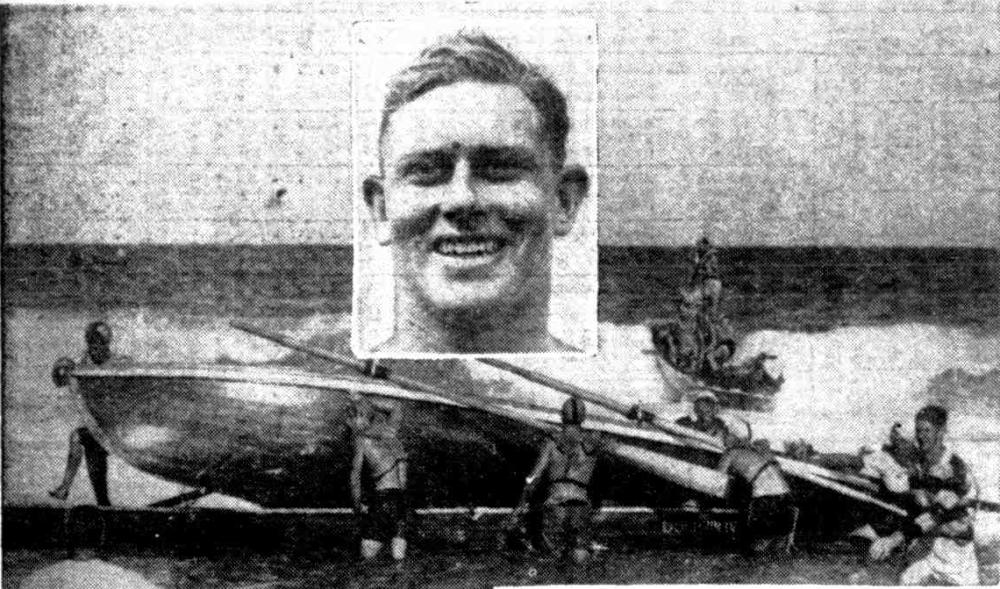
Coogee surf boat telescoped by North Narrabeen, with Dee Why coming in on a wave. (Inset: Don Mason , Belt champion) PICTORIAL HIGHLIGHTS OF YESTERDAY'S MAJOR SPORTING EVENTS (1953, March 15). Truth (Sydney, NSW : 1894 - 1954), p. 22. Retrieved fromhttp://nla.gov.au/nla.news-article168042468
In fact, Edward Hallstrom gave so many surfboats this item appeared:
THE value of a surf boat to a surf club goes beyond providing a rescue medium for surfers in difficulties as has been shown by recent rescues of craft in distress: In no punning sense, every club should be assured of adequate 'sinking' funds to replace boats and it shouldn't all be left to Sir Edward Hallstrom, either. The Newcastle Scene (1952, December 29). The Newcastle Sun (NSW : 1918 - 1954), p. 1. Retrieved fromhttp://nla.gov.au/nla.news-article160399305
SURF CLUB DISPLAY AT TOWRADGI
On Sunday Bellambi, Corrimal and Towradgi Surf Clubs will stage a display on Towradgi Beach. They will compete for the Hallstrom Shield, donated by Mr. E. J. Hallstrom, for annual competition among the three clubs. The first of these competitions was held last year on Corrimal Beach, when Corrimal club proved the winners. SURF CLUB DISPLAY AT TOWRADGI (1951, January 11). Illawarra Daily Mercury (Wollongong, NSW : 1950 - 1954), p. 16. Retrieved from http://nla.gov.au/nla.news-article133993841
Warringah Shire Council Records - Minutes of Meetings: Freshwater S.L.S. Club, 24/11/54, extending invitation to the President and Councilors to attend the presentation of the Surf Boat by Sir Edward Hallstrom at 2.30 p.m. on Saturday, 11/12/54.
Dull On Beaches
About 6,000 people went to Sydney beaches in the dull weather yesterday. The largest crowds were 2,000 at Deewhy and Freshwater.
At Deewhy, the local community centre held a bazaar and Father Christmas distributed presents to children from a pine tree.
At Freshwater, Sir Edward Hallstrom christened and launched The Hallstrom, the club's new surfboat. Dull On Beaches (1954, December 12).The Sun-Herald (Sydney, NSW : 1953 - 1954), p. 27. Retrieved from http://nla.gov.au/nla.news-article12645876
NEW BOAT. Sir Edward Hallstrom will christen the Malabar surf boat Hallstrom Gift 2 at the Maroubra surf carnival on Saturday. The boat was donated to Malabar club by Sir Edward. CHANGE IN C.H.S. CRICKET (1954, December 13). The Sydney Morning Herald (NSW : 1842 - 1954), p. 10. Retrieved from http://nla.gov.au/nla.news-article18462325
In recognition of the Bondi Surf Club's 50 years of service to the community, Sydney philanthropist Sir Edward Hallstrom donated a surf boat called Bird of Paradise, launched on the 6th of May 1956.
Cooks Hill, surfboat launching- 2/9/1956 Home and Away - 28915 Taken for Newcastle Morning Herald. Snowgoose II (surfboat). Image No.: hood_28915, courtesy State Library of NSW.
New Guinea
During trips to procure creatures for Taronga Zoo, and perhaps because his brother had been there decades before and spoken of the place (his name appears in Shipping Lists top and from New Guinea in 1909 to 191), Mr. Hallstrom formed an attachment to New Guinea, and invested in the people and places there too. A sheep station, a coffee plantation and a Bird Sanctuary were set up. Peter Turner, a man who spent decades in New Guinea posted in 2011 on a page about Mr. Hallstrom in New Guinea describes the place while another gentleman asserts another was also established in:
"the Baiyer Valley called the Trauna Valley. It was well established and was started by Mr Hallstrom after realising that the conditions at Nondugl were not ideal for the sanctuary. The altitude would have been much higher maybe 4,500ft or more amsl. Baiyer was about 3,500ft amsl."
Peter Turner recalls:
"...his celebrated Hallstrom Bird Sanctuary, at Nondugl in the Minj District of the Western Highlands Province, overlooking the Wahgi Basin from the southern foothills of the Central Range, about 40 minutes drive into the mountains, off the Highlands Highway, halfway between Kundiawa and Mt. Hagen.
To preserve and protect the local Highlands species, Sir Edward had established the 'bird sanctuary' with the help of Neptune Blood, one of the area's pioneering Kiaps, in the middle of what came to be an extensive coffee plantation. Whilst bird life and other fauna are not exactly rare in the Highalnds valleys, every single one of the poor buggers are relentlessly hunted all their lives to satisfy the Highlands folk's penchant for the equivalent of a beaver hat. It's not hard to understand why Sir Edward was thinking along the lines of a 'sanctuary' rather than an aviary or a zoological garden.
Anyway, when I called in for a look in the early 1970's, it was a gem. A variety of Bird of Paradise, Goura (Guria) Pigeon ( a protected species about the size of a small turkey, famed for its agressive tendency to attack patrols and end up a very satisfactory main course), and a large collection of possums, karpals, magani, sinake, tweety birds etc were housed in enclosures, cages, aviary cages etc set in an exotic parkland of rare PNG flora of all descriptions, and commercial coffee plantation and processing factory. ..."
KEEN interest is being shown in the experimental sheep breeding scheme in the Mt. Hagen area of New Guinea, whither 62 Romney Marsh ewes of 13 months were shipped this week by air.
The plan is sponsored the wealthy refrigerator - manufacturer, Mr. E. J. Hallstrom, whose offer of £20,000 for the experiment was accepted by the Commonwealth Government. Mr. Hallstrom will travel to New Guinea with one of the shipments of sheep soon.
Mr. Hallstrom-is chairman of the Taronga Park Trust, and has been responsible for a lot of publicity for the zoo lately. He came into prominence earlier with an offer of a large sum to establish a cancer clinic for the work of Mr. Braund, but later withdrew the offer when he and Braund could not come to an agreement about how it should be run (Braund's "cure" was later reported on adversely by a committee of doctors).
Called into consultation on a method by which one of the big Sydney hospitals could utilise refrigeration for the freezing system of anaesthesia for amputations, Mr. Hallstrom personally worked on the production of a special machine which he presented to the hospital, and which is understood to be in use now. Sydney Topics BEAUTY CONTESTS ARE A MEANS OF RAISING MONEY, AND WINNING IT (1948, November 10). The Mercury(Hobart, Tas. : 1860 - 1954), , p. 3. Retrieved from http://nla.gov.au/nla.news-article27765353
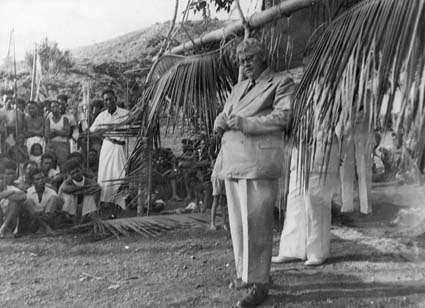
[Papua and New Guinea] Official opening of the Tupusuleia school, 9th November 1949 - Mr E J Hallstrom, at the request of His Honour the Administrator, declares the Tupusuleia school officially open- 9th November 1949 - Papua, Central, Tupusuleia
A photographer in Shangri-la
by RON BERG, staff photographer
I returned from a visit to the Nondugl Livestock Experimental Station in the central highlands of New Guinea with a four-day growth of beard, a solid case cf sunburn and the pictures in this issue. I WANT to go back. I'm all for packing my camera and family in a neat brownpaper parcel and setting off again. It's a positive Shangri-la. It has a constant climate of 70 degrees, there's plenty of native labor, and no housing problem. The sun shines pleasantly through the day, the air is usually cooled at night by a shower of rain, and a week without rain is regarded as an absolute drought. And there's plenty of tucker-all that a well nourished photographer could could need.
The natives are perfect physical specimens, with wonderful teeth and a high intelligence quotient. They are learning sheep breeding and animal husbandry on the Experimental Station, which was established by the Commonwealth Government with a gift of £20,000 from Sydney philanthropist E. J. Hallstrom.
I made my trip to New Guinea with Mr. Hallstrom. The station, to which zoological gardens are attached, is located in a fertile valley surrounded by tall mountains.
The natives haven't seen many white men, and we fascinate them as much as they do us. During my first night at Nondugl I awakened several times to see fearsome-looking head-hunters standing in the door-way of my hut looking at me. Fortunately, they're happy natured fellows. In fact, they're rather timid. The sudden flame from a match or cigarette-lighter fills them with wonderment, and the explosion of a camera flashlight bulb always makes them jump. Three thousand of them put on a welcome "sing-sing" for our party in the grounds around the home-stead of Captain Ned Blood, who manages the station.
They dressed in all the colored fal-lal they could get hold of. It was a terrific spectacle to see them carrying ceremonial stone axes and spears and wearing feathered and pearl-shell headgear.
ZOOLOGICAL EXPERT Dave Bush explains the tree kangaroo to natives in pidgin English. Native in lap-lap is Booka, one of station's houseboys.
STAFF PHOTOGRAPHER Ron Berg and his retinue. The natives carry his luggage and camera gear.
The sing-sing went on all day. For the first hour it was melodious and interesting, but as the day wore on it nearly drove us silly. The singing developed into a chant their stamping feet created a mild dust storm, and thousands of blowflies came from everywhere.
The native Kanana, or tribal love ritual, which was staged for the Hallstrom party at the end of the day, also had its drawbacks. At a Kanana men and women sit in two long, alternate rows in a hut in which eight fires are burning strongly, and chant love songs similar to the tunes Carmen Miranda sings.
The only way I could manage to stay in the hut for as long as ten minutes was by hunching on the ground so that much of the smoke from the fires would go over my head. Even then the tears were running out of my eyes.
I took my first flashlight picture at the Kanana, and it promptly stopped proceedings. The natives mumbled and jabbered until an interpreter explained that the flash would not do them any harm. The natives have a good sense of humor and learn rapidly.
Those working on the station are efficient and willing to learn all they can about sheep. The hundreds who come in daily from the hills are also learning, because they watch the others at work and are always ready to lend a helping hand. In fact, their willingness to share and share alike is an example to white men. They're completely unselfish, and if I gave a native two used flashlight bulbs he would invariably give one to his friend.
The idea of sheep-breeding by natives of Nondugl first came from Ned Blood, who inspects the valley while he was on Army patrol a few days before the end of the war. He suggested it to Mr. Hallstrom, who promptly visited Canberra and told Mr. Chifley and the Minister for External Territories, Mr. Ward, about the scheme and his willingness to finance it. Permission to establish the station was given after ten minutes' talk among the three men. There are 500 sheep at Nondugl and more will be flown up until there are 10,000.
Natives learn all aspects of sheep-breeding, and as each one graduates from the station he will be given a number of sheep and the necessary assistance to set up as a grazier. Other natives are being taught the industrial side of wool. A photographer in Shangri-la (1949, January 8). The Australian Women's Weekly (1933 - 1982), , p. 18. Retrieved from http://nla.gov.au/nla.news-article46938668
THE news that a species of parrot found in New Guinea is to be named after Mr. E. J. Hallstrom, Sydney philanthropist and zoo benefactor, reminds me that a while ago a natural history expert told me that the custom of naming species after people is gradually going out of fashion. So having a species named after you is a special honor these days.
Not long ago a parasite found in the blood of a platypus was named after the Governor of Tasmania, Sir Hugh Binney. Its name, in case you run across it, is Trypanosoma binnevi. Dinneyi.
To the layman that may sound a doubtful compliment. But far from it. The pleasure that a racehorse owner gets when his horse wins the Melbourne Cup is no greater than that of a person interested in natural history who has his name perpetuated in this way. Modern practice except in special cases tends, according to my informant, to use either descriptive names or names relating to localities.
For instance, when you see the name "Tachyglossus aculcatus" you say, "Ha! Tachyglossus means stickytongued and aculeatus means covered with prickles, so, of course, that's a spiny ant-eater." Similarly should you meet a Hederodontus portus jacksoni you will probably throw it back, it's a Port Jackson shark. The Americans, so I'm told, have hit on a nice compromise. They give the creature some good pungent Latin tag to describe it, then in their published matter use an asterisk and a footnote saying who discovered it. Thus may immortality be achieved in a footnote. It seems to me... (1949, October 22). The Australian Women's Weekly (1933 - 1982), , p. 27. Retrieved from http://nla.gov.au/nla.news-article52267507
This was not the only New Guinea species named for Mr. Hallstrom as he also brought the New Guinea singing dog to world attention. In 1956, medical assistant Albert Speer and Officer Jim Sinclair obtained a pair of singing dogs in the Lavanni Valley of the Southern Highlands. These dogs were sent to Sir Edward Hallstrom who had set up a native animal study centre in Nondugl. He studied them for a time and then sent them to Taronga Zoo in Sydney. Subsequently, in 1958 the New Guinea singing dog was classified as a distinct species and was named Canis hallstromi (in honor of Sir Edward Hallstrom). The dog is named for its distinctive and melodious howl, which is characterized by a sharp increase in pitch at the start and very high frequencies at the end.
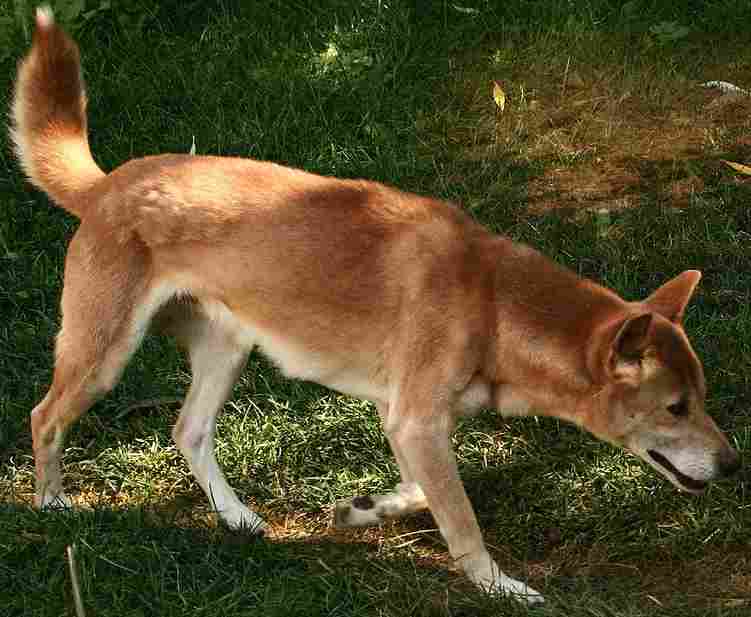
New Guinea Singing Dog on trail - courtesy Patti McNeal
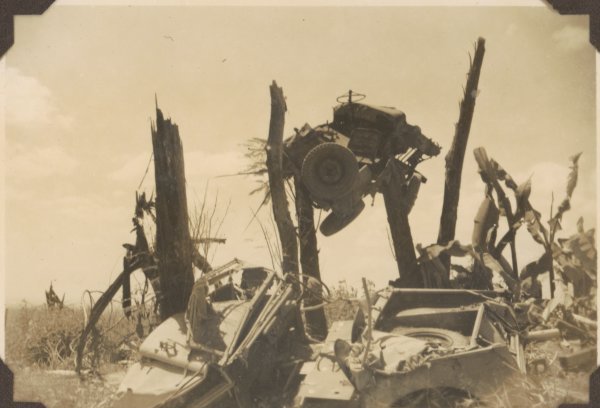
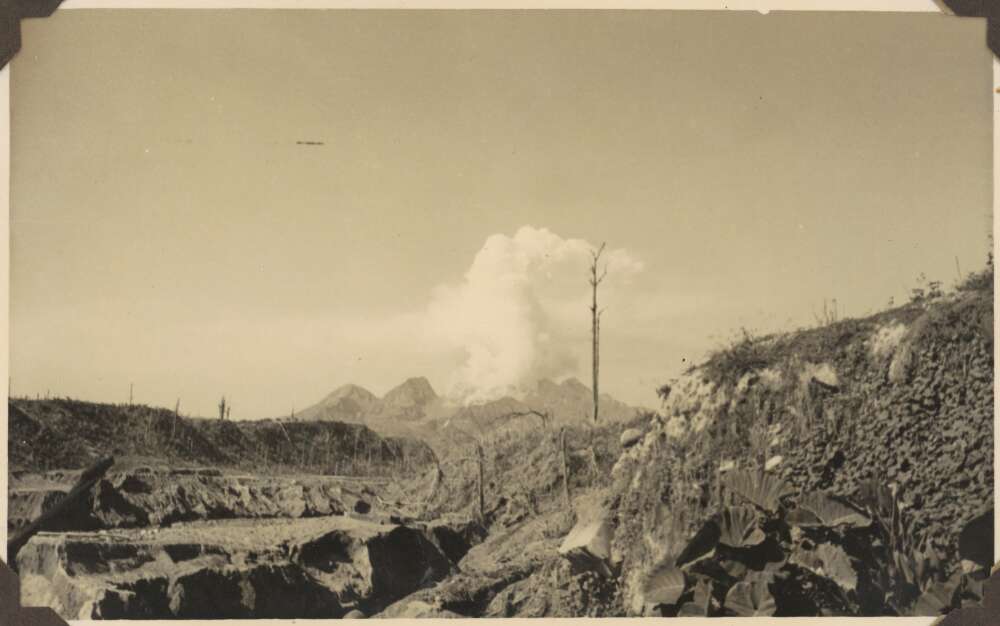
In
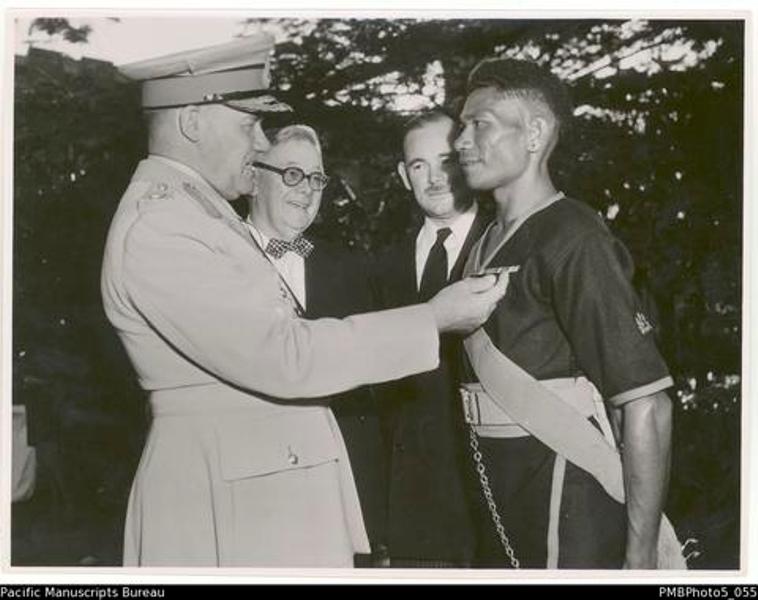
Autumn Years
There was so much written about Sir Edward Hallstrom that we can know his favourite menu was Grilled Lobster and mushrooms, that his glasses were tinted blue, that he suffered all his life from Bronchitis, that he was good at making money but loved spending it as well as investing it in animals, health and people, that he was known as 'Ted' to his wife and friends. We know that he loved birds, that he collected hats worn by the well-known:
SIR EDWARD HALLSTROM is back from his American visit wearing a giant gold ring with a whopper ruby set in it. He says he picked it up in the States. Sir Edward, always a one for collecting hats, picked up at Honolulu and wore home a jolly piece of headgear adorned with a band of finely-woven brilliant birds' feathers. He also has for his private collection of famous hats, one of General Eisenhower's more gaudy military hats. ARTHUR POLKINGHORNE'S (1952, June 25). The Sun (Sydney, NSW : 1910 - 1954), , p. 21 (LATE FINAL EXTRA). Retrieved fromhttp://nla.gov.au/nla.news-article230207780
Hallstrom got hat from Truman. SYDNEY.) — The chairman of the Taronga Park Trust, Mr. E. J. Hallstrom, arrived in Sydney from the US by BCPA, bearing one of President Truman's hats. Mr. Hallstrom recently gave Mr. Truman a collection of Audubon bird paintings for the American people.
"When Mr. Truman heard I collected hats of famous men and was anxious to get one of his, he responded immediately," Mr. Hallstrom said. "He sent one of his hats to the Australian Ambassador, Mr. Spender, and asked him to give it to me," That hat is a large-size grey felt. Whilst in the United States, Mr. Hallstrom secured some grizzly bears and some rare snakes for Taronga Park. Hallstrom got hat from Truman (1951, August 6).The Evening Advocate (Innisfail, Qld. : 1941 - 1954), p. 3. Retrieved from http://nla.gov.au/nla.news-article212296135
Another Hat for Hallstrom - Hong Kong. Friday.-Australian Senator John Armstrong, who visited Chinese Nationalist President Chiang Kai-shek in Taipeh, Formosa, recently has taken home one of President Chiang's old felt hats. A correspondent in Taipeh says Senators Armstrong asked for the hat and got it for Sir Edward Hallstrom, who collects hats. Another Hat for Hallstrom (1952, August 30).Barrier Miner (Broken Hill, NSW : 1888 - 1954), , p. 5. Retrieved from http://nla.gov.au/nla.news-article61216102
What did he do with all these hats? – an earlier article from that same year tells us:
Knight Collects Hats Of The Famous
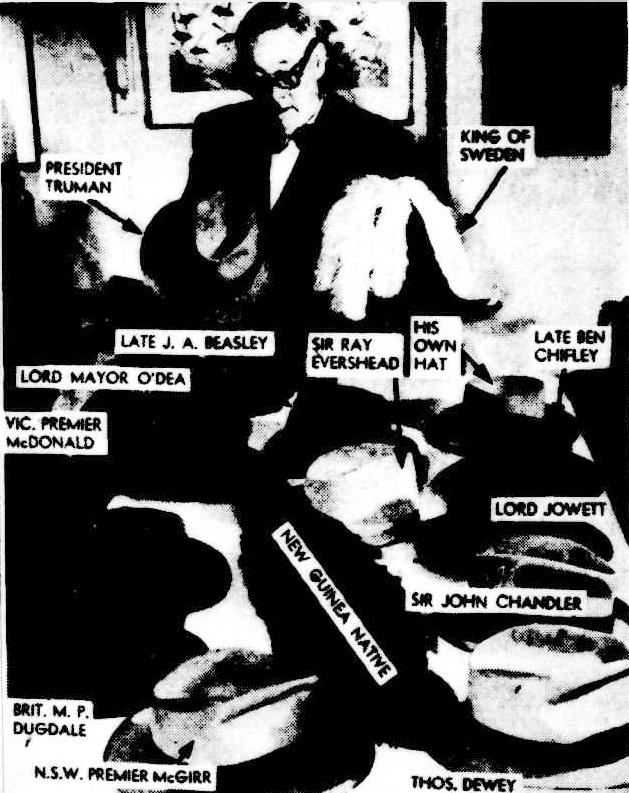
Sir Edward Hallstrom, Sydney industrialist and philanthropist, has set up Australia's first private hat museum. The museum already has 30-odd exhibits of hats worn by outstanding world personalities, including King Gustav of Sweden and US President Truman. One section is devoted to notable Australians. Sir Edward is now awaiting a military cap promised him by US presidential candidate Mr. Eisenhower. 'I believe that the hat a man chooses to wear is an outward indication of his inner personality and it is also the most convenient piece of a man's wearing apparel to collect,' said Sir Edward Hallstrom. Knight Collects Hats Of The Famous (1952, July 22). The Advertiser (Adelaide, SA : 1931 - 1954), , p. 3. Retrieved fromhttp://nla.gov.au/nla.news-article47414873
As shown in one 1950 'Opinion', people could not believe that Mr. Hallstrom had not been honoured for all his work and generosity. That lady's letter was one of several such, including articles by journalists, most of these in rural newspapers, that continued to appear until a knighthood was granted:
A surprising omission from the list of New Year honours was the name of E. J. Hallstrom, President of Taronga Park Trust, and Sydney's most generous philanthropist. If ever a man deserves recognition for his liberality to worthwhile causes and especially to charity, Hallstrom does. Apparently, service to party counts for more these days than service to humanity. Notes from the City (1951, January 17).The Scone Advocate (NSW : 1887 - 1954), p. 7. Retrieved from http://nla.gov.au/nla.news-article160480090
NO KNIGHTHOOD FOR HALLSTROM SYDNEY: The Opposition Leader in the Legislative Assembly, Mr. Treatt, urged that Mr. E. J. Hallstrom should be knighted for his philanthropic work. He was an outstanding benefactor, said Mr. Treatt. Mr. McGirr said that it was against the Labour policy to bestow honours. The Government and the people of N.S.W. recognised Mr. Hallstrom's great philanthropic work. He was confident that Mr. Hallstrom had acted as he had done without wanting any recognition other than the knowledge that he had done good. NO KNIGHTHOOD FOR HALLSTROM (1951, December 6). Goulburn Evening Post (NSW : 1940 - 1954), p. 4 (Daily and Evening). Retrieved from http://nla.gov.au/nla.news-article100170184
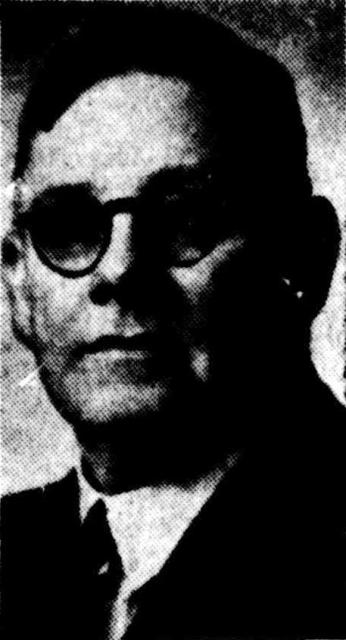 Percy Claude Spender. Knights Bachelor
Percy Claude Spender. Knights Bachelor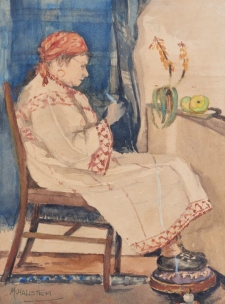 One-time Resident Now Lady Hallstrom
One-time Resident Now Lady Hallstrom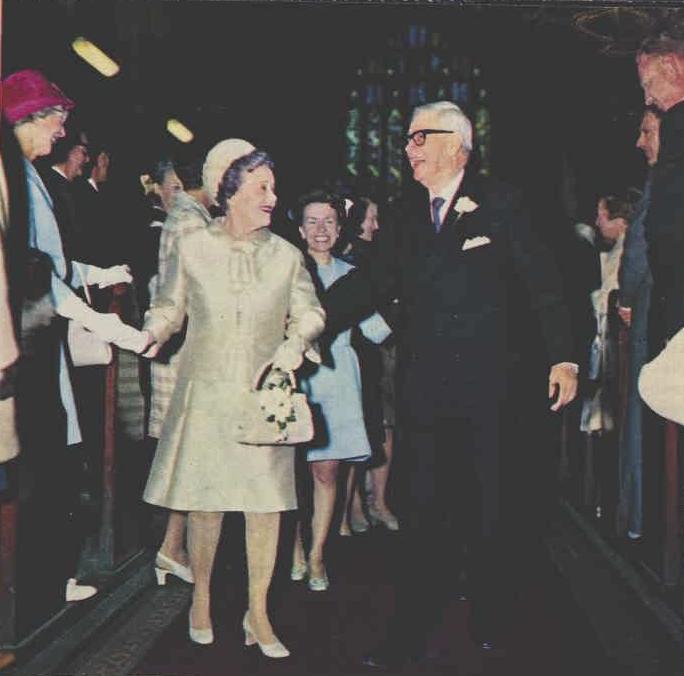
Hallstrom dies
SYDNEY, Friday. — Sir Edward Hallstrom, the Sydney philanthropist, died tonight at his Northbridge home. The 83-year-old electrical-trade magnate was renowned for his gifts to medical research. For many years he was director of Taronga Park Zoo. Hallstrom dies (1970, February 28). The Canberra Times (ACT : 1926 - 1995), , p. 1. Retrieved from http://nla.gov.au/nla.news-article131689382
Service for Sir Edward
SYDNEY. Monday. — Sir Edward Hallstrom, the man who gave away millions, will be buried on Wednesday after a funeral service at St Andrew's Anglican Cathedral in Sydney. Sir Edward, who was 83, died in Sydney on Friday. The funeral service will begin' at 2.30pm and cremation will take place at Northern Suburbs Crematorium, Sydney, at 3.45pm. Service for Sir Edward (1970, March 3). The Canberra Times (ACT : 1926 - 1995), , p. 18. Retrieved from http://nla.gov.au/nla.news-article107911570
Sir Hallstrom's left an estate of $1,049,627 which was reduced to $974,914 by death duty. Between 1971 and 1973 the land at Bayview was sold, as was his family home, and the lands around it, of 21 acres:
House sold. SYDNEY, Thursday. - The 21-acre waterfront home of the late Sir Edward Hallstrom was auctioned today for $370,000. IN BRIEF Hepatitis victims now 26 (1971, October 8). The Canberra Times (ACT : 1926 - 1995), , p. 3. Retrieved from http://nla.gov.au/nla.news-article110680981
Northside estate THE site of the late Sir Edward Hallstrom's family home, which was broken up into eight lots, fetched $741,500 when it was auctioned early in April. More than 200 buyers attended the auction in Coolawin Road, Fig Tree Point (overlooking Middle Harbor), and prices for the blocks ranged from $70,000 to $134,000.
Pictures left and right are two of the spectacular views from the Hallstrom site.
This new estate is expected to be a showplace for sites north of the harbor bridge. Sir Edward Hallstrom, philanthropist, honorary director of Taronga Park Zoo, and pioneer of the Australian refrigerator industry, lived in an old family home on the land for many years. He died in 1970. SYDNEY'S MILLION DOLLAR VIEWS (1973, May 9). The Australian Women's Weekly (1933 - 1982), , p. 8. Retrieved from http://nla.gov.au/nla.news-article47470708
Extras and References
Australia's First Bird Counts - a 115 Year Legacy: Issue 234
Decline of the urban Koala (Phasco/arctos cinereus) population in Warringah Shire, Sydney
Peter Smith and Judy Smith 44 Hawkins Parade, Blaxland, NSW 2774 – September 1990.
ABSTRACT
The Koala population In Warringah Shire has declined over the last 50 years with increasing urbanization. Koalas were reported from various localities throughout the Shire in the 1940's, 1950's and 1960's. They now occur only at Barranjoey Peninsula, Ku-ring-Gai Chase National Pant and, possibly Davidson Park State Recreation Area. The colonies at Barrenjoey Peninsula and Ku-ring-gai Chase National Park have both declined in numbers and distribution since the 1970·s.
On Barrenjoey Peninsula, the main subject of this study, clearing for residential development has steadily reduced the area of forested land from about 705 ha (47% of the Peninsula north of Bungan Beach) in 1946 to about 125 ha (8%) in 1989. The Koala colony on the Peninsula has declined from an estimated 123+ Koalas in 1970 to only about eight Koalas in 1989. The remaining koalas appear to use several to Council bushland reserves as refuges: Angophora Reserve, Hudson Park. Stapleton Park, Careel Headland Reserve, Crown of Newport Reserve and, until 1988, Algona Reserve. The principal food tree on Barrenjoey Peninsula is GJt!y Gum, punctata. Other importllnt food trees are Scribbly Gum, E. haemastoma, and Swamp Mahogany, E. robusta. These food trees occur in low densities in the reserves compared with their former densities elsewhere on the Peninsula. The reserves have also suffered extensive eucalypt dieback associated with urban runoff, and their eucalypt communities are threatened by expansion of rainforest vegetation and Black She-oak, Allocasuarina littoralis, scrub. The chief threats to continued survival of the Peninsula's Koala colony are further loss of habitat, within as well as outside reserves, and further mortality from dogs, motor vehicles and the disease chlamydiosis. The limited information available suggests that dogs have been the chief cause of mortality on the Peninsula, in contrast to other urban colonies studied, where it has been motor vehicles and chlamydiosis. The incidence of chlamydiosis has been low but may pose a particular threat to the few remaining Koalas. The history of Koalas on Barrenjoey Peninsula illustrates how a carefully planned and managed reserve system is crucial for Koala conservation In urban areas. This must be established in the early stages of regional development. The deficiencies of the reserve system on Barrenjoey Peninsula pose enormous difficulties for rehabilitation of the Koala colony now.
Full Study available at: http://publications.rzsnsw.org.au/doi/pdf/10.7882/AZ.1990.004
Never say never / narrative, illustrations and portraits by Esme E. Bell. Published Richmond, N.S.W. : Esme E. Bell, 2007 248 p. : ill. (some col.), Facsims., ports. (some col.) ; 30 cm. Notes: "Esme's father, Edward Hallstrom, around 1927, invented a refrigerator powered by kerosene. It was a huge leap forward for country Australia. "There's always a way," he'd say. "Never think it can't be done."---Cover.
SHEIK STRUTS HIS STUFF
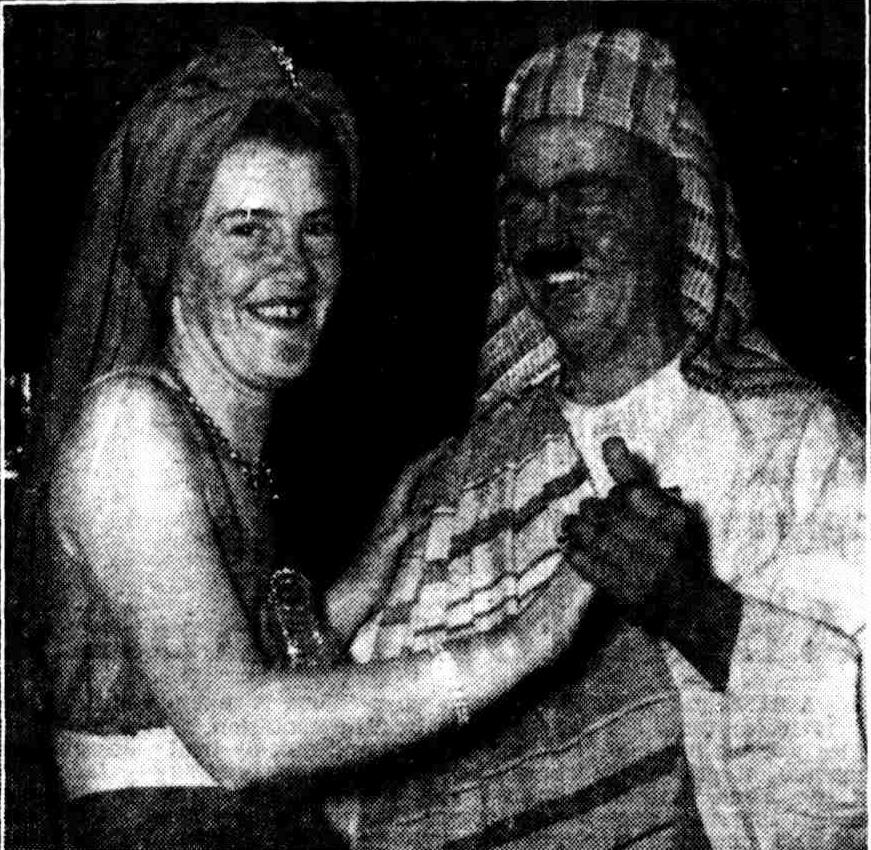
MISS JEAN HALLSTROM and Mr. R. Perritt enjoying themselves at the Journalists' Ball last night. SHEIK STRUTS HIS STUFF (1941, July 13). Truth(Sydney, NSW : 1894 - 1954), , p. 27. Retrieved from http://nla.gov.au/nla.news-article169761080
AUSTRALIAN AERIAL INVENTIONS.
AN extraordinary amount of interest was shown in the meeting convened by the Lord Mayor, which was held in the vestibule of the Town Hall on Friday night for the purpose of considering the offer of the Federal Government of £5000 for the encouragement of Australian inventors in aerial navigation. The room was packed before the appointed time, and the outer doors had to be closed to keep out a number of people for whom accommodation could not be provided. The Aeriai League members were present in foi-ce, the platform having on it several models of aeroplanes. Two of the models were 'flown' in the room by their respective owners, Messsrs. Peacock and Lawrence. The Lord Mayor congratulated the league on the work it had done. He recognised the movement as being one which commended itself to the intelligence of Australians equally with those in the old world. Major Rosenthal moved, — 'That this meeting of citizens of Sydney considers that special attention should be directed to the remarkable developments taking place in aerial navigation, not, only in view of national defence, but also in view of the fact that a successful flying machine will mean a remarkable change in commercial facilities.'
Mr. T. R. Roydhouse seconded the motion. He was sorry to say that, Australian inventors did not get the encouragement in this country that they did in others. He mentioned an inventor who was engaged on the 'Herald,' and who designed a most striking electrical device. That one had the good sense to take his invention elsewhere. He went to America, and it had since been taken up by the British and the German Post Offices.
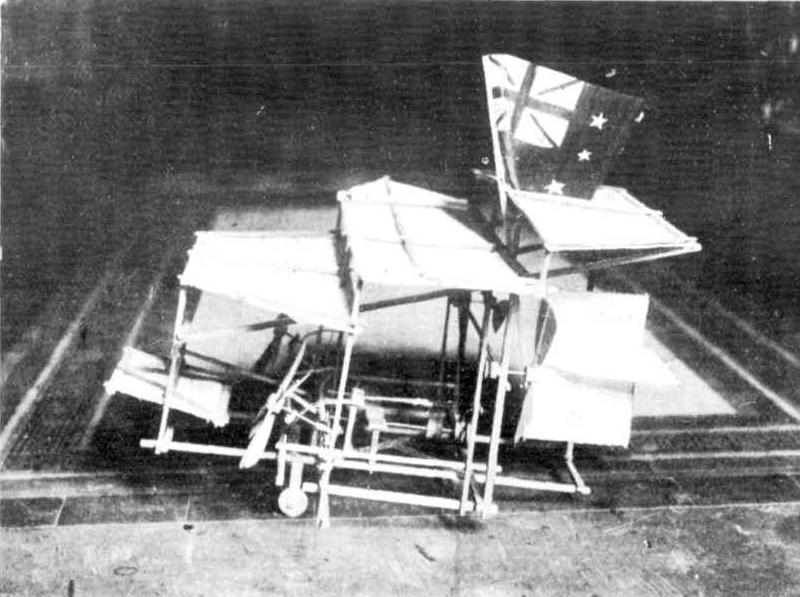
GARTY'S AEROPLANE. The most interesting feature of this machine is its propellers, which, by means of universal sockets, are worked at any angle.
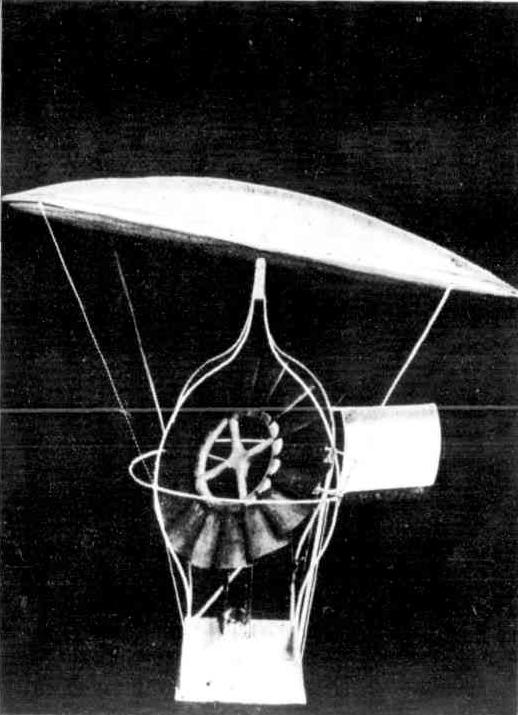
GREEN's FLOATING AEROPLANE. Showing superstructure opened to act as parachute in the event of any acciednt.
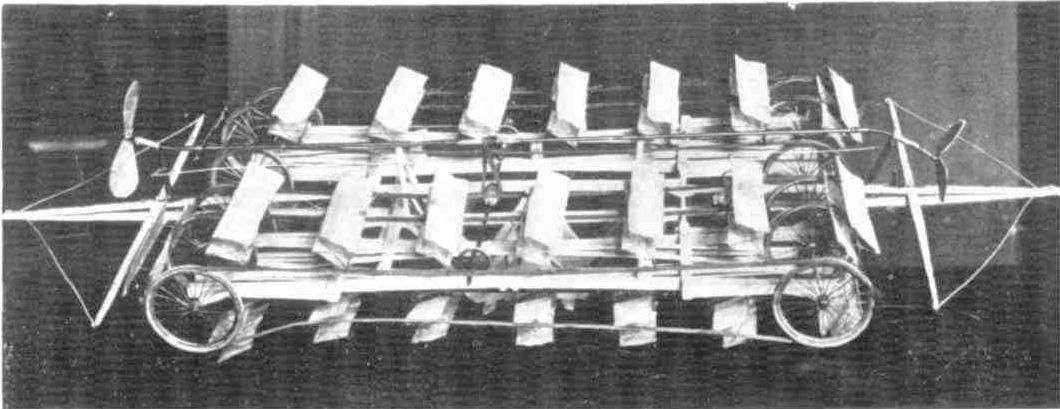
EWING'S AEROCAR. This ingenious machine consists of a series of revolving bi-planes, so arranged that the upper series lift and the lower repel.
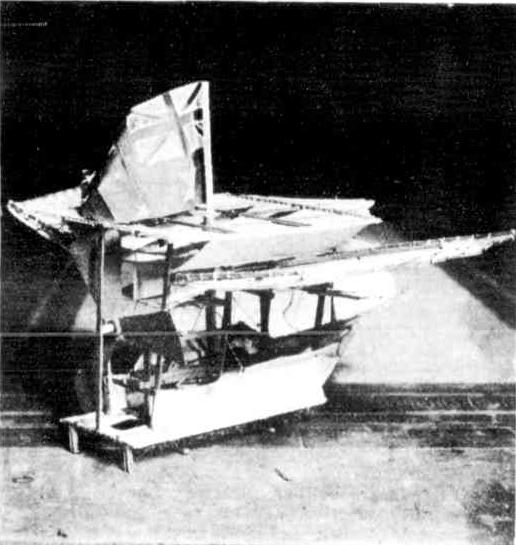
GARTY'S BIRD AEROPLANE. The principal features are its lifting wings and its large propellers.
Mr. Merrivale said that the aeroplane was not expensive. A Dreadnought cost about a million and a half, and 2000 aeroplanes could be built, which would carry 4000 people, for that money. The motion was carried. Mr. Oakes, M.L.A., moved, — 'That this meeting notes with pleasure the offer of the Commonwealth Government of £5000 as a reward to the inventor of the first practical Australian aeroplane, and trusts to see carried out at an early date the stipulation that a similar amount be raised by private subscription.' Commander Brownlow, in seconding the motion, said that a football match or two denied, or a smoke dropped out now and then, and they would soon have the £5000. We should have our own aeroplanes and dirigible airships, not only for pleasure, but capable of being used for commercial and defence purposes.
Colonel Burns supported the motion, and it was carried by acclamation. Brigadier - General Gordon moved, — 'That a fund be now opened, to be called the Australian Aerial Navigation Fund, and that the first £5000 received be devoted to covering the money offered by the Commonwealth Government, the balance and interest of the wliole of the moneys t3 be devoted to forwarding the national objects of the Aerial League of Australia, the in(orest to be divided amongst the various sections in proportion to their membership.' He spoke of the great value of aerial navigation combined with wireless telegraphy. It was far greater than could be realised in an ordinary way of life. Australia's defence depended first on each doing his duty, and, secondly, upon the fact that notice or news of an intended attack should be known to us previous to the arrival of the enemy. By means of aerial navigation and wireless telegraphy we would be in a position to be forewarned. Major Spain seconded the motion. Mr. George Taylor, secretary of the league, said that each of the models on the stage represented stepping-stones in the history in which hearts had been broken and lives lost. The ridicule cast upon Hargreaves was a black spot on the history of Australia until we achieved something great to wipe it out. Hargreaves — a Sydney man — invented the box kite. It was shown to the Wright brothers in America. They made friends with the air with it, and they now put a motor behind it and were flying. Large sums were being offered in Europe and America for specified flights and flying machines — £806,800 altogether — to encourage this great science. The motion was carried with cheers. Subscriptions may be sent to the secretary or treasurer of the league.
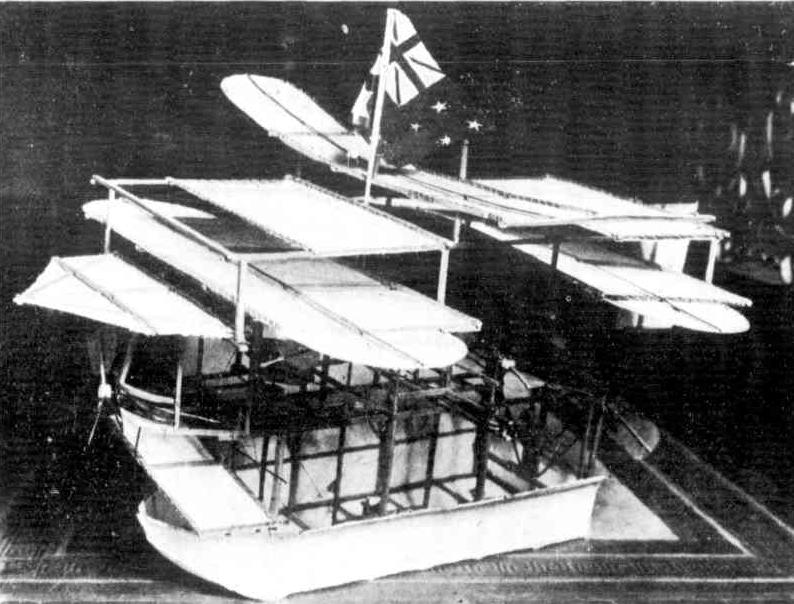
GARTY'S FLYING SHIP. This vessel is designed so that if it falls upon water the mechanism and occupants will be secure.
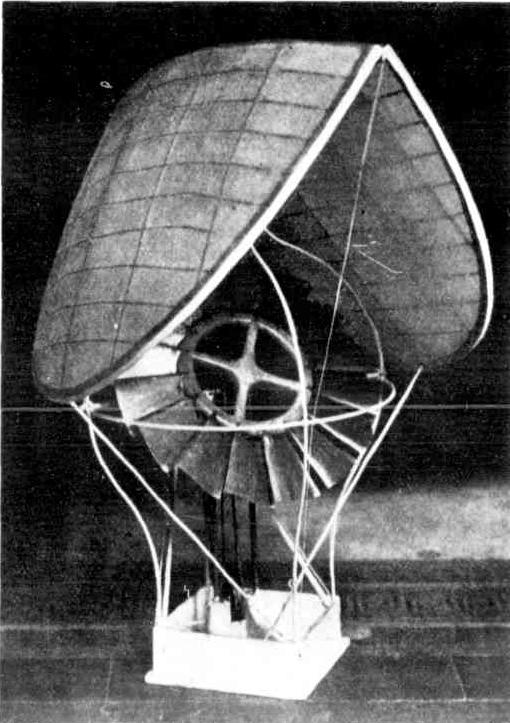
ANOTHER VIEW OF GREEN'S FLOATING AEROPLANE, Its propeller is worked at any inclination without any Ioss of power. It is constructed to carry hydrogen baloonets AUSTRALIAN AERIAL INVENTIONS. (1909, September 1). The Sydney Mail and New South Wales Advertiser (NSW : 1871 - 1912), , p. 34. Retrieved from http://nla.gov.au/nla.news-article164340255
more 1909 Models: MODEL AIR-SHIPS. (1909, September 25). The Australasian (Melbourne, Vic. : 1864 - 1946), , p. 31. Retrieved fromhttp://nla.gov.au/nla.news-article139686811
Extensive article on Hargreaves: GEORGE A. TAYLOR IN HIS MOTORLESS AEROPLANE AT NARRABEAN BEACH (SYDNEY) ON DECEMBER 5th, 1909. (1923, December 29). The Brisbane Courier (Qld. : 1864 - 1933), , p. 10. Retrieved from http://nla.gov.au/nla.news-article20701317
HEAVEN AND HELL
HEAVEN is many things to many people. So is Hell. And many others just don't believe in either. When the London "Sunday Telegraph" conducted a poll on the subject, 23 percent said they believed in Hell and 58 percent said they didn't. Yet when asked if they believed in Heaven, 54 percent said yes and 27 percent said no. Illogical but understandable. "Queen Magazine" then asked some English and European celebrities for their ideas of Heaven and Hell, and we asked the same questions in Australia. Their answers are on these two pages.
LORD THOMPSON, PRESS MAGNATE:
HEAVEN: Sitting on a terrace by the sea, in comfortable clothes, with some ice-cold orangeade to sip and a number of profitable deals which could be made and which I could consider. I would also like some thrillers, and alternate between reading them and studying the deals. Hell: A place where there are no business activities.
LAURIE LE GUAY, PHOTOGRAPHER: IT'S absolute Hell to find a woman with a beautiful face and a raucous voice. For Heaven, I’ll go along with Omar Khayyam; a loaf, a glass of wine, a book, and lots of thous.
NANCY BYRD WALTON, AIRWOMAN:
WHAT is Heaven? To me it is having a weekend in Sydney with that absolutely beautiful weather, my nice friends around, and nice food. And REALLY having nothing to do. Hell is having too much to do and not enough time.
SIR EDWARD HALLSTROM:
HELL is a way of thinking. I don't have any Hell, because I have no terrors about anyone or anything. My outlook toward my neighbor is friendly. Heaven to me now is a happy home life. It's people who make Heaven or Hell.
SIR WILLIAM DOBELL (artist):
I DON’T believe in either of the places.
TRENT NATHAN (fashion designer):
THEY’RE both related to people most of the time. I think that we're really all in Hell now, and it is life on this Earth. That's probably why I believe in Heaven, we are all pretty tough to be able to take everything. Heaven is being with people you love among all this Hell. It's peace and calm peace of mind, doing things that you want to do without having to impress anyone. HEAVEN AND HELL (1969, June 18). The Australian Women's Weekly(1933 - 1982), , p. 32. Retrieved from http://nla.gov.au/nla.news-article43599628
William Hallstrom Snr.
Suspected Incendiarism.
COONAMBLE, Wednesday. — A fire, supposed to be the work of an incendiary, broke out yesterday morning at Hyde Park, near Gulargambone, on a farm occupied by Mr. William Hallstrom, destroying two sheds and a quantity of corn and hay, valued at over £300. The owner was uninsured. The police are making inquiries. Suspected Incendiarism. (1888, November 8). Evening News (Sydney, NSW : 1869 - 1931), , p. 6. Retrieved fromhttp://nla.gov.au/nla.news-article108110055
NO. 2 JURY COURT.
Before Mr. Justice Stephen and a jury of four.
HALLSTROM v. BROWN. This action, which lasted all Monday, was continued on Tuesday. The plaintiff, William Hallstrom, a farmer in the neighbourhood of Coonamble, sued J. Lawrence Brown, a pastoral lessee, for the recovery of £2000 as compensation for injury caused to his land, with the growing crops, fruit trees, and other matters, in consequence of the defendant having so carelessly and negligently constructed a dam on his run, Tonberbine, in the county of Leichhardt, that the water was allowed to escape and overflow plaintiff's land and cause the injury set forth. The evidence for the plaintiff and the defendant was of the most voluminous character; and the main question was as to a dam which was constructed by the squatter close to the farmer's ground, and as to the damage alleged to have been caused by the diversion of water. After counsel had addressed the jury, his Honor summed up, and the jury, after a brief adjournment, brought in a verdict for the plaintiff, with £500 damages. No. 2 JURY COURT. (1888, December 12). Evening News (Sydney, NSW : 1869 - 1931), , p. 6. Retrieved from http://nla.gov.au/nla.news-article108118536
SUPREME COURT.-Friday, February 22.
In Banco.-(Before (their Honors the Chief Justice, Mr. Justice Windeyer, and Mr. Justice Stephen.)
HALLSTROM V. BROWN
Mr. Pring, instructed by Messrs. Bradley and Son, appeared for the defendant, and moved for a rule nisi for a new trial. The case, which was tried in December last before Mr. Justice Stephen, was brought by William Hallstrom, a farmer, residing near Baronne Creek, in the Coonamble district, and in the vicinity of defendant's run, to recover compensation for injury done to his crops, fruit trees, &c, between July, 1886, and July, 1887, owing to the negligent construction of a dam by defendant, in consequence of which a large body of water was allowed to flow over and accumulate upon the plaintiff's land and cause the injury complained of. The jury returned a verdict in favour of the plaintiff with damages £500, and the defendant now sought to have this verdict set aside and a new trial granted on the following grounds:-(1) That the verdict was against evidence; (2) that the defendant at the trial was taken by surprise by the evidence of the plaintiff that no water came on to his land after the defendant's dam had broken away, and that such evidence, as appears by affidavits filed herewith, is absolutely false ; (3) that since the trial the defendant has discovered certain evidence, which, if it had been produced at the trial, would have entitled the defendant to a verdict. This first ground was, however, abandoned.
After hearing Mr. Pring, The Chief Justice said that consistently with the decision of this Court, the ground that the verdict was against evidence had been abandoned. With respect to the ground that the damages were excessive, he thought there was abundant evidence before the jury to justify the verdict. Then, with respect to the matter of surprise, it seemed to him that the alleged matter of surprise was a matter which defendant might reasonably have anticipated. He found it stated in the declaration that "the land for a long time was covered with the said water." Well, if the lands were not covered with the water sent down the creek by the dam being cut away, the defendant ought to have been in a position at the time to bring witnesses to prove what was now set out in the affidavits now before the Court, so as to show that the cutting away of the dam did not cause the land to be covered with water, and that on the contrary it was covered with water owing to previous heavy rain. That might have been anticipated by defendant. Now, he simply wished to have the case tried again, and to adduce further evidence in support of his case. That was not, he thought, a ground of surprise. It must be shown to be some matter sprung upon the defendant at the last moment, or some new matter which they could not foresee either by the pleadings or in any case have reasonably anticipated. Mr. Justice Windeyer and Mr. Justice Stephen concurred. Rule refused. LAW REPORT. SUPREME COURT.—FRIDAY, FEBRUARY 22. (1889, February 23). The Sydney Morning Herald (NSW : 1842 - 1954), , p. 8. Retrieved from http://nla.gov.au/nla.news-article13715178
COONAMBLE, Friday
A protracted inquiry, before Mr Mr. R Bailey SM , District Coroner, and a jury of 12, which was held over the fire at Coonamble West, at which property insured for £500 was destroyed, has terminated. The jury brought in a verdict that the fire was wilfully caused and added a rider to the effect, that they did not believe the evidence given by William Hallstrom owner of the property. Hallstrom has since been arrested. COUNTRY NEWS. (1890, February 8).The Sydney Morning Herald (NSW : 1842 - 1954), , p. 9. Retrieved from http://nla.gov.au/nla.news-article28277384
GILGANDRA, Friday.
It is asserted that one of the witnesses in the case of arson with which Hallstrom was charged at Coonamble has confessed to having been guilty of perjury in the case. COUNTRY NEWS. (1890, February 22).The Sydney Morning Herald (NSW : 1842 - 1954), , p. 12. Retrieved fromhttp://nla.gov.au/nla.news-article13760526
Two cases caused considerable local interest, one against John William Clarke, a well-known selector, for making unlawful use of the provisions of the Land Act of 1884. Accused, who was defended by Mr. D. Buchanan, was acquitted. The other case was against William Hallstrom, for burning down a shed in West Coonamble, in which he had property insured for £500. Mr. D. Buchanan also defended the accused, who was also acquitted. COUNTRY NEWS. (1890, March 24). The Sydney Morning Herald (NSW : 1842 - 1954), , p. 8. Retrieved from http://nla.gov.au/nla.news-article13764302
BOOTS AND WINGS.
BY W. HALLSTROM.
To walk this flinty soil below
We need the cobbler's trade,
We must to heav'n if we would go,
Be in' bright wings array’d.
Soles for earth's dry and dusty road
The cobbler may prepare,
But souls for way that leads to God
Need pilots of the air.
The cobbler he may make the sole,
And he may mend it too,
He asks but for a simple toll,
When he has made his shoe.
But gents who claim to wing to heav'n
Have nothing they can show,
They claim, but nought of proof is giv'n,
How far their wings will go.
These confidential coves well know
Their name is but a trick,
But still they play it very low,
And to the fraud they stick.
The honest cobbler plies his trade,
For which he gets his mite,
But what he gets for what is made.
Is far below the right.
The reverend rogues and schemers pose
Above all sons of toil,
But when the ranks of labor close,
' Look out for dusty soil.
Meanwhile their fraud, of wings for heav'n
Is doubtful as a trade,
Some say that only wings are giv'n
When Popish priest have pray'd.
And others think a soul's well-wing'd
By pilots Anglican,
Who when the bells had duly ring'd
To church they' quickly ran.
And ranters and dissenters say
Souls may be wing'd for skies
By every or by any way,
True faith will make them rise.
The sturdy cobbler boasts that he
Makes solid soles that wear,
And that a heav'n we cannot see,
Is naught but fine, thin air.
And that a soul with fancy wings
Is not a thing at all,
And that alone in dreams such things
The thoughts of men appal.
The solid sole for solid ground
Is what he claims to be,
Of value in his travels round,
Whether o'er land or sea.
Let souls he says take wings and fly,
I stick to soul right here,
The soul's too vague, and heaven's too high,
Sky pilots costs too dear.
BOOTS AND WINGS. (1910, August 20).The International Socialist (Sydney, NSW : 1910 - 1920), , p. 5. Retrieved from http://nla.gov.au/nla.news-article130880219
Mary Ann Hallstrom (née Colless)
Death of Mr. Charles Colless.
We take the following from the " Mudgee Post " of Monday last:—
Another old identity passed away on Wednesday morning, in the person of Mr Charles Colless, of Fairy Dale. For a long time past the deceased had been ailing in fact, he had enjoyed but very indifferent health during the last 10 years or more, but it was only within the last few months that his condition showed alarming symptoms. During the month of December last he was prostrated by a severe attack of diarrhoea, and although medical aid was early procured, the disease held to its victim with such tenacity that he was never entirely free from it since. From the first Dr. Lester had pronounced the prognosis as unfavorable, and had warned the family that a sudden change for the worse might occur at any time. His condition, however, improved somewhat, and at times it was thought that he might yet get right again; but on Monday he was unable to leave his bed, and it was feared that the 'dred messenger ' was really close at hand at last. On Tuesday Dr Lester advised the sending for the various members of the family, as he did not think the patient could live through the night. Accordingly wires were despatched with all haste, and in response to the numerous calls, most of the family arrived early on Wednesday morning, but were too late to see the end. Exhausted nature had at last been compelled to effect the final separation of souI and body, and at 7.86 that morning Mr Charles Colless bade farewell to the joys and sorrows of this sublunary sphere, and entered peacefully into the realm of the Unseen. By a strange coincidence the train was about half-an-hour late that morning, and thus four of the daughters, who had been so hastily summoned from Sydney and Lithgow, arrived just too late to see the end. Mr John Colless was more fortunate, for, though in Guntawang at the time the wire was sent off, he managed to reach Mudgee during the night. A sadder fate was that of the eldest brother—Mr George Colless, of Box Ridge—who could not so much as hear of the impending trouble until it was all over, while harder still was the lot of the youngest daughter—Captain Helen Colless (S.A.)—who was in Victoria at the time, and was not able to reach home to see the end.
The deceased was within a few months of his 74th birthday, having been born at Castlereagh, near Penrith, on 11th June, 1824. Although brought up by his father as a farmer, he never settled to the life, and was for some years well-known as a teamster in the old days. It was while still working for his father that the Rev S. Wilkinson joined him in wedlock to the wife who now survives him. About 25 years ago he left his own property at Penrith and came to Mudgee, where he has ever since resided. He was the father of 14 children, 11 of whom are still living. Mr Colless was well and favorably known in the Penrith District, and had been a local preacher in connection first with the Wesleyan and then with the Primitive Methodist Churches from early manhood. Much sympathy is expressed on all sides for the bereaved ones, for the deceased had ever been an upright, worthy citizen, a model husband, and a kind and indulgent father. The funeral took place on Friday, the melancholy procession starting from the deceased's late residence at a few minutes past 10 o'clock. The coffin was taken into the Primitive Methodist Church, where a short service was conducted by the Rev J. W. Horberry, and several of the late Mr Colless' favorite hymns were sung. The cortege was afterwards re-formed, and proceeded to the cemetery, where the remains were interred in the Primitive Methodist portion of the ground, the Rev Horberry officiating at the grave. There was a large attendance of mourners and friends, both in the Church and at the cemetery. On Sunday morning a memorial service was held in the Primitive Methodist Church, when the Rev J. W. Horberry made special reference to the veteran who had so lately been removed from his earthly work. For half a century, he said, the one whom they had lost had been an active worker, occupying the position of local preacher for nearly all that time. While health permitted he had ever been a most zealous laborer in the great field, and had, at different times, filled all the offices open to laymen in the Church. Of late years failing strength had prevented him from taking much active part in public work, but he had still been ever anxious to continue his work of visiting the sick, his last offices in this connection being performed but a few weeks prior to his death. His suffering had been great, but he (Mr Horberry) was happy to be able to say that he knew of nothing in his life with which to find fault. He was broad and liberal in his views, constant and consistent in his life, and earnest and eager in his endeavors to do good. They all deeply felt and deplored the loss they had sustained.Family Notices (1898, April 2). Nepean Times (Penrith, NSW : 1882 - 1962), , p. 3. Retrieved from http://nla.gov.au/nla.news-article101308390
COLLESS.—May 3, at her residence, Nepean Cottage, Castlereagh, Eva, only and dearly loved sister of Mrs. M. Colless, Inverleigh Station, Normanton, Queensland. Family Notices (1898, May 31). The Sydney Morning Herald (NSW : 1842 - 1954), , p. 1. Retrieved fromhttp://nla.gov.au/nla.news-article14145837
JONES—HALLSTROM.—June 8, at the Wesleyan Church, Cleveland-st., city, by the Rev. H. Jones, Alexander Thomas, second eldest son of Charles A. Jones, and grandson of the late William Charles, of Castle Hill, to Elizabeth Ellen, eldest daughter of William Hallstrom, and granddaughter of the late Charles Colless, of Mudgee. Family Notices (1898, June 18). The Sydney Morning Herald (NSW : 1842 - 1954), , p. 1. Retrieved fromhttp://nla.gov.au/nla.news-article14169380
Obituary - MRS M. A. HALLSTROM.
The late Mrs Hallstrom was a daughter of the late Charles Colless, of Fairy Dale, Mudgee, and a great-granddaughter of the late John Lees, of Castlereagh, near Penrith, whose name is famous in Australian Methodism as the one who gave the first block of land the Methodist Church ever possessed in Australia — the site of the church at Castlereagh. Mrs. Hallstrom was born at Castlereagh in 1852, and later, with her parents, came to reside in Mudgee. After her marriage in 1873 she went to the Castlereagh, where her husband had taken up land on Tunderbrine Station. Later, having disposed of the property, they went to live for a brief time in Coonamble, and then moved to Sydney, where Mrs. Hallstrom resided until her death, which occurred at the residence of her daughter, Mrs. Simmons, of Nicholson Street, Strathfield, on Sept. 8, 1927.
The remaining members of the family are: William (Summer Hill), Mrs Handock (Belmore), George (Sydney), Edward (Sydney), Percy (Sydney), and Mrs J. J, Noad (Hurlstone Park), and Mrs A. Jones (Melbourne), all of whom were present at the funeral with the exception of Mrs Jones, who was not able to be present owing to the distance. The funeral took place at Rookwood, the service being conducted by the Rev. Mr Poole, of the Bur- wood Methodist Church, whilst Mr A. Ward delivered an address both at the home and the graveside. The late Mrs. Hallstrom was a woman of fine character, 'Her children rose up to call her blessed, for as a mother she fulfilled nobly the duties which came upon her. Outside the immediate circle of her family her memory abides as a woman of kindly, generous nature, whose home was always open and whose gracious presence made it a home from home to all who were privileged to enter therein. Upon receiving word of Mrs Hallstrom's death, Messrs J. W. and A. E. Colless (brothers), Miss Colless (sister), Mrs Button (niece), and P. J. Flack (nephew) left for Sydney to be present at the funeral. The deceased is survived by the following brothers and sisters: J. Colless (Lutterworth), John W. Colless (Mudgee), Mrs John Flack, Albert E. and Miss Jessie Colless (Mudgee), Mrs M.' L. Pack (Newcastle), E. S. Colless (Sydney), Mrs Arthur Ward (Enfield, Sydney), Miss Flo. Colless (Southern Line), and Mrs Albert Hargraves, Emu Plains. Obituary (1927, September 22). Mudgee Guardian and North-Western Representative (NSW : 1890 - 1954), p. 14. Retrieved from http://nla.gov.au/nla.news-article155937707
NICE CROC. Present T o Zoo A REAL PET
MR. ST. JOHN ROBINSON, of Townsville (Q.) makes a hobby of keeping crocodiles. He thinks the world of them, but as a personal favor to Mr. H. B. Brown, secretary of Taronga Park, be is sending a 16ft. specimen to the Zoo. In a letter to Mr. Brown, Mr. St. John Robinson says : — "I am forwarding to you by steamer the big crocodile that I promised you. "I am really sorry to part with this croc., as I have had him for seven months and his length is about 16ft. He is the most contented chap I have ever handled, and I will feed him on Wednesday morning before I put him Into his box, and I fail to see why this fine specimen of a croc, should not live at your Zoo for all time. "I suggest that you feed him twice a week with about two or three pounds of any kind of flesh, from a billy-goat to an elephant. He will thrive on any kind of meat, and he eats occasionally now himself. Feed the Brute "When he arrives, I suggest that you give him about 3lb. of any kind of flesh, and that will keep him contented. I will fasten a couple of sticks to his cage to handle him. "Directions. — With long stick, touch him behind neck and he will open his jaws; you can throw a half-inch rope over his jaw and get the rope on his upper jaw, then tighten and pull him towards you; if he is not facing you, throw the meat into his mouth and. with the blunt end of the stick, push it down his gullet, and you will see him swallow. "You will find, when you take a strain on the rope, he will roll; but if you slacken rope he will remain quiet — I am sure you will manage him and you will have no trouble after the first attempt. It takes me about three minutes at the most to feed him. "I have advertised for the dingoes, but I am afraid they will be hard to got, but may get them any time. The pelicans have all left the district, and when they return I will snare you some. The snow goose arrived safely, and many thanks. Later I may ask you for a young ostrich." NICE CROC. (1934, March 14). The Sun (Sydney, NSW : 1910 - 1954), p. 16 (LAST RACE EDITION). Retrieved from http://nla.gov.au/nla.news-article230542714
Dear Playmates, — I have lots of Zoo news to tell you, but may only put in a little at a time. Six gibbons — they are apes without tails, you know, Playmates — are expected to arrive at Taronga Zoo earIy next month, and' they are coming from the -jungles of Sumatra. Taronga is sending over four kangaroos in exchange, and in the ship that brings in the gibbons will be four very rare blue-birds, known as fairy rollers. The Children's Playground (1940, February 29). The Catholic Press (Sydney, NSW : 1895 - 1942), p. 36. Retrieved from http://nla.gov.au/nla.news-article106341681
Margaret (nee Jaffrey) Hallstrom's Father
TINANA WATERWORKS.
Yesterday, at the invitation of the Chairman of the Waterworks Committee of the Municipal Council, Alderman Harris, a party of citizens paid a visit to the Teddington Waterworks. There were sixteen in all, and they were con-veyed from Maryborough in Nicol's spanking coach and four and two buggies. After a very pleasant drive by the Gympie road route, the pumping station was reached at about 2 o'clock, and the company immediately adjourned to a very seductive lunch prepared by the engineer, Mr. D. Jaffrey, in his house. A round of toasts were speedily made up, opened by the usual loyal obligation, and followed by 'The Municipal Council,' proposed in a very long speech by Mr. John Walker. The Mayor (Alderman Dawson) responded briefly. Alderman Booker then proposed the health of the Works Committee in a most eulogistic speech, and mentioned that they would soon have £25,000 to spend in the extension of waterworks. They had much to thank Alderman Harris in his constant display of discretion and good judgment. He hoped that citizens would be invited out to the waterworks every year, in order that they might realise what magnificent works Mary-borough possessed. Alderman Harris, in modest praise of the efforts of the Committee of which he was head, explained their intentions in the future. Mr. A. F. Sapsford also responded. Mr. C. A. J. Woodcock proposed the "Old Identities' in most humerous style, and several others were honored, especially a most hearty one to Mr. and Mrs. Jaffrey. Mr. Jaffrey returned thanks, and mentioned that while in 1881, 27,000,000 gallons were pumped into tbe reservoir, last year no less than 74,000,000 gallons were sent through the pipes. Altogether about two hours were spent in post prandial orations of a convivial nature, so that there was very little time left for any inspection to be made. How-ever, a run was made through the engine room, where the beautifully clean and polished machinery, working away so noiselessly, won deserved admiration. Several gentlemen then went to see the new bridge over the creek that has replaced the one swept away by the late flood. It is a strong wooden, tressle bridge, 132ft. long, very much resembling the railway bridges, and has been constructed to allow of another rising main being taken across. Safety from future floods is assured by fixing heavy skids on both sides against the piles, and it is altogether a very stable appearance, and it is not likely that we shall again hear of its having been carried away by storm-waters. Dr. March took several barometrical measurements of the heights of various hills en route, and found the reservoir hill to be 207 feet above the Town Hall verandah. The party re-turned home by the Teddington road, very rough by the way, and reached town shortly before six, the time having been spent most enjoyably, notwithstanding the cold raw day. Regarded as a visit of inspection, we are afraid that the trip must be put down as a failure, for by far the greater amount of inspection was done through glasses — beer glasses. TINANA WATERWORKS. (1887, May 17).Maryborough Chronicle, Wide Bay and Burnett Advertiser (Qld. : 1860 - 1947), , p. 3. Retrieved from http://nla.gov.au/nla.news-article146782096
THE TEDDINGTON WATERWORKS. MR. D. JAFFREY'S RETIRING REPORT.
The following report from Mr. D. Jaffrey, who has been Engineer-in-Charge of the Maryborough Waterworks at Teddington since they were taken over in 1881, and who has now resigned, was tabled at the last meeting of the Municipal Council :— Pumping Station, Teddington, 28th February, 1910. "The Right Worshipful the Mayor and Alderman of Maryborough.
" Sir and Gentlemen, — As my resignation is now in your hands, I take the liberty of laying before you several facts in connection with the Waterworks since I took charge, on the 3rdAugust, August, 1881, that being the date the works were taken over from the Government by the Municipal Council. For many years I carried on the works under disadvantages that I venture to say not many engineers would have. By careful handling and driving the engine and pumps no accident of a serious nature has taken place, and any overhauling and repairs that required doing had to be done during the night as to have the pumps ready to start in the morning. Outside the pumping station, the first serious accident occurred on the night of the 21st January, 1887, when Oakey Bridge was carried away by flood, with about 100 feet of the rising main. I was instructed to put Mr. John Linklater on with a gang of men, when a temporary tressle bridge was built, the pipes laid across, and the engine started again in three days, which I consider was quick work. I then received instructions to prepare plans and specifications for a new bridge, and this was in due time completed and the pipes laid on it. "I would then refer you to the great flood of 1893. I think I was of service to the Council at that time, in suspending the pipes across the gap in the bridge of 400 feet. The work was eventually completed and the water turned on to the city. How was I treated on this occasion? My salary was reduced by £2o, as an excuse for retrenchment. Were the other officers treated in the same way? Not so. This appeared to me at the time very strange ; and while the work was going on for three weeks I did not know what it was to have dry clothes on, and the work when completed did good duty for over fifteen months, until the new syphon was completed and laid in the bed of the river. The plans and specifications for this work I also prepared, also for other work going on in town, and to the best of my ability . "When the Council decided to erect a duplicate pumping plant, I received instructions to prepare plans and specifications, from which tenders were called and that of the late Tooth & Co. accepted and the work duly completed, and the contractors did not receive one penny above their contract price of nearly £3,000. With reference to this engine, I may state plans and specifications were submitted to Mr. Goldsmith to report upon, well knowing that they must be approved of by Mr. Henderson before he would grant a certificate for the loan; and he did not find one single error in them, neither did Mr. Gold-smith, who received a fee of £15 15s. I was also complimented by Mr. Wilson, the late manger of Walkers Limited, on their being perfect in every detail, and the engine has given every satisfaction, and may be termed a high duty engine as it is better adapted for pumping direct under the stand-pipe than the old engine. "When, in my opinion, it was necessary to instal new boilers you were not satisfied with my report, until one of the Government inspectors confirmed my report after a thorough inspection. In due time tenders were called, and two tendered— one from Walkers Ltd., and one from Babcock & Wilcox, and that of Walkers Limited accepted. The boilers are what is termed the Cornish type, and since they have been under steam, not one single penny has been expended on brick-work. The other is what is termed the water tube type, and from what I could learn they are a source of expense, as the furnaces are entirely of brick. There were two of this type of boilers installed at Messrs. Hyne & Sons' sawmill about the same time as the boilers here. I am still of the opinion I was justified in recommending the Cornish type, and was approved of by the hydraulic engineer. "You are aware I have been called into town on many occasions on Council business, and any thing that has taken place here during my absence I am to be excused, if I could not give the proper dates, and I think you are a little to blame in taking me away from my duties. "I have, at all time given you of the very best that is in me, and, seeing that I have charge of the largest asset you have (and I am not ashamed of the present state and condition the machinery is in), I therefore think the Waterworks' Committee should have quarterly visits, as I have frequently recommended. "I also thank you for allowing me to leave, before the term of my agreement with the Council expires. "I have the honor to be, etc., "DOUGLAS JAFFREY, "Engineer." THE TEDDINGTON WATERWORKS. (1910, March 4). Maryborough Chronicle, Wide Bay and Burnett Advertiser (Qld. : 1860 - 1947), , p. 3. Retrieved from http://nla.gov.au/nla.news-article148742288
"A Piece of Impertinence."
At a meeting of the Municipal Council to-night the resignation of (Douglas Jaffrey, engineer in charge of the waterworks since 1887, was accepted (our Maryborough correspondent wired last night). A letter from Mr. J. Howitt (chief inspector under the Machinery and Scaffolding Act) stated that as the engineer had resigned the permits issued to the two assistants at the waterworks were cancelled in accordance with the Act, and calling attention to a penalty of £5 per day attached to a breach of section 65. The Mayor indignantly characterised the letter as a piece of impertinence, and several other aldermen spoke similarly. Alderman A. Dunn was deputed to interview the Minister on the subject of the inspectors interference, the contention being that, as two weeks were still to run of the month's notice given by Mr. Jaffrey, the inspector's letter is premature. A non-official presentation will, it is said, be made to Mr. Jaffrey. "A Piece of Impertinence." (1910, March 2).The Brisbane Courier (Qld. : 1864 - 1933), , p. 4. Retrieved fromhttp://nla.gov.au/nla.news-article19623110
MARYBOROUGH CITY COUNCIL. MARYBOROUGH. March 17.
A long discussion took place on Tuesday | night at the meeting of the Maryborough Council on the question of the salary, to be paid to the engineer in charge of the waterworks. The salary was recently fixed at £156 a year- a reduction on the amount paid to Mr. Douglas Jaffrey, who recently resigned the position to accept a Government appointment. Alderman A. Dunn urged that the salary should be increased to £200 a year. The Mayor (Alderman C. S. M'Ghie) pointed out that Alderman Dunn's proposition aimed at rescinding a previous motion fixing the salary at £156 per annum, and was not in order. He decided, however, to permit the discussion to proceed. Alderman Hyne seconded the proposition, and Alderman C. Crystall supported it. Aldermen C. Robaa, Barbeler, Tuohy, and White opposed the motion, which was eventually defeated. MARYBOROUGH CITY COUNCIL. (1910, March 18). The Brisbane Courier (Qld. : 1864 - 1933), , p. 2. Retrieved from http://nla.gov.au/nla.news-article19625752
OUR WATERWORKS. MR. JAFFREY'S ANNUAL REPORT.
The following is the annual report for 1894 of Mr. D. Jaffrey, Engineer in charge of the Teddington Waterworks : -Gentlemen, — I have the honour to lay before you a resume of work done during the year 1894. Since the commencement of the year nothing of a serious nature has occurred at the pumping station to in any way stop the water supply, and all the machinery has been kept in a fair state of efficiency. At the beginning of the year a very important branch in connection with your water supply was completed, viz., the connection of the gravitation main on both sides of the river by means of a wrought iron syphon 12in. diameter laid across the bed of the river and was satisfactorily completed and tested and the water turned on on the 24th February, and performing its duties well ever since. The suspended pipes that were laid across the gap at the bridge acting as a temporary means of water supply, were carefully taken down without accident, and I understand have been cleaned and painted, and which could be used again for temporary work ; also all the cables and gear have been put away at the Town Hall. The rising main and service reservoir have been kept in fair condition ; the undergrowth and long grass have been cut away from the reservoir. I may mention the stand pipe has only been in use about six weeks, and I anticipate no further use for it at present, as there has been considerable rain. The rising main bridge at Oakey Creek is also in fair condition, and would be the better of a coat of tar, which I will attend to at the first opportunity. The other bridge over Oakey Creek requires little doing to it and a coat of paint, which I will also attend to. There are several of the telephone poles in a very bad state, and would require to be renewed. Pumping Station.— The machinery has been kept in a fair state of efficiency. I have had the suction valve on main pump out, which is a job that takes some considerable time, and by procuring assistance I was able to effect the repair to it without sending it to town. I have a spare one ready for service in case of accident. The bucket on main pump has also been replaced by spare one I always have by me. A slight accident occurred on one of the boilers, viz., the pipe that connects the gauge glass broke off close to the boiler, which necessitated my getting up steam on the other. I effected the necessary repairs, and it is in good order again. I have not put on the composition on the boilers yet, but will attend to it as soon as possible, as the old com-position is peeling off in several places and will have to be attended to, as it is a great saving in fuel having the boiler and steam pipe covered. The air pump I have overhauled and done repairs where required, but I may state will require new packing rings very soon. The lightning conductor dropped off the chimney, the brackets giving way that secured it. I engaged a man and had it fixed up again. I have only to refer to the bottom cover on the high pressure cylinder, which gave me considerable trouble, in effecting the repairs. There was only about 5 feet of water in the reservoir when I got finished and the engine started again, and proves beyond anything the necessity of another engine and pump. In carrying on the works during the year I have endeavored to be as economical as possible, at the same time keeping everything up to a fair state of efficiency. The quantity of water delivered from the pumping station from 1st January to 31st December, 1894, 83,638,360 gallons; quantity of firewood consumed at the pumping station from 1st January to 31st December, 1894, 476 cords. I have, &c. Douglas Jaffrey, Engineer. OUR WATERWORKS. (1895, January 10).Maryborough Chronicle, Wide Bay and Burnett Advertiser (Qld. : 1860 - 1947), , p. 2. Retrieved from http://nla.gov.au/nla.news-article146903821
Obituaries. The many, friends of Mr. Douglas Jaffrey, formerly for many years Resident Engineer at the Teddington Waterworks, will regret, to learn that he died to Brisbane on Tuesday night after being in ill health for some time. The deceased who had previously followed his calling as a marine engineer and came out to Australia as chief engineer of a big steamer, was given the appointment of Engineer-in-Charge as soon as the Waterworks were completed in 1878 and had held that position up to about three years ago, when he retired from the service of the Municipal Council- Mr. Jaffrey gave very valuable service to the town during that long period over 30 years, and kept the machinery under his care always in splendid working order. Many years ago he personally constructed an electric plant with steam engine to drive it and installed it in the works. The part he took, in keeping the town supplied with water when the great flood of 1893 had swept away the old Maryborough ridge and the connecting water pipes with It as well as destroying the syphon under the river will always keep his name prominently associated with the memorable disaster. With much ingenuity skill and the utmost determination, under supreme difficulties he succeeded in spanning the great gap in the bridge by means of water pipes suspended in the air by wire ropes and stays, and this rendered good service for many months until a new siphon was laid. In social life, Mr. Jaffrey as a patriotic Scotchman, took a most active interest in the local Caledonian movements and was also a leading Mason. The sympathy of many Maryborough friends will be extended to the widow and family of latter having been born and educated in Maryborough.— "Chronicle," OBITUARIES. (1913, June 20). The Bundaberg Mail and Burnett Advertiser (Qld. : 1892 - 1917), , p. 3. Retrieved fromhttp://nla.gov.au/nla.news-article215544774
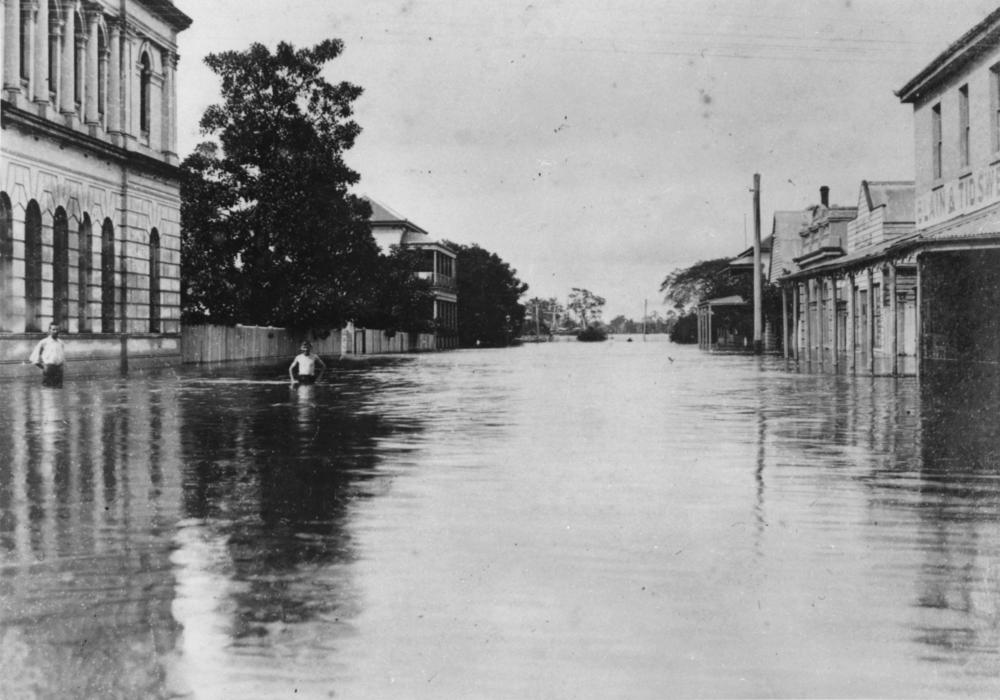
Flooding of the Mary River along Richmond Street, Maryborough, 1893 - photo courtesy State Library of Qld. Image No.: 52544_
Much regret has been expressed in Maryborough at the death of Mr. Douglas Jaffray, in Brisbane last Tuesday. The deceased for very many years held the position of resident engineer at the Teddington waterworks, during which time he constructed an electric plant with steam engine to drive it, in connection with the works. In other directions his services proved invaluable. In his early days the late Mr. Jaffray was a marine engineer, holding a chief's certificate, and was engaged by the A.S.N. Co., of those times. He was a prominent Freemason, and also took great interest in any Scottish movements. The deceased leaves a widow, one son, and three daughters, one of the latter being Nurse Jaffray, of the Maryborough General Hospital. MARYBOROUGH AND DISTRICT. (1913, June 20). The Brisbane Courier (Qld. : 1864 - 1933), , p. 9. Retrieved fromhttp://nla.gov.au/nla.news-article19889719
IN AND AROUND MARYBOROUGH.
(I) The Custom House. (2) Doon Villa bowling-green. (3) Maryborough Bowling Club's bowling-green. (4) Teddington, the source of Maryborough's water supply. (5) On the reservoir, Teddington waterworks. (6) The School of Arts museum. (7) Interior of the exhibition pavilion at show time. Photos, by Fosbrooke.
MRS. E. H. ANDERSON. Mrs. Jane Dix Anderson (wife of Mr. E. H. Anderson, of The Glen), whose death occurred in the Tumbarumba District Hospital last week after a long illness, at the age of 53 years, was a daughter of the late Mr. and Mrs. D. Jaffrey, of Maryborough and Brisbane (Q.), and was born at Maryborough. She was educated at the Girls' Grammar School in Maryborough, and trained for the nursing profession in the General Hospital of that city. After serving for varying terms in Queensland as matron of the Laidley Hospital, the Boys' Grammar School, Southport, and the Goondiwindi Hospital, and a period of private nursing, she came, 17 years ago, to take charge of the Tumbarumba District Hospital. Not quite a year after her arrival there she married Mr. Anderson, and for the last 14 years their home has been Allerthorpe, The Glen, one of the properties of the late Edmund Jowett. Mrs. Anderson is survived by her husband and daughter, Margaret ('Peggy'), one brother, Mr. T. Jaffrey (Ayr, Q.), and two sisters, Mrs. E. Hallstrom and Miss Annie Jaffrey (both of Sydney). Mrs. Andersen, with her husband, was among the best known and most respected residents of the district, and her passing will be regretted by many, while the sincerest sympathy will be extended to her husband and daughter in their sad loss. A large number attended the funeral. The burial took place in the Tumbarumba Cemetery, after a service in St. Andrew's Church, con-ducted by the Rev. F. H. Druery, who also officiated at the graveside. In the church Mr. Druery made graceful reference to the fine character of Mrs. Anderson, and extended the sympathy of the people to her relatives. MRS. E. H. ANDERSON (1937, December 15). Daily Advertiser (Wagga Wagga, NSW : 1911 - 1954), p. 4. Retrieved fromhttp://nla.gov.au/nla.news-article143672144
Previous History Pages:
Marie Byles Lucy Gullett Kookoomgiligai Frank Hurley Archpriest JJ Therry Sir Patrick Gordon Taylor Bowen Bungaree W. Bradley 1788 Journal Midholme Loggan Rock Cabin La Corniche La Corniche II Lion Island Bungan Beach Botham Beach Scarred Trees Castles in the Sand Dame Nellie Melba lunches at Bilgola Spring, 1914 First to Fly in Australia at North Narrabeen Mona Vale Golf Club's Annual Balls Governor Phillip camps on Resolute Beach Ruth Bedford Jean Curlewis Mollie Horseman Charlotte Boutin May Moore Neville W Cayley Leon Houreux Frederick Wymark Sir Adrian Curlewis Bilgola Heron Cove Mullet Creek Shark Point Woodley's Cottage A Tent at The Basin Collin's Retreat-Bay View House-Scott's Hotel Bilgola Cottage and House The First Pittwater Regatta Women Cricketers Picnic Filmed In Pittwater Governor Phillip's Barrenjoey Cairn Waradiel Season The Church at Church Point Gov. Phillip's Exploration of Broken Bay, 2 - 9 March 1788 Petroglyths: Aboriginal Rock Art on the Northern Beaches Avalon Headland Landmarks Steamers Part I Pittwater Aquatic Club Part I Woody Point Yacht Club Royal Motor Yacht Club Part I Dorothea Mackellar Elaine Haxton Neva Carr Glynn Margaret Mulvey Jean Mary Daly Walter Oswald Watt Wilfrid Kingsford Smith John William Cherry George Scotty Allan McCarrs Creek Narrabeen Creek Careel Creek Currawong Beach Creek Bushrangers at Pittwater Smuggling at Broken Bay An Illicit Still at McCarr's Creek The Murder of David Foley Mona Vale Outrages Avalon Camping Ground Bayview Koala Sanctuary Ingleside Powder Works Palm Beach Golf Course Avalon Sailing Club Mona Vale Surf Life Saving Club Palm Beach SLSC Part I - The Sheds Warriewood SLSC Whale Beach SLSC Flagstaff Hill Mount Loftus Pill Hill Sheep Station Hill S.S. Florrie S.S. Phoenix and General Gordon Paddlewheeler MV Reliance The Elvina Florida House Careel House Ocean House and Billabong Melrose-The Green Frog The Small Yacht Cruising Club of Pittwater Canoe and I Go With The Mosquito Fleet - 1896 Pittwater Regattas Part I - Dates and Flagships to 1950 Shark Incidents In Pittwater The Kalori Church Point Wharf Bayview Wharf Newport Wharf Palm Beach Jetty - Gow's Wharf Max Watt Sir Francis Anderson Mark Foy John Roche Albert Verrills Broken Bay Customs Station At Barrenjoey Broken Bay Water Police Broken Bay Marine Rescue - Volunteer Coastal Patrol Pittwater Fire-Boats Prospector Powder Hulk at Towler's Bay Naval Visits to Pittwater 1788-1952 Pittwater's Torpedo Wharf and Range Naval Sea Cadets in Pittwater S.S. Charlotte Fenwick S.S. Erringhi P.S. Namoi S.Y. Ena I, II and III Barrenjoey Headland - The Lessees Barrenjoey Lighthouse - The Construction Barrenjoey Broken Bay Shipwrecks Up To 1900 Barrenjoey Light Keepers Douglas Adrian Ross Newport SLSC 1909 - 1938 Part I Overview North Narrabeen SLSC - The Formative Years Bilgola SLSC - the First 10 years North Palm Beach SLSC A History of Pittwater Parts 1 and 4 Pittwater Regattas - 1907 and 1908 Pittwater Regattas - 1921 - The Year that Opened and Closed with a Regatta on Pittwater Pittwater Regatta Banishes Depression - 1933 The 1937 Pittwater Regatta - A Fashionable Affair Careel Bay Jetty-Wharf-Boatshed Gow-Gonsalves Boatshed -Snapperman Beach Camping at Narrabeen - A Trickle then a Flood Pittwater's Parallel Estuary - The Cowan 'Creek' RMYC Broken Bay Boathouse and Boatshed Barrenjoey Boat House The Bona - Classic Wooden Racing Yacht Mona Vale Hospital Golden Jubilee - A Few Insights on 50 Years as a Community Hospital Far West Children's Health Scheme - the Formation Years The First Scotland Island Cup, Trophy and Race and the Gentleman who loved Elvina Bay Royal Motor Yacht Club Broken Bay NSW - Cruiser Division History - A History of the oldest division in the Royal Motor Yacht Club Royal Motor Yacht Club Broken Bay Early Motor Boats and Yachts, their Builders and Ocean Races to Broken Bay, the Hawkesbury and Pittwater The Royal Easter Show Began As the Royal Agricultural Society of New South Wales The Mail Route to Pittwater and Beyond The Wild Coachmen of Pittwater - A Long and Sometimes Bumpy Ride on Tracks Instead of Roads The Fearless Men of Palm Beach SLSC's Surf Boats First Crews - A Tale of Viking Ships, Butcher Boats and Robert Gow's Tom Thumb 'Canoe' Furlough House Narrabeen - Restful Sea Breezes For Children and Their Mothers From Telegraphs to Telephones - For All Ships at Sea and Those On Land Mona Vale Training Grounds - From Lancers on Horses to Lasses on Transport Courses Fred Verrills; Builder of Bridges and Roads within Australia during WWII, Builder of Palm Beach Afterwards Communications with Pittwater Ferries To Pittwater A History of Pittwater - Part 4: West Head Fortress Pittwater's Lone Rangers - 120 Years of Ku-Ring-Gai Chase and the Men of Flowers Inspired by Eccleston Du Faur Early Pittwater Launches and Ferries Runs Avalon Beach SLSC - The First Clubhouse Avalon Beach SLSC The Second and Third Clubhouses From Beneath the Floorboards at Hyde Park Barracks Bungaree Was Flamboyant Andrew Thompson - 'Long Harry' Albert Thomas Black John Collins of Avalon Narrabeen Prawning Times - A Seasonal Tide of Returnings Oystering in the Pittwater Estuary - Oyster Kings and Pearl Kings and When Not to Harvest Oysters Yabbying In Warriewood Creeks Eeling in Warriewood's Creeks (Includes A Short History of community involvement in environmental issues/campaigns in and around Narrabeen Lagoon - 1974 to present by David James OAM) Eunice Minnie Stelzer - Pittwater Matriarchs Maria Louisa Therry - Pittwater Matriarch Katherine Mary Roche - Pittwater Matriarchs Sarah A. Biddy Lewis and Martha Catherine Bens Pittwater Matriarchs Pittwater's New Cycle Track of 1901 Manly to Newport The Rock Lily Hotel Barrenjoey House The Pasadena Jonah's St Michael's Arch The First Royal Visitor to Australia: the Incident at Clontarf March 12th, 1868 Pittwater: Lovely Arm of the Hawkesbury By NOEL GRIFFITHS - includes RMYC Wharf and Clareville Wharf of 1938 + An Insight into Public Relations in Australia George Mulhall First Champion of Australia in Rowing - First Light-Keeper at Barranjuey Headland Captain Francis Hixson - Superintendent of Pilots, Lights, and Harbours and Father of the Naval Brigade The Marquise of Scotland Island The First Boat Builders of Pittwater: the Short Life and Long Voyages of Scotland Island Schooner the Geordy Boat Builders of Pittwater II: from cargo schooners and coasters to sailing skiffs and motorised launches The Currawong: Classic Yacht The Riddles of The Spit and Bayview/ Church Point: sailors, boat makers, road pavers winning rowers VP Day Commemorative Service 2015 – at Avalon Beach RSL Cenotaph: 70th Anniversary Captain T. Watson and his Captain Cook Statues: A Tribute to Kindness Pittwater Reserves: The Green Ways; Hordern or Wiltshire Parks to McKay Reserve – From Beach to Estuary Pittwater Reserves, The Green Ways: Clareville Wharf and Taylor's Point Jetty Pittwater Reserves: The Green Ways Bilgola Beach - The Cabbage Tree Gardens and Camping Grounds - Includes Bilgola - The Story Of A Politician, A Pilot and An Epicure by Tony Dawson and Anne Spencer Pittwater Reserves - The Green Ways: Mona Vale's Village Greens a Map of the Historic Crown Lands Ethos Realised in The Village, Kitchener and Beeby Parks Pittwater Reserves: The Green Ways; Bungan Beach and Bungan Head Reserves: A Headland Garden Early Pittwater Paddlers, Oarsmen, Rowers and Scullers: The Green Family Elanora - Some Early Notes and Pictures The Stewart Towers On Barrenjoey Headland Early Pittwater Paddlers, Oarsmen, Rowers and Scullers: The Williams Family Early Cricket in Pittwater: A small Insight Into the Noble Game from 1880's On The Pacific Club's 2016 Carnival in Rio Fundraiser for Palm Beach SLSC Marks the 79th Year of Support Bert Payne Park, Newport: Named for A Man with Community Spirit Early Pittwater Paddlers, Oarsmen, Rowers and Scullers: The Fox Family Surf Carnivals in February 1909, 1919, 1925, a Fancy Dress Rise of Venus and Saving Lives with Surfboards Early Pittwater Paddlers, Oarsmen, Rowers and Scullers: The Paddon Family of Clareville Mermaid Basin, Mona Vale Beach: Inspired 1906 Poem by Viva Brock Early Pittwater Schools: The Barrenjoey School 1872 to 1894 The Royal Easter Show and 125th Celebration of the Hawkesbury Agricultural College: Farmers Feed Us! The Newport School 1888 to 2016 Pittwater's Ocean Beach Rock Pools: Southern Corners of Bliss - A History The Royal Botanical Garden Sydney Celebrate 200 Years in 2016 The Porter Family of Newport: Five Brother Soldiers Serve in WWI Church Point and Bayview: A Pittwater Public School Set on the Estuary The Basin, Pittwater: A Reprise: Historical Records and Pictures Lighthouse Keepers Cottages You Can Rent in NSW - Designed or Inspired by Colonial Architect James Barnet: Includes Historic 'Lit' Days records Bayview Days Ships Biscuits - the At Sea Necessity that Floated William Arnott’s Success Mona Vale Public School 1906 to 2012 St Johns Camden: 176th And 167th Anniversaries In June 2016 - Places To Visit Narrabeen Lagoon And Collaroy Beachfront: Storms And Flood Tides Of The Past Avalon Beach Public School - A History Muriel Knox Doherty Sir Herbert Henry Schlink Shopping And Shops In Manly: Sales Times From 1856 To 1950 For A Fishing Village